STORIES FROM HAWAIIAN AIRLINES

HOME BREAK Longboarding perfection at Queens in Waikīkī POWER MOVES HIjack reps Hawai‘i at the US national breakdancing championships THE DRAGSTER KING When Roland Leong’s The Hawaiian took drag racing by storm
V26 N 0 1 DECEMBER - JANUARY 2023


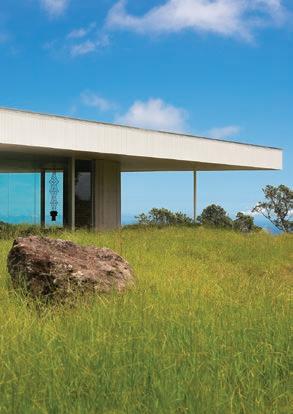
STORY
STORY BY PETER VON BUOL
PHOTOS BY HANA ASANO 42 / The Descendants The family of renowned kumu hula Edith Kanaka‘ole carries forward the Hawaiian cultural renaissance she helped to inspire
STORY BY DW GIBSON
PHOTOS BY ELYSE BUTLER 52 /
Earth Whisperer When the planet speaks, geophysicist Rhett Butler listens
STORY BY LARRY LIEBERMAN
PHOTOS BY ELYSE BUTLER
STORY BY ERIC STINTON
PHOTOS BY ADAM AMENGUAL
74 / Longboard Idyll The regulars at Queens find surfing perfection
WORDS BY BEAU FLEMISTER
PHOTOS BY TOMMY PIERUCKI
86 / Remote Work
Architect Craig Steely is creating modern homes amid the lava flows and ‘ōhi‘a forests of Hawai‘i Island
STORY BY TIMOTHY A. SCHULER
PHOTOS BY VINCENT BERCASIO
100 / Visions of Atolls
Floyd Takeuchi has spent a lifetime chronicling the people and islands of Micronesia
STORY BY STU DAWRS
PHOTOS BY FLOYD TAKEUCHI

STORY
114
Events Calendar
Island by Island 143 / Hawaiian Airlines Information 160 / PAU HANA Where the Streets
Long Names
/
&
Have
BY
PHOTO
ISLAND INTELLIGENCE 16 / The Garden of Remembering STORY BY LESA GRIFFITH PHOTOS BY KENNA REED 18 / Worldwide Voyagers
BY
LARRY LIEBERMAN
BY ERIKA RICH
STORY
KATHY MUNENO
BUTLER 20 / The Art of Life
BY MALANIE MCLELLAN 22 / Sewn to Last
BY KATIE YOUNG YAMANAKA PHOTOS BY ANDREW RICHARD HARA Table of Contents V26 N 0 1 DECEMBER - JANUARY 2023 02 24
Floral Buffet STORY BY JACK TRUESDALE 26
Everything but the Scales
PHOTOS BY ELYSE
STORY
STORY
/
/
BY
DEPARTMENTS
FEATURES 30
Hawaiian
MARI TAKETA PHOTO BY DANA EDMUNDS
&
/ Life in the Fast Lane Drag racer Roland Leong is the original flyin’
The
62
For b-boy
breakdancing is part sport, part art and all aloha
/ Breaking Ground
Jack Rabanal,
86


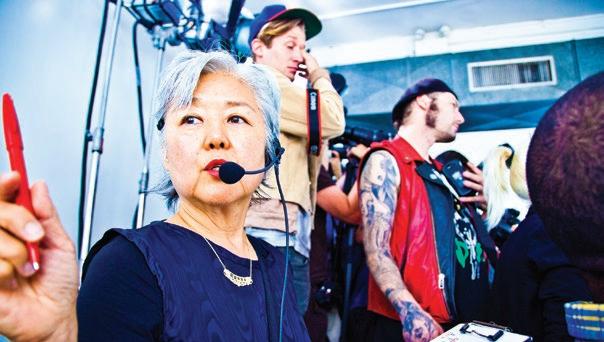 BREAKING GROUND / Meet Jack Rabanal, a.k.a. HIjack, the “b-boy” who reps Hawai‘i at breakdancing competitions in the Islands and abroad. PHOTO BY ADAM AMENGUAL
BREAKING GROUND / Meet Jack Rabanal, a.k.a. HIjack, the “b-boy” who reps Hawai‘i at breakdancing competitions in the Islands and abroad. PHOTO BY ADAM AMENGUAL
04 tv Find more hana hou! videos, stories and events on nmgnetwork.com Instagram: @hanahoumag Facebook: /HanaHouMagazine
ALOHA GOES BOTH WAYS / A video series featuring locals who exemplify the aloha spirit both at home and abroad. PHOTO BY ELI SCHMIDT

PUBLISHER & CEO
Jason Cutinella
VP BRAND DEVELOPMENT
Ara Laylo
GLOBAL EDITORIAL
DIRECTOR
Brian McManus
EDITOR
Michael Shapiro
PHOTO EDITOR
Matt Mallams
DESIGNERS
Nico Enos
Taylor Niimoto
Eleazar Herradura
VP FILM
Gerard Elmore
FILMMAKERS
Blake Abes
Romeo Lapitan
Erick Melanson
VIDEO EDITOR
Jhante Iga
BRAND & PRODUCTION MANAGER
Kaitlyn Ledzian
BRAND PRODUCTION COORDINATOR
Taylor Kondo
HAWAIIAN CULTURAL ADVISER
Kahōkū Lindsey-Asing
OPERATIONS
PARTNER/GM —HAWAI‘I
Joe V. Bock
VP ACCOUNTS RECEIVABLE
Gary Payne
CREATIVE SERVICES MANAGER
Sheri Salmon
OPERATIONS MANAGER
Sabrine Rivera
ADVERTISING
ADVERTISING DIRECTOR
Simone Perez simone@NMGnetwork.com
DIRECTOR OF SALES
Tacy Bedell tacy@NMGnetwork.com
VP SALES
Mike Wiley
VP GLOBAL BRAND STORYTELLING
Marc Graser
VP INTEGRATED MARKETING
Francine Beppu
MARKETING & ADVERTISING EXECUTIVE
Courtney Asato
ACCOUNT EXECUTIVE
Nicholas Lui-Kwan
CONTACT
EDITORIAL INQUIRIES editors@NMGnetwork.com
SALES INQUIRIES sales@NMGnetwork.com
CONTRIBUTORS
Kirk Lee Aeder
Adam Amengual
Vincent Bercasio
Peter von Buol
Elyse Butler
Stu Dawrs
Dana Edmunds
Beau Flemister
DW Gibson
Lesa Griffith
Andrew Richard Hara
Larry Lieberman
Malanie McLellan
Kathryn Muneno
Tommy Pierucki
Kenna Reed
Timothy A. Schuler
Eric Stinton
Mari Taketa
Jack Truesdale
Katie Young Yamanaka
Published by: NMG Network 36 N. Hotel St., Ste. A Honolulu, HI 96817
©2022-2023 by NMG Network, LLC. Contents of Hana Hou! are protected by copyright and may not be reproduced without the expressed written consent of the publisher. Hana Hou! assumes no liability for products or services advertised herein.
AMERICAN SĀMOA (684) 699-1875
SOUTH KOREA (82) 2-775-5552
TAHITI (689) 40-866-000
CONSUMER AFFAIRS
HawaiianAirlines.com/CAO
BAGGAGE INQUIRIES
1-866-389-6654
Monday-Sunday, 8:00am - 4:30pm HST
H awaiian M iles
For information on our frequent flyer program, please contact our HawaiianMiles Service Center
3375 Koapaka Street, G-350 Honolulu, HI 96819
Phone: 808-835-3700
Fax: 808-835-3690
Mailing Address: PO Box 30008 Honolulu, HI 96820
For questions related to travel, visit us online at HawaiianAirlines.com or contact us at any of the following numbers:
UNITED STATES / CANADA
1-800-367-5320
Monday-Sunday, 24 hours Text 38285
Monday-Sunday, 5:00am - 11:00pm HST
AUSTRALIA (61) 1-800-955-912
CHINA (86) 10-6502-6766
JAPAN
0570-018-011 Monday-Friday
NEW ZEALAND (64) 0800-449-415
Monday-Friday, 7:00am - 4:30pm HST 1-877-HA-MILES or 1-877-426-4537
HAWAIIAN AIR CARGO INQUIRIES
1-877-422-2746
HawaiianAirCargo.com

ON THE COVER
The Sweet Spot
Kaniela Stewart hangs ten at Queens, Waikīkī
06 V26 N 0 1 DECEMBER - JANUARY 2023
PHOTO BY TOMMY PIERUCKI
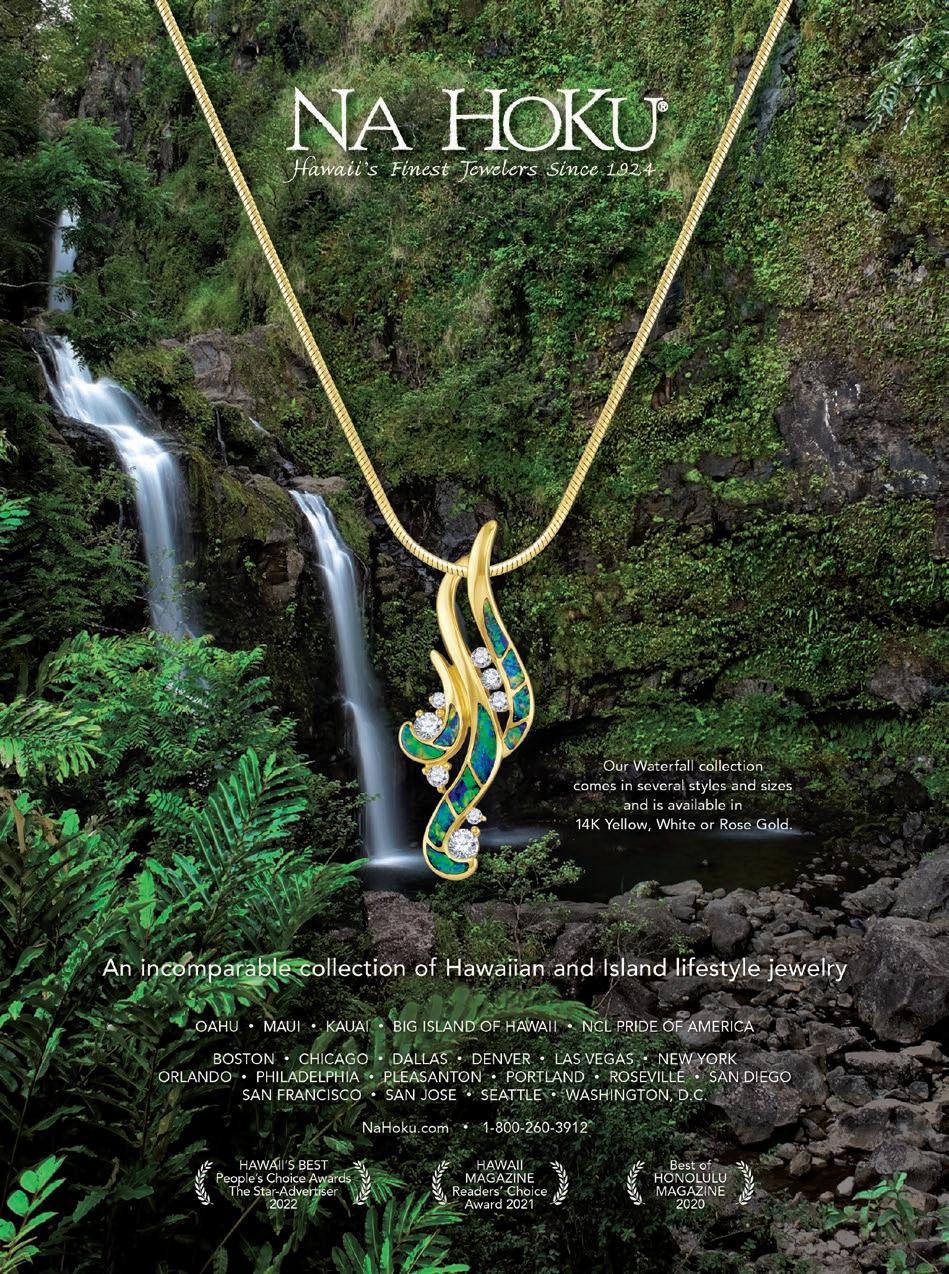

“I find it so incredible when I get to meet and photograph someone who has dedicated their whole life to one craft,” says Hana Asano, who shot “Life in the Fast Lane” about drag racer Roland Leong for this issue. “Roland was one of the only Asian American racers in his time, and I’m inspired by how he embraced himself as a racer and a Hawaiian, during such a hard era to do so. He opened his doors to me with such kindne ss and ease, which made photographing him a joy.” Asano was born in Los Angeles to Japanese immigrant parents who came to the United States in hopes of becoming jazz musicians. Like her parents before her, she remains in search of adventure, live music and fun waves.

“Architecture has a well-earned reputation for being pretentious, which is why hanging out with Craig Steely is so refreshing,” says Timothy A. Schuler, who wrote “Remote Work” for this issue. “Craig’s work is full of big ideas, but it’s also playful. There are moments in some of his houses that make me laugh out loud.” Tim is an award-winning magazine journalist whose writing focuses on the relationship between the built and natural environments.
A contributing editor at Landscape Architecture Magazine, Tim’s writing has also appeared in Metropolis, Dwell, Bloomberg CityLab and Places Journal, among others. His essay “The Middle of Everywhere” was included on a list of the most notable science and nature writing in The Best American Science and Nature Writing 2020. He recently left Hawai‘i for the tallgrass prairies of Kansas.

“I started shooting the Waikīkī longboarding scene back in 2018 when I first picked up a camera and water housing,” says Tommy Pierucki, who shot “Longboard Idyll” for this issue. “At the time I had only really observed amateur surfing, so once I started spending more time in Waikīkī, I started paying more attention to the nuances of using the whole length of a longboard and how some people do it with so much style. I remember seeing Arthur ‘Toots’ Anchinges make some very difficult maneuvers look ridiculously easy. From getting the gear, swimming for countless hours, sorting through the images, editing them and sharing them with the world … this is something I truly love doing, and I look forward to many more years in the water.” Tommy is a surf photographer and filmmaker whose work has appeared in Pacific Longboarder, HONOLULU and FreeSurf, and has been featured by Roxy, RVCA, Billabong and more.

“What struck me about breakdancing is its inherent tension between art and sport,” says Eric Stinton, who wrote “Breaking Ground” for th is issue. “HIjack is equal parts artist and athlete. It was fascinating to see him navigate those identities, to see how they inform his approach to dancing.” Breaking has a long history in Hawai‘i, and Honolulu-born HIjack is the culmination of that history, at once an original and an OG. “HIjack understands the historical intersection he’s in, standing on the shoulders of Hawai‘i’s pioneers while also mentoring the next generation of Island talent.” Stinton is from Kailua, O‘ahu, and has written for various outlets in print and online. His work has been recognized by Longreads, the Society of Professional Journalists and the Best American Sportswriting anthology.
Contributors
Hana Asano Timothy A. Schuler
08
Tommy Pierucki Eric Stinton

Connecting Flight
BY PETER INGRAM , PRESIDENT AND CHIEF EXECUTIVE OFFICER, HAWAIIAN AIRLINES
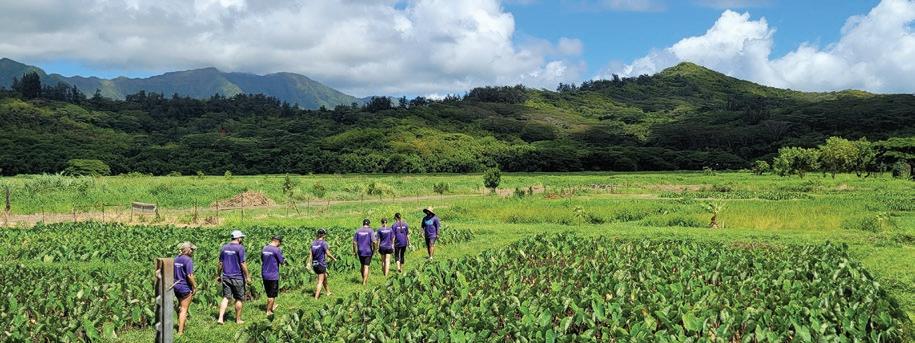
Supporting our land stewards
If you head north along Kamehameha Highway toward He‘eia State Park on O‘ahu, you’ll see a modest red metal gate on the mauka, or mountain, side of the road. There you’ll find a simple sign bearing the name Kāko‘o ‘Ōiwi
Pass through the gate and before you is a lush expanse of land that stretches to the foot of the Ko‘olau Mountains. Spread across the swath are plots of wetland taro, sweet potato, fiddlehead fern and turmeric, along with breadfruit and banana trees. An army of goats stands guard over the crops while native birds patrol the fields.
The area beyond the gate is known as Hoi. It once supported more than three hundred acres of wetland taro and at least three commercial poi mills. For the past twelve years, Kāko‘o ‘Ōiwi has led efforts to revive productivity of the wetland and expand economic opportunities for family farmers in the region. In 2010, the nonprofit organization secured a 38-year lease from the State of Hawai‘i to fulfill a community-driven vision for the 405acre site: Perpetuate the heritage, values
and cultural and ecological knowledge of traditional farming through the restoration of the food-producing lands and waters of He‘eia.
Kāko‘o ‘Ōiwi has so far returned productivity to several acres of irrigated terraces for taro production and cleared more land for diversified agriculture. Hundreds of Hawaiian Airlines Team Kōkua volunteers and their families have been part of those efforts since 2011. They’ve joined workdays to clear waterways and farmland, harvested crops and stood knee-deep in mud to weed out invasive species from taro patches. When Kāko‘o ‘Ōiwi was ready to build a community facility to process crops grown in the region, we pledged our support.
In August 2022, the Hawaiian Airlines Foundation awar ded the nonprofit a grant to fund construction of the four-thousand-square-foot agriculture wash and pack station, outfitted with washing tumblers and washtubs that family farmers can access to process their crops for retail sale and wholesale distribution.
“One of the really exciting things about working with an organization like Kāko‘o ‘Ōiwi, which you’ve built a partnership with over the years, is
to be able to evolve and get to a point where you can do more,” explains Debbie Nakanelua-Richards, director of community and cultural relations at Hawaiian Airlines.
The project spoke to us for several reasons: It helps Kāko‘o ‘Ōiwi continue its mission of land stewardship, agricultural sustainability and food security—issues that are important for the state and the well-being of our communities. It also removes one of the impediments faced by small farmers— having access to a facility where they can prepare their crops to sell to stores, restaurants and hotels and generate income for their households.
At Hawaiian, we’ve committed to locally sourcing 40 percent of the food and beverage products for our Hawai‘i-based operations by 2025. We want to do that by leveraging our buying power to help expand the market for local products and diversify our economy. Supporting Hawai‘i’s farmers and land stewards is a critical part of that effort.
From our ‘ohana to yours,
10
The Hawaiian Airlines Foundation was established in 2014 to support initiatives like Kāko‘o ‘Ōiwi, which is expanding economic opportunities for Windward O‘ahu farmers.
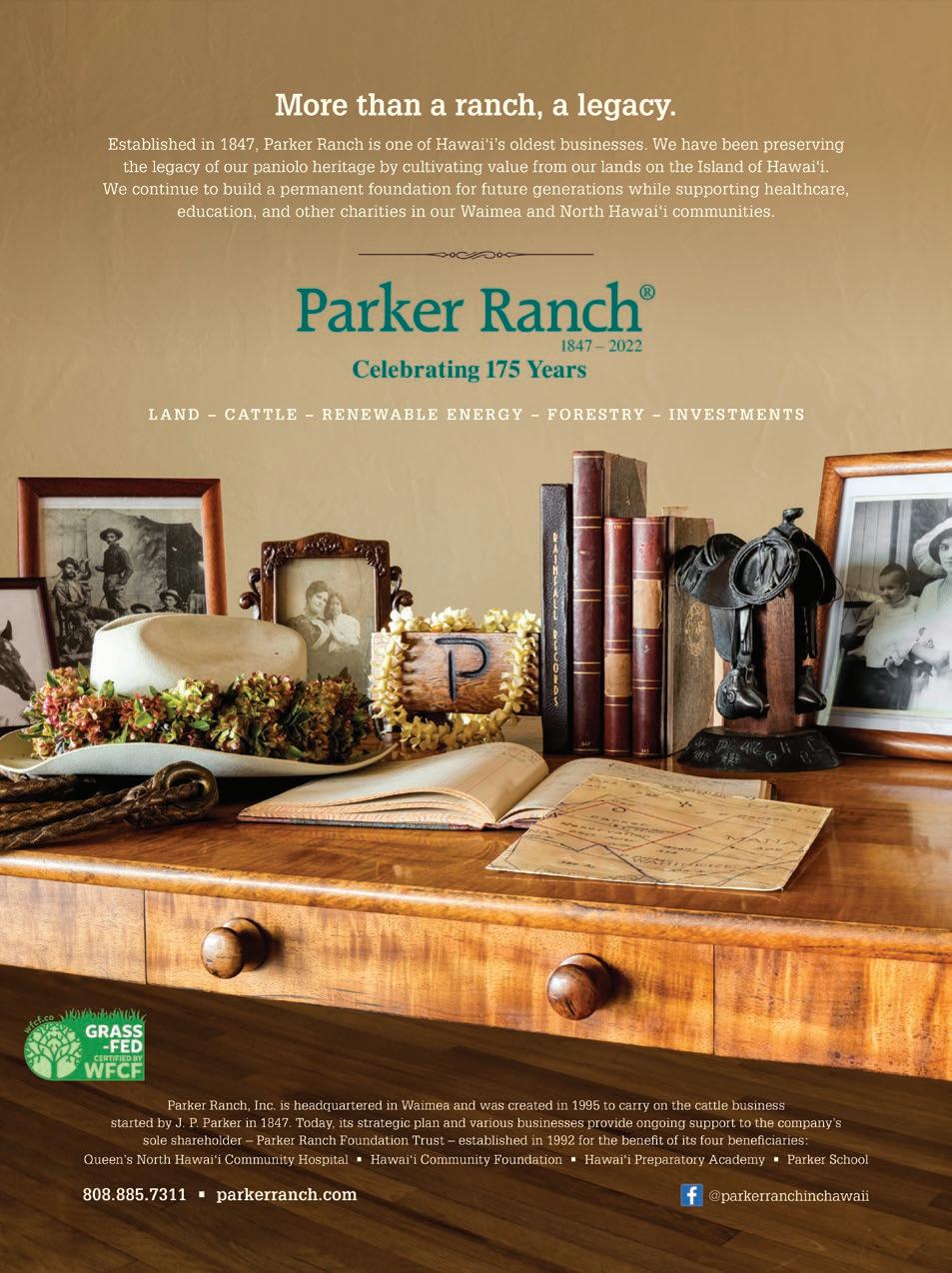
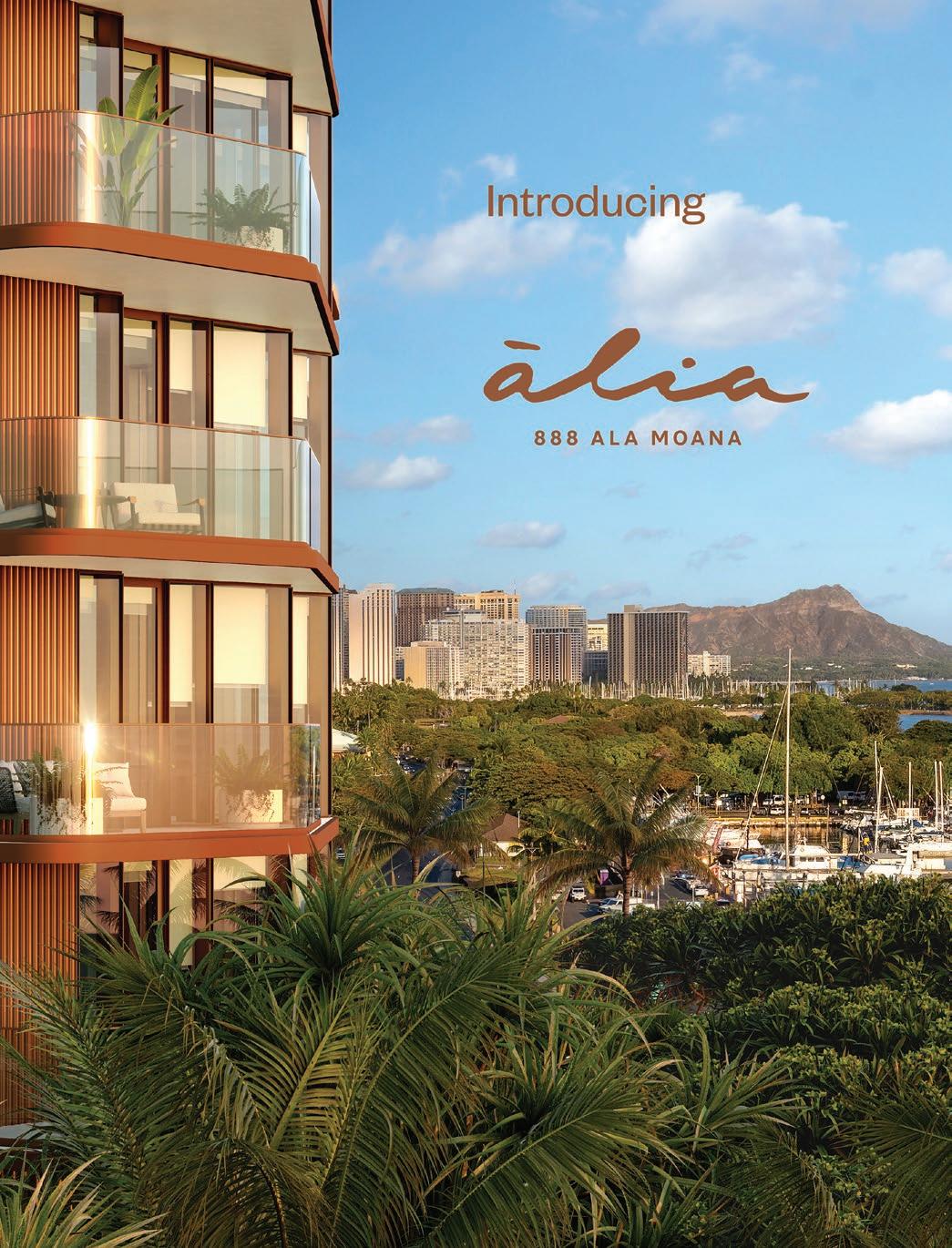



island intelligence
STORY BY LESA GRIFFITH
The Garden of Remembering
When British artist Rebecca Louise Law’s installation Awakening opened at the Honolulu Museum of Art in September, many were moved to tears.
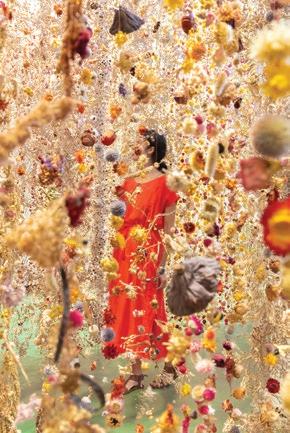

Being immersed among more than a million pieces of dried, suspended flora seems to awaken something in people.
Coming from a long line of gardeners on her paternal side (her father was head gardener of Anglesey Abbey in Cambridge) and of artists on her mother’s side, Law was almost predestined to “paint” with flowers. She has created installations all over the world, from Kuala Lumpur to Athens. Entering one is like walking through a hanging garden: Some strands are wispy and delicate, others muscular and sculptural, with suspended lotus seed pods and thick bunches of roses. Such installations are demanding to create. Law spent days foraging in O‘ahu’s heat for the Honolulu exhibition, on display until September 10, 2023. She climbed ladders for hours in galleries, attaching lengths of flower-
dotted wire to a scaffold. Volunteers and staff collected thousands of flowers, pods and branches from O‘ahu’s botanical gardens; the museum also asked for people to donate flowers, which were then dried and frozen. Volunteers, under the tutelage of Law’s gregarious husband, Andrew, strung the plants on copper wire using techniques the couple devised over years of trial and error. “The residents of Hawai‘i need little instruction whilst helping to wire flowers,” Law says, referring to the Islands’ lei-making traditions.
The locally harvested flora joins strands from Law’s prior installations, which she has sculpted and re-sculpted over the past eighteen years. “Once this artwork is de-installed, it will be packed and sent to the next exhibition,” Law says. “I now have over a million flowers in my permanent collection.” Even so, she still finds new sources of inspiration.
While Law has created installations in other tropical locales, she had never used bougainvillea, which she fashioned into thick ropes. Her favorite new discovery is the seed of the quipo tree, native to Central and South America, gathered from Foster Botanical Garden in Honolulu. “It has made this artwork glow and quiver in the breeze,” she says.
Law, who makes her home in rural Wales, hopes her work will remind us of “the love we have for each other and this Earth. The little time we have is swallowed up by commercial distractions. Treasuring all we have on this Earth is at the core of my artworks. I treasure through preservation—I believe each natural element has so much to give until it turns to dust and returns to the earth.”
O‘AHU INTELLIGENCE
PHOTOS BY KENNA REED
HONOLULUMUSEUM.ORG 16
For Rebecca Louise Law’s stunning new installation at the Honolulu Museum of Art, the British artist has collected, dried and strung more than a million pieces of flora (seen above left and right), including many local and native Hawaiian species. Law hopes that viewers wandering among the columns will be reminded of “the love we have for each other and this Earth,” she says.
 STORY BY KATHY MUNENO PHOTOS BY ELYSE BUTLER
STORY BY KATHY MUNENO PHOTOS BY ELYSE BUTLER
Every voyaging wa‘a (canoe) has a navigator. The Wa‘a Honua (“canoe for Earth”) web site strives for ten million navigators—if virtually.

Launched last April, Wa‘a Honua is the Polynesian Voyaging Society’s digital platform, a resource to share the achievements of Polynesian voyaging, inspire future navigators and spread the society’s message of mālama honua, or caring for Earth.
PVS formed fifty years ago to build Hōkūle‘a—the first voyaging canoe to be constructed in Hawai‘i in six centuries—and sail it to Tahiti. The crew used only traditional wayfinding, navigating without modern instruments, proving that early voyagers had the ability to find and settle islands flung across thousands of miles of ocean. The successful voyage from Hawai‘i to Tahiti in 1976 helped spark a wave of cultural pride, both in Hawai‘i and throughout Polynesia. Since then Hōkūle‘a and its
sister canoe, Hikianalia, have traveled hundreds of thousands of miles; they have recently sailed around the world.
After visiting more than three hundred communities across the globe, PVS wanted to share its successes with a wider audience. Senior navigator and PVS CEO Nainoa Thompson calls the platform the PVS’ “third canoe. It does what PVS’ two canoes can’t,” he says, “reaching millions with its mission of stopping extinction by voyaging, navigating and teaching, and creating momentum for global change.”
Wa‘a Honua is still growing, but it already has partners such as the University of Hawai‘i, Arizona State University, Bishop Museum, Nakupuna Foundation and Kamehameha Schools. The platform, which hosts videos,
lessons, profiles and resources, “can be a catalyst to bring people from around the world together,” says Dean Tomita of Kamehameha Schools, which provides the voyaging and wayfinding education resources, lesson plans and activities accessible on Wa‘a Honua. In 2023, Wa‘a Honua will be a portal for those who want to follow Hōkūle‘a and Hikianalia on Moananuiākea, an ambitious threeyear journey around the Pacific Rim.
Wa‘a Honua gives “a voice to diverse people around the world,” says Thompson, “whether they are scientists, indigenous peoples, policy makers, educational institutions—all those who share the values of caring for Earth and the future of our children.”
WAAHONUA.COM
O‘AHU INTELLIGENCE Worldwide Voyagers 18
The Polynesian Voyaging Society’s canoe Hōkūle‘a (seen above at left, also on pages 14-15) returns to Hawai‘i in 2017 after sailing around the world, accompanied by her sister canoe, Hikianalia (at right).
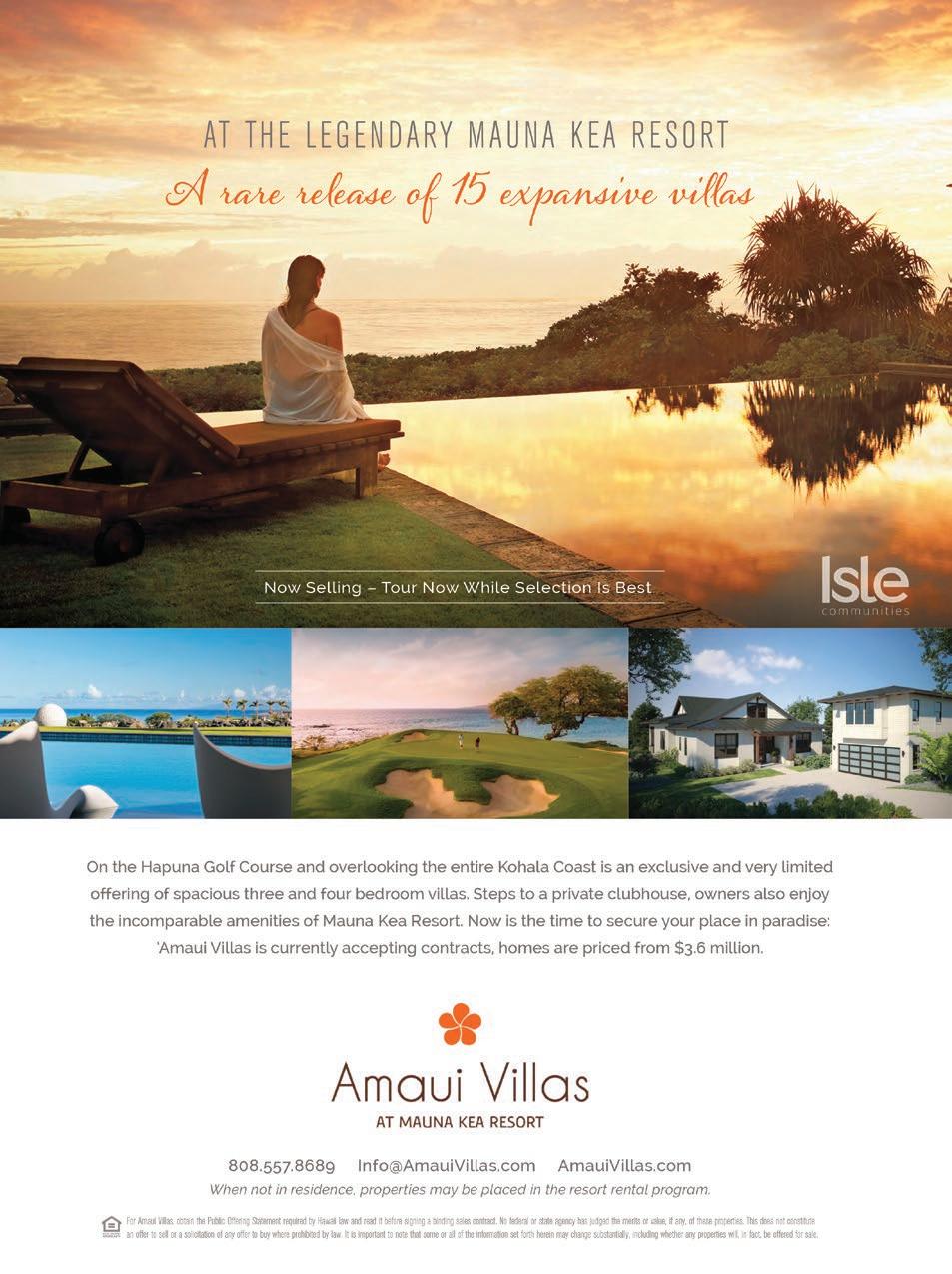
The Art of Life
Chris Ritson aims to grow as an artist—literally.

Turned off by the environmental impact of traditional art materials, Ritson set out to make art that “contributes positively to the environment, not harms it.”
Growing up close with his grandfather, a particle physicist, and influenced by his mother, who “was very into art,” Ritson’s sensibility was shaped by “an appreciation for aesthetics and
the subtle forces of nature,” he says. He started by growing crystals, but while they were beautiful, he wasn’t satisfied. Intrigued by working with living things, he searched his own backyard in the lush, mountaintop jungle of Tantalus above Honolulu and discovered mushrooms. The more he explored, the more they fascinated him. “Mushrooms are some of the biggest organisms
in the world, with networks that can span miles underground, connecting valleys and forests,” he says. “They make complex, weblike threads called mycelium, by which they communicate via electrical impulse, like a brain. Genetically, they’re closer to animals than to plants.”
They are also beautiful. Working in a sterile lab he built himself, Ritson takes a sample of mushroom and places it in a Petri dish with a gel of seaweed and sugar, then adds it to blocks of sawdust he makes from invasive species of trees. The blocks become canvases; when the mushrooms fruit, they create their own masterpieces, like the bright orange fans of a polypore spreading like ripples of water. Ritson’s most recent forage, a brown mushroom he thought was Ganoderma australe, the southern bracket fungus, turned out to be a species yet unidentified by science. As mushrooms grow, he monitors their development for contamination by other fungi or bacteria, which can devastate months of work in one day. Each of his fungal art pieces takes four to five months to complete.
Sometimes Ritson uses directs airflow to influence the growth. Most recently, he places face-shaped frames, fake eyes and teeth for the mushrooms to grow over and around, eerily fleshlike in texture and appearance. “I like the temporal nature of adding portraiture to it,” he says. While Ritson can embalm the finished pieces in wax to make them permanent, most are destined to become compost, which he reuses.
“Typically, art is used to communicate the intent of the artist. But with generative art, the autonomous system of the material becomes the creator, not the artist’s decisions. Ultimately, the credit goes to the organism.”
INSTAGRAM.COM/CHRISRITSON
STORY BY MALANIE MCLELLAN O‘AHU INTELLIGENCE
20
Artist Chris Ritson created this living work, “Mushroom Picture,” by infusing a block of sawdust with a bracket fungus, Pycnoporus sanguineus, collected near his home in the rainforest of Tantalus, above Honolulu.
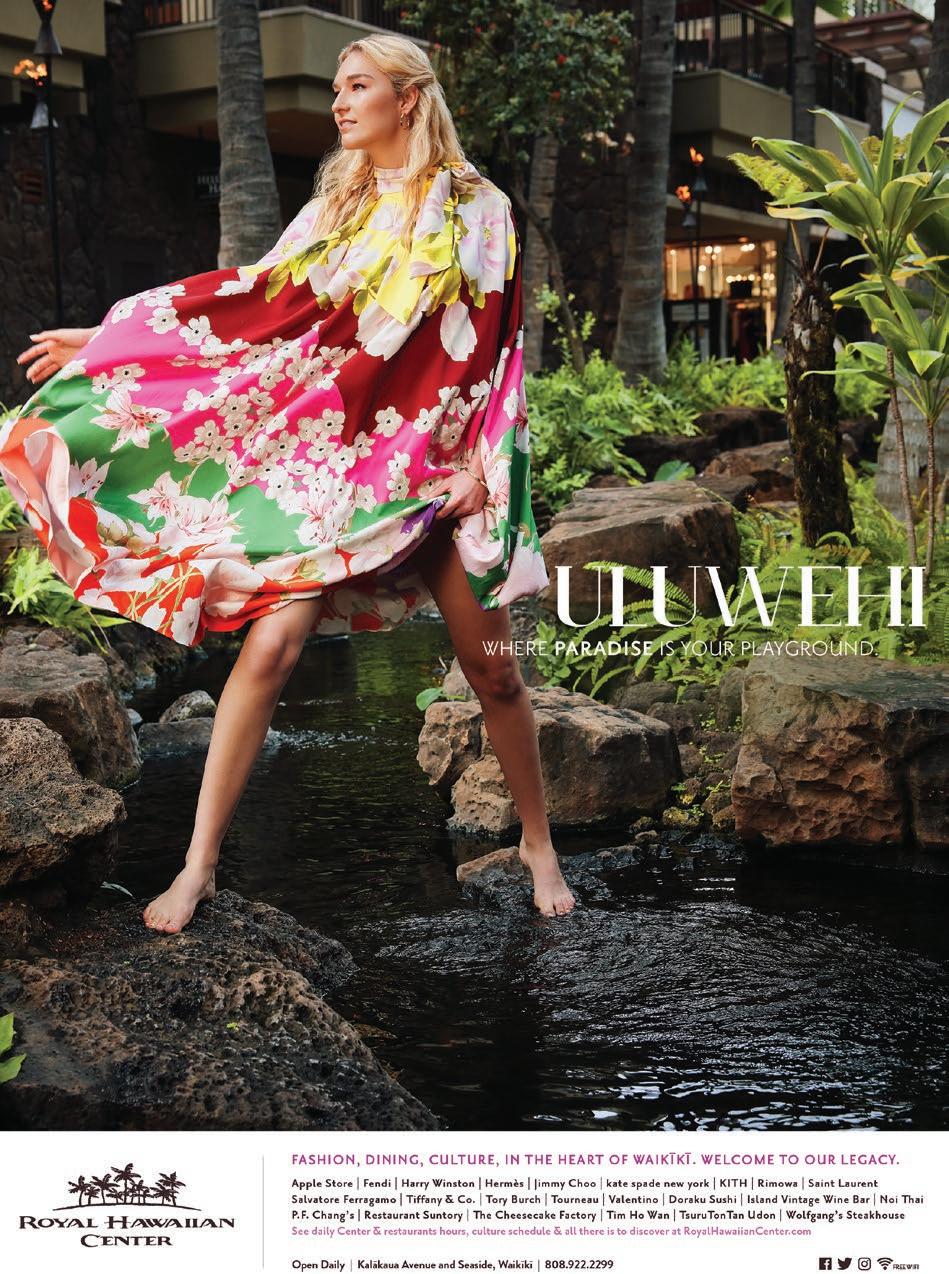 STORY BY KATIE YOUNG YAMANAKA
STORY BY KATIE YOUNG YAMANAKA
Sewn to Last
Jessica Cruzan had been making high-end leather handbags in New Mexico, but when she moved to Hawai‘i Island, she quickly learned what Island residents know all too well: Humidity, moisture and leather do not mix.


The rain and damp of East Hawai‘i quickly turned Cruzan’s beautiful leatherwork green with mold.
Looking to use her creativity and impressive sewing skills—her resume includes designing inflatable mascot costumes and sewing spacesuits for NASA’s Mars habitat on Mauna Loa— Cruzan began searching for quality materials that would hold up. One day she wandered into a fabric store in Waimea. “They had coasters made out of cork fabric, which I’d never seen before. It felt like leather,” she says. “The cork is shaved paper-thin and adhered to a fabric backing, but it’s not like what you think of when you think of cork—it’s not brittle. It’s really soft, and visually it has more depth to it than flat fabric.”
It took Cruzan months to source high-quality cork fabric from Portugal,
the world’s largest producer. Cork fabric, just like wine corks, is made from the bark of a type of oak known for its longevity and its ability to regenerate. Cork resists abrasion; it’s also fire resistant and impermeable to liquid. It’s naturally antimicrobial, too, so it repels mold and mildew.
Cruzan learned everything she knows about sewing from her aunts, who were both union seamstresses at the University of Illinois Krannert Center for the Performing Arts. Cruzan helped them make period costumes before embarking on her own sewing adventures, which included all sorts of odd jobs, she says. She created the inflatable mascots for movie premieres and Six Flags theme parks. She did alterations at David’s Bridal and made saddlebags for Harley-Davidson bikes.
Before coming to Hawai‘i she nearly gave up sewing to become an attorney advocating for the deaf. But Island life inspired her to return to the craft. “I think there is much more opportunity here to really be creative,” she says.
Cruzan now sources cork fabric for her business, Sew Da Kine, from Spain, in thirty-two different colors and printed with her own designs. There’s no lack of demand; she works thirteenhour days to keep up. “Cork has kind of exploded as a textile now because it’s a sustainable product,” she says. That’s true in more ways than one: “I’ve seen how my bags hold up over time. Repeat customers are still wearing the bags they bought years ago.”
HAWAI‘I ISLAND INTELLIGENCE
PHOTOS BY ANDREW RICHARD HARA
SEWDAKINE.COM 22
Seamstress Jessica Cruzan of Sew Da Kine (seen above left) unrolls a bolt of cork fabric imported from Spain. Unlike traditional textiles and leathers, cork is naturally moisture- and microbe-resistant, making it the perfect material to withstand Hilo’s purse-eating climate.
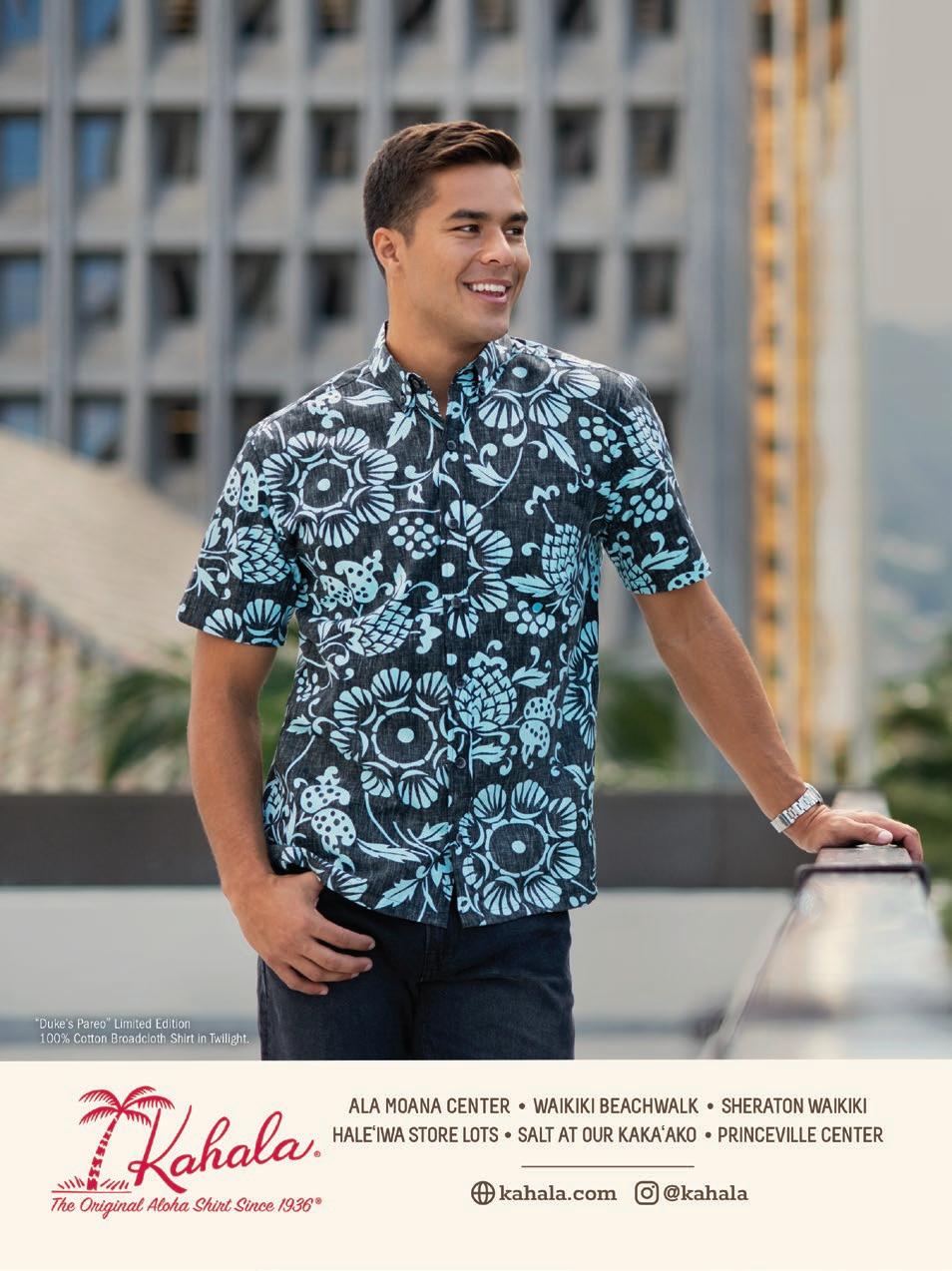
V
STORY BY JACK TRUESDALE
Those in need of a custom flower bouquet on Kaua‘i—brides-to-be, lovestruck high school boys—are known to hit the Pua Bar.
Despite its name, the island’s one-year-old boutique bloom shop is BYOB (build your own bouquet), though depending on the occasion, you can also bring your own bridesmaids or—why not?—best man.
The shop, a cozy white-walled cottage on the historic Kilohana Plantation, drips with flowers, fresh and dried. A cloud of baby’s breath hangs over Pua Bar co-founder Tasha Rames as she points out the bouquet builder’s palette: anthuriums from Hawai‘i Island, a protea from Maui (“the big pink one”), ranunculus (“the pink guys”) and foxtail (“the big tall funky one”).
Rames, who was born and raised on Kaua‘i, met her business partner, Haylee Kam, in flight attendant school for Hawaiian Airlines six years ago. Though they have reduced their flying hours lately, their extensive traveling inspired the Pua Bar concept (“pua” is Hawaiian for flower). “We both love flowers,” Rames says. “We have been to a bunch of flower markets in Seattle, Japan, Sydney, where you can just go buy flowers and take cute pictures with them. We saw a need for something like that here on Kaua‘i.” When the pandemic hit, the duo saw it as an opportunity to build the business.
Kam can trace the shop’s roots to her grandmother’s puakenikeni tree on Kaua‘i’s north shore. Ever since she was a girl, Kam has plucked the tree’s pastel orange blossoms and strung them in her grandmother’s yard. Neighborhood kids used to gather at the house, where Kam’s grandmother taught them to make lei, “like a language you just learn,” Kam says. “Growing up, we never showed up anywhere empty-handed. The first thing that my grandmother would have us do is go outside, pick flowers and make lei.”
Consider Kam fluent now: For a recent parade the mayor of Kaua‘i needed florals, and so did his horse. For the beast of burden, Kam, along with renowned lei maker Kathy Butler, made her largest lei yet. “It was eighty pounds,” she says. “It was mental. It took us two days and a whole team of people to put it together.”
Such is the kuleana (responsibility) of the island’s new local lei shop, conveniently close to where everybody on the island goes: “We’re right across the street from Costco,” Kam says with a grin.

THEPUABAR.COM
KAUA‘I INTELLIGENCE
24
Floral Buffet

 STORY BY MARI TAKETA
STORY BY MARI TAKETA
Everything but the Scales
Goro Obara was already a dedicated ‘ahi enthusiast when he opened Maguro-ya restaurant in Kaimukī in 1999.

His first menu featured Hawai‘i’s bigeye tuna in more than ten dishes; now there are more than twenty.
For Obara the question has never been why ‘ahi, but rather, why anything else? When he arrived in Hawai‘i in 1988 after apprenticing at sushi bars and restaurants in Osaka and his native
Hiroshima, he saw immediately that this tuna was the locals’ fish of choice.
‘Ahi was and remains the most popular selection for poke and sashimi, both widely consumed as everyday snacks and potluck offerings. On New Year’s Eve, when platters of ‘ahi sashimi are de rigueur at Island feasts, demand soars.
In Japan, maguro, or bluefin tuna, is the
iconic fish; in Hawai‘i it’s ‘ahi. This is why Obara, whose English is limited, chose the name Maguro-ya—what he serves is almost always locally sourced ‘ahi (unless scarce supplies force him to fly in cuts of fatty maguro toro belly from Tokyo), but he uses the Japanese word for both bigeye and bluefin.
Sushi offerings include his signature Maguro Iro Iro, roughly translated as “tuna different ways”— eight pieces of nigiri sushi topped with cuts from the fish’s collar to its belly, including nakaochi (flesh scraped with spoons from between its ribs) and the lean, ruby akami of its back. Appetizers include minced tuna meatballs, strips of ‘ahi skin simmered in a citrusy soy broth and skewers of grilled ‘ahi and leeks. ‘Ahi belly is served as steak; ribs are presented grilled, simmered or panko-battered and deep-fried. There’s even an offering of the massive collar, grilled and salted.
Alone among Hawai‘i sushi chefs in his extreme focus on one species, Obara honors ‘ahi’s dwindling Pacific stocks by using every edible part. Still, he wishes he could do more. “It’s interesting to use all parts of a maguro, from tail to collar. But there are even more parts that I could be using,” he says. Once in a while he finds sacs of roe. The sacs are large—‘ahi can weigh well over a hundred pounds—but the eggs are smaller than ikura, or salmon roe, and easier to handle because they’re sturdier. Obara says they’re delicious fried with soy sauce.
(808) 732-3775
O‘AHU INTELLIGENCE
PHOTO BY DANA EDMUNDS
26
The whole tuna: At Maguro-ya in Kaimukī, chef Goro Obara ensures that no part of an ‘ahi goes to waste—not even the skin. Above, Obara’s signature Maguro Zukushi Teishoku with three different ‘ahi preparations: raw, grilled and deep-fried.



departments & features
Life in the Fast Lane Drag racer Roland Leong is the original flyin’
Hawaiian
On February 7, 1965, Pomona, California, was the center of the universe for the sport of drag racing. The biggest stars from around the country competed at the National Hot Rod Association’s annual Winternationals event. That year a standing-room-only crowd of sixty thousand experienced a day unlike any other in the history of the sport. The event usually takes place over three days, but in 1965 it was compressed into one—an unprecedented ten hours of nonstop racing, broadcast nationally on ABC’s Wide World of Sports
Among those competing in the top fuel category—the sport’s fastest—was car owner Roland Leong, originally from Pacific Heights in Honolulu (now based in California). The driver, car painter Don Prudhomme, was looking for his first win. Despite being only 20 years old, Leong had built a car that got attention, both for its speed and beauty. In a crowded field of thirty-two dragsters, The Hawaiian stood out, equipped with a fearsome Chrysler Hemi V-8, built by respected Californiabased engine whiz Keith Black.
“The car just looked so good,” writes Prudhomme in his 2020 autobiography, Don “The Snake” Prudhomme: My Life Beyond the 1320. “We had chrome with candy-apple, metal-flake blue paint. The
STORY BY PETER VON BUOL

30
PHOTOS BY HANA ASANO
PHOTO COURTESY ROLAND LEONG COLLECTION

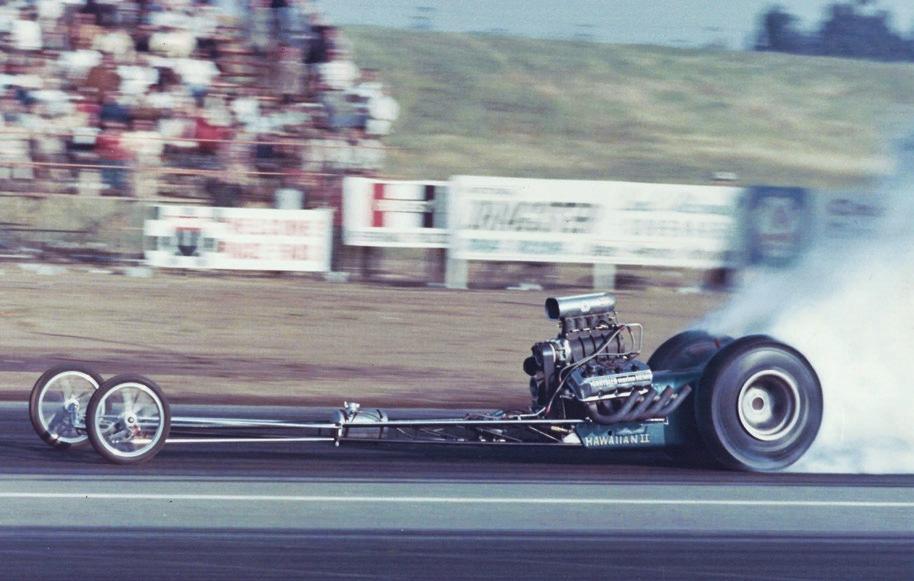
Roland Leong’s Hawaiian II (seen above) blasts down a drag strip in Riverside, California, in 1967. The top fuel dragster was one of several Island-themed cars that the Hawai‘i-born Leong would own over his illustrious fifty-plus-year career in drag racing. On the previous page, Leong (seen at far left) with his 1980 Dodge Omni Funny Car sponsored by King’s Hawaiian Bread.
car alone would blow their minds, just how pretty it was.”
In drag racing, two sleek, elongated cars—like rockets on wheels—compete side by side, charging down a straight, usually quarter-mile course from a standing start. The day’s compressed schedule left little room for error or delay in a sport where the margins are already tight. One journalist calculated an average of 5.2 cars per minute dueled on the strip that day.
For the top fuel final, Don Prudhomme faced veteran driver Wild Bill Alexander. Both had reached the finals by hitting speeds of more than two hundred mph in under eight seconds. (Earlier in the day, Alexander had defeated a car driven by Mauiborn Danny Ongais.) In what ABC’s sportscaster called “the big race of the day,” Alexander revved in lane one, Prudhomme in lane two.
A traffic light counted down to the start—red, yellow, green. At green the cars flew down the track, with
Alexander blasting to an early lead. (Decades later a reporter analyzing the film noted that Prudhomme never saw the yellow light—the bulb had burned out). In a thrilling turn, Prudhomme blew past Alexander to snatch the first of his career forty-nine NHRA wins. The Hawaiian finished in 7.76 seconds with a top speed of 201.34 mph.
As they raised their trophy for the team photo, Leong and Prudhomme were draped in fresh lei.
The win was the first for both Prudhomme and Leong, who decades later remain close friends. The pair had first met the previous July, when Prudhomme and his GreerBlack-Prudhomme dragster—one of the most admired cars in the sport— flew to Honolulu to participate in an NHRA event held on a new drag strip in Campbell Industrial Park. Despite headwinds, Greer-Black-Prudhomme hit 184.80 mph.
“Roland picked me up and showed me around,” Prudhomme recalls in his autobiography. “He was younger than me, maybe 18 years old. The next day, he took me out and we hung out all day,” wrote Prudhomme. “There I was in Hawai‘i, and I didn’t learn to surf or anything but Roland was like that, too. We were total gearheads. All we talked about was drag racing.”
Shortly afterward, Leong moved to California to pursue his dream of becoming a serious drag racer. He initially had wanted to drive his own cars, as he had done in Hawai‘i, but “I had never run a fuel dragster before,” Leong says. “I had built and run my own gas dragsters in Hawai‘i and had built my own engines but not a top fuel car. I didn’t even know where to start.”
His first foray ended in disaster: Leong crashed the first top fuel car he’d built in its trial run.
“After I crashed the car, Keith Black told me, ‘I don’t know if I can go racing with you anymore. If you got hurt or
32
PHOTO COURTESY ROLAND LEONG COLLECTION

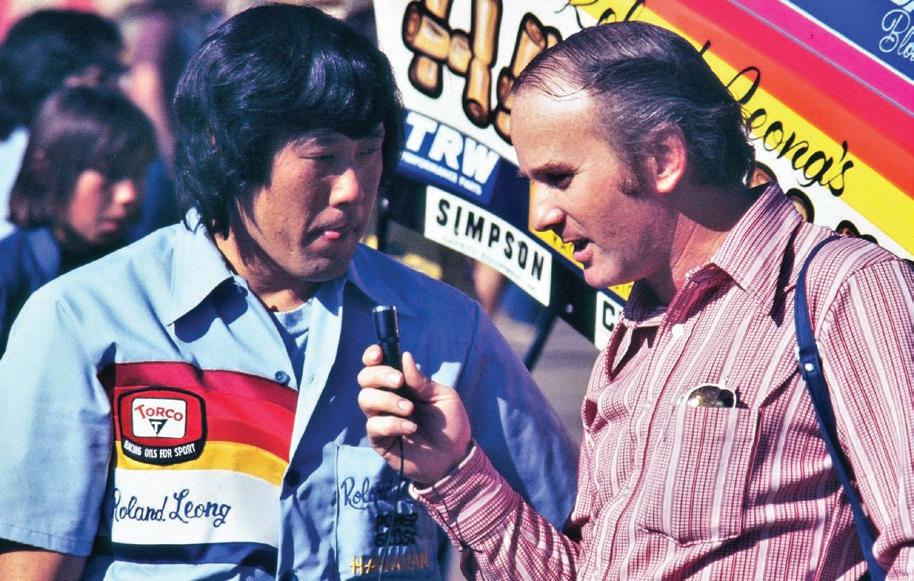
memorable
something [worse] happened to you, I don’t know how I could deal with it. I’m going to give up running the GreerBlack-Prudhomme car. Why don’t you just hire Prudhomme to drive, and you go run the car?’ And that’s exactly how it happened,” says Leong. “There was no planning. It was more, I guess you might say, being in the right place at the right time.”
Their victory at Winternationals launched Leong and Prudhomme into the sport’s spotlight, and promoters across the country sought to get The Hawaiian on their tracks. “The Hawaiian was just a real snappy name. People paid attention to it,” Prudhomme says. “Mind you, it had a Keith Black engine. It was the hottest car at the drag strip at the time. So the pair barnstormed across the country, racing on the nation’s premier drag strips, but there weren’t yet enough top-tier events on the calendar to make a living. So Leong and Prudhomme traveled from town
to town, challenging the top local racers—and winning. “It wasn’t too long before people started to realize who Roland is, this young Hawaiian kid,” remembers Prudhomme. “They looked at him a little bit different when he was kicking everybody’s butt. He proved himself big time! He kind of had to, to come up the way we did. To run with the group we did, you had to prove yourself. Roland did that many times over.” It helped that wherever they went, Prudhomme did the talking— Leong wasn’t always understood.
“Nowadays it isn’t bad,” Leong says, “But in the 1960s … can you imagine? The Hawaiian pidgin-English that we spoke? People responded faster if Don just spoke.” Not to mention that Asian Americans and Pacific Islanders were rare in the sport at the time.
On Labor Day weekend 1965, Leong, Prudhomme and The Hawaiian continued their winning season, taking the top prize at the NHRA’s US Nationals in Indianapolis, once again
wearing lei to celebrate. “Roland’s mother, Teddy, was a big part of our team,” Prudhomme writes. “Not only with money, she really supported us in every way. Like at the Winternationals, she had Hawaiian leis already made up. For some reason or another, she knew that we were going to win the race. In the winner’s circle she started putting them on all of us.”
Prudhomme adds that Teddy, who was Native Hawaiian and Chinese, told him she knew they would win because his nickname is “the Snake,” and according to the Chinese calendar, 1965 was the Year of the Snake.
Leong’s parents owned an insurance business with an office located where the Ilikai Hotel stands today. His parents had both been to college and stressed the importance of education. “My father had a master’s degree, and my mother had graduated from the University of Hawai‘i,” Leong
34
Leong was one of the few Asian Americans and perhaps the only Native Hawaiian during his heyday in drag racing. But more than anything it was his winning record and
cars that made him a celebrity in the sport. Above, a reporter for a Los Angeles newspaper interviews Leong at Pomona Raceway in 1977.
PHOTO BY LOU HART


says. “They were successful business people. They served mostly Chinesespeaking customers.” Leong attended ‘Iolani School but dropped out in his junior year of high school, much to the dismay of his Harvard-educated father. “I’d spent twelve years at that school and had enough. Racing had my attention,” says Leong.
It might have had his attention, but it couldn’t offer much in return. There was a drag strip on O‘ahu, but it operated only once a month, limiting Leong’s opportunities to win races and earn prize money, which didn’t earn him much credibility with his parents. “Drag racing wasn’t a good subject to bring up with my father,” says Leong, but his mother was a different story. “His mother had a good feeling towards racing,” says Prudhomme. “We didn’t hear much from his dad at all, but his mother was really on top of it. She helped him so he could make it to where he was able to make it on his own. He was able
to make a living off it and to raise his two daughters.”
In high school Leong spent increasingly more time at a service station on his route home. His parents knew the station’s owners, and the mechanics shared what they knew about cars and their engines. Despite his father’s misgivings, Leong’s mother saw that her son was serious about drag racing. She arranged for him to work at Dragmaster, a racing shop operated by Dode Martin and Jim Nelson in Carlsbad, California. While there, Leong became well acquainted with many of the West Coast’s elite builders and drivers.
After Leong and Prudhomme’s highly successful season, Prudhomme was asked to drive for another car owner. While the pair had an amicable split and remain friendly to this day— “We’re like brothers,” Prudhomme says—Black angrily told Prudhomme that race drivers are like an engine’s spark plugs: “You can screw one in and
screw one out,” recalls Prudhomme.
In 1966, with driver Mike Snively at the wheel, Leong and The Hawaiian again took top honors at both the Winternationals and the US Nationals. With his back-to-back successes, Leong maintained his desire to keep winning and earned a reputation as an innovator. “When you’re successful, you’re not apt to be changing things because you’re already building on what has been, right? Eventually the others do catch up, and then you have to change,” says Leong. “You can’t let them get ahead of you.”
In 1969, Leong switched to racing Funny Cars, another type of drag racer. As their popularity grew, Leong calculated a winning Funny Car would be more lucrative, with more opportunities for match races. Like Top Fuel dragsters, Funny Cars are hand-built, but they look more like a passenger sedan than a ballistic missile. Leong’s Funny Car—a souped-up Dodge Charger—kept the name and, originally,
36
PHOTO COURTESY ROLAND LEONG COLLECTION
Leong’s Hawaiian Vacation Funny Car (seen above), sponsored by the Hawai‘i Tourism Board, could reach speeds of 290 mph and won the National Hot Rod Association’s Oldsmobile Springations in Columbus, Ohio, in 1993. It would be the last car Leong owned; when HTB cut the funding, Leong retired from owning cars but continues to be influential in the sport to this day.


the same paint job. To drive the latest version of The Hawaiian, Leong hired Larry Reyes, who had earned a solid reputation racing a pair of Plymouth Barracuda Funny Cars, following an impromptu meeting at Black’s shop.
“He came out of the store and reached out his hand to me to introduce himself. He said, ‘Hey, I’m Roland.’ Of course, I told him I knew who he was,” recalls Reyes. “We shook hands and had a short conversation. Then, he asked me if I’d be interested in driving his car. Can you believe I told him I would think about it? A few days [later], I told him that I would.”
It wouldn’t be smooth sailing, but there would be sailing, in a manner of speaking. First, Leong’s Dodge Charger was larger than the Barracudas Reyes had raced. And after its completion, there wasn’t time for more than a brief test ahead of the 1969 Winternationals, where the car’s aerodynamics proved troublesome. Racing down the quarter-mile track, The Hawaiian went completely airborne—a photograph that
was widely reproduced in newspapers and television broadcasts.
“I hit the parachute but it didn’t pop out,” Reyes says of trying to deploy the canopy to act as a brake. “The car got away from me, and we wrecked it. Then they built the new car, also a Dodge Charger, but it was so much different. We ran hard the first night with that car. We won three races in a row on three different racetracks. That’s how I got started with Roland. It was good experience for me, and we’re still friends.”
For more than twenty years, Leong’s The Hawaiian Funny Cars were among the most recognizable in the sport. Leong was also among the first to recognize the sport’s appeal to nonautomotive sponsors and would paint his car to match the sponsor. In 1980 the cars were painted bright orange for King’s Hawaiian Bread. A few years later Hawaiian Punch became his primary sponsor, and Leong painted the cars blue and red. In 1991, Leong’s Hawaiian
Punch Funny Car broke the 290-mph class speed record at the US Nationals in Indianapolis. Leong skipped a year and returned in 1993 to compete one last season as team owner of the Hawaiian Vacation Dodge Daytona.
Leong ran an abbreviated season in 1993 with the Hawaiian Vacation Funny Car. Afterward, Leong lent his expertise to various teams. In 1997 he again teamed up with Prudhomme— retired as a driver and now an owner—to tune his team’s Copenhagen Funny Car. In 1998 the Copenhagen team won more national events than anyone in their class but finished second overall. Leong took some time off from the sport, returning in 2009 to work with vintage nitro fuel-burning Funny Cars. In addition to his many victories at drag strips all over the country, Leong has won fifteen NHRA events as an owner/ tuner throughout his career, including three US Nationals wins.
Leong has remained engaged to this day. In 2019 he flew to England
38
A collection of memorabilia in Leong’s home in Los Angeles—including, in the foreground, a model of his first championship car, top fuel dragster The Hawaiian, which won the NHRA Winternationals in 1965 and thrust Leong into the national spotlight.


to consult with racers, and whenever he attends vint age drag racing events in California, Reyes says, he attracts a crowd. “No one loves the sport more than Roland,” say s Prudhomme. “He’s on an entirely different level than anyone else I’ve known.” And that’s coming from one of the sport’s greatest drivers.
At a ceremony held at the Ala Moana Hotel in Honolulu last August, Leong was officially inducted into the Hawai‘i Sports Hall of Fame. Nominated
in 2020, his induction had been postponed due to COVID-19. Inducted alongside Leong were University of Hawai‘i football coach Larry Price, world racquetball champion Egan Inoue, national volleyball champion Tita Ahuna and the late Hawai‘i surf legend Ben Aipa. Prudhomme says being at the induction ceremony fifty-nine years after he first met Leong was poignant: They had never since been to Hawai‘i together. “I had a great time,” says Prudhomme. “The ceremony was so different than on the Mainland. It was a typical Hawaiian function. I go to plenty out in California,


Leong, seen at left in his home today, is still deeply involved racing. “No one loves the sport more than Roland,” says Don Prudhomme (pictured above top), who drove The Hawaiian to its 1965 win. “He’s on an entirely different level than anyone else I’ve known.” Above bottom: Leong and Prudhomme, bedecked in lei, hold the trophy after winning the 1965 Winternationals. Engine builder Keith Black, also wearing a lei, stands at Leong’s right. Leong’s mother, Teddy, who supported Roland’s passion for racing, stands second from the left.
and I really like the way they do them in Hawai‘i. Real casual. I didn’t have to wear black tie.”
For Leong, being inducted into the Hawai‘i Sports Hall of Fame after more than a half-century of drag racing was a “surreal” experience, he says. “In those early days it was more about making a living. Because, who knew what we could do? It was all new. All we knew at the time was that we had to try it. Then, we did it. We did whatever it took that was in our line of work. Fifty years later, to be honored by my home state, it is really just a dream.” hh
40
PHOTO COURTESY ROLAND LEONG COLLECTION

The Descendants
The family of renowned kumu hula Edith Kanaka‘ole carries forward the Hawaiian cultural renaissance she helped inspire

The brackish waterway on the shore at Honohononui is beautiful: Walls of ancient stones define its banks, and the water flows gently around a green, grassy knoll. It wasn’t always this way. A visit to this seaside spot would have been very different even as recently as the early 1990s, when Haleolono, this four-hundred-year-old fishpond outside
of Hilo, was all but gone, buried under overgrowth after decades of neglect.
Today Haleolono has been restored and is meticulously maintained by the Edith Kanaka‘ole Foundation, a nonprofit founded by the descendants of its namesake, the late kumu hula (hula teacher) and Hawaiian cultural leader. Restoring this loko i‘a (fishpond) was no small challenge, in part because no one knew quite where it was: The
foundation tapped into generational knowledge and scoured old maps to find it. The two-lane road cutting the area in half illustrates the tension between modernity and tradition so common in Hawai‘i, but despite the changes wrought by development, the foundation discovered that most of the pond’s stone walls were intact.
It took roughly ten years to revitalize the pond, which now yields about three
STORY BY DW GIBSON PHOTOS BY ELYSE BUTLER 42


hundred pounds of fish every year— there’s lots of ‘ama‘ama, or mullet. The foundation shares the bounty with the volunteers, students and community members who help maintain it.
Edith’s great-grandson Luka Kanaka‘ole, now 32, was a child when the work began. “I grew up picking up rubbish at the first pond,” he says. “It had become a gathering place for dumping trash.” After a few years of digging and clearing debris, the freshwater springs slowly returned, and the fish soon followed. “Places like this,” says Luka, looking out across the water, “they start dying. People forget the name of the place, and the function disappears.”
This year the United States Mint launched its American Women Quarters Program, featuring female icons on the reverse of select coins. The inaugural group of five women included the likes of writer Maya Angelou and astronaut Sally Ride. When
the second group of five women was announced in March, it included a name few outside of Hawai‘i might recognize but that’s woven into the fabric of Island culture: Edith Kanaka‘ole.
Kanaka‘ole was many things: mother to six children, instructor at the University of Hawai‘i at Hilo, kumu hula, composer and chanter—and in all of these roles she worked to elevate the relevance of traditional Hawaiian practices. She was instrumental in establishing early Hawaiian language programs in public schools, inspirational to the University of Hawai‘i students who pushed for a bachelor of arts in Hawaiian studies, and she traveled the world showcasing less conventional styles of hula. In its statement regarding Kanaka‘ole’s inclusion in the series, the US Mint noted that “her mo‘olelo, or stories, served to rescue aspects of Hawaiian history, customs and traditions that were disappearing due to the cultural bigotry of the time.”
Kanaka‘ole was an influential figure in the Hawaiian cultural renaissance of the 1970s, and long after her passing in 1979, her presence continues to be felt through the nonprofit established in her name. Formally incorporated in 1990, the Edith Kanaka‘ole Foundation carries forward much of the work that Kanaka‘ole was doing in the past century. Several members of the Kanaka‘ole family have dedicated themselves to the effort, including Luka. He’s the foundation’s project manager as well as its communications officer. “In a small organization like this,” he says, “everybody wears a lot of hats.” Based in Hilo, Luka is integral to many aspects of the foundation’s day-today operations, though there’s one thing he doesn’t do: hula.
The foundation is probably best known for Hālau o Kekuhi, a hula school teaching a tradition passed down over eight generations of kumu hula in the Kanaka‘ole family line. The hālau hula
44
The family of the late kumu hula (hula teacher) and Hawaiian cultural practitioner Edith Kanaka‘ole stands in Haleolono fishpond in Hilo (seen also on page 42). From left to right: Lanihuli Kanahele, her brother Luka Kanaka‘ole and their parents Huihui Kanahele-Mossman and Kala Mossman. The family, through the nonprofit Edith Kanaka‘ole Foundation, has taken on the kuleana (responsibility) of restoring and caring for Haleolono, among many other projects that preserve and perpetuate Hawaiian culture. “Places like this,” says Luka, seen also on page 43 with Lanihuli, “they start dying. People forget the name of the place, and the function disappears.”
Over the distant horizon is a place where ocean, land, and sky converge. A paradise of golden-sand beaches, tranquil lagoons, and red-earthed kula lands. This is Timbers Kaua‘i - an exclusive collection of luxury oceanfront residences, thoughtfully designed in harmony with a serene natural setting.
Reconnect with loved ones against a majestic backdrop of picture-perfect ocean views, scenic trails, and Kaua‘i’s only Jack Nicklaus Signature golf course. With both whole and fractional ownership opportunities to choose from, Timbers Kaua‘i lets you discover all the beauty of Hawai‘i’s captivating Garden Isle - from the comfort of your very own island home.
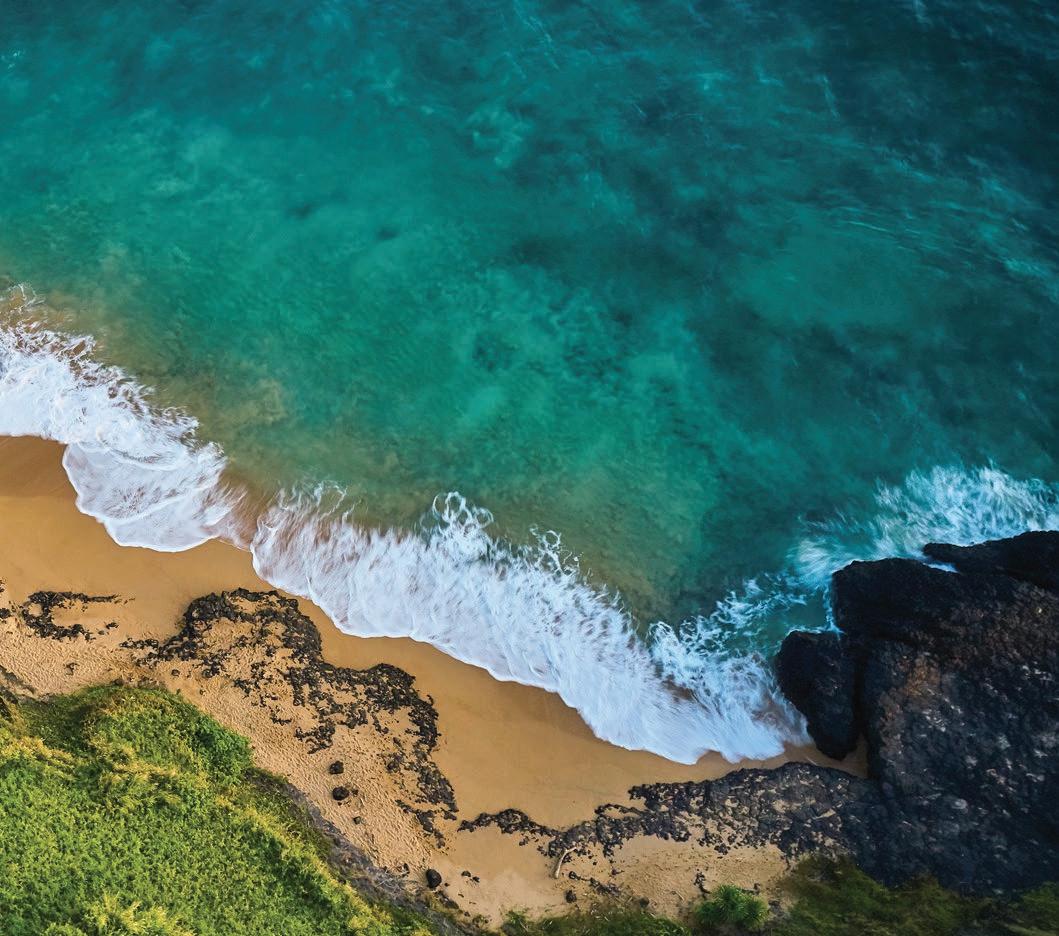
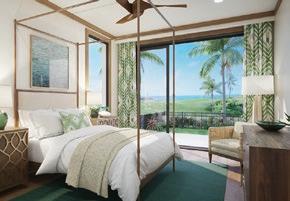
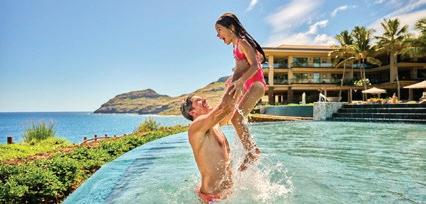
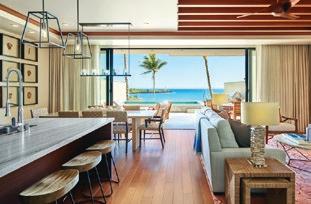
At land’s end, living begins PRIVATE TOURS AVAILABLE DAILY 808.647.2871 timberskauai.com/hanahou This does not constitute an offer to sell nor the solicitation of an offer to purchase made in any jurisdiction nor made to residents of any jurisdiction, including New York, where registration is required. Tower Kauai Lagoons LLC uses the Timbers Resort,® Timbers Collection® and certain other Timbers brand names under a limited non-transferable license in connection with the sales and marketing of Hōkūala Kaua‘i™ – A Timbers Resort® (the “Project”). If this license is terminated or expires without renewal, the Project will no longer be identified with nor have any right to use the Timbers® marks and names. All rights reserved.
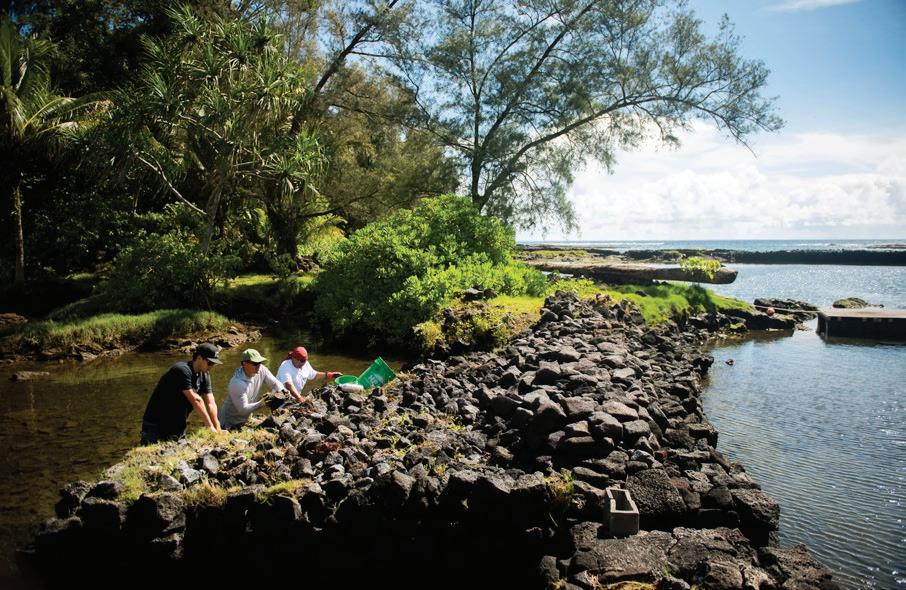
(hula school) is known for its ancient ‘aiha‘a style of hula, featuring lowpostured and “eruptive” movements evoking the volcano deity Pele and her sister, Hi‘iaka. The foundation prides itself on preserving this distinctive hula, rooted in traditions reaching back to a time before Western contact.
Having two left feet in a renowned hula family initially shook Luka’s confidence and sense of identity. “I was bummed out about it because I wasn’t good at it, and everybody in the family does it.” He still remembers the day his grandmother Pualani Kanaka‘ole Kanahele, one of Edith’s two daughters who established the foundation, called him out. He was around ten years old, and they were in the family kitchen. “My grandma, she says, ‘Yeah, you’re not very good at it,’” he recalls, laughing. “She can be pretty blunt.”
But after that blunt remark, she pressed him to find something else, another place to put his energy and do
meaningful work. “One thing she did tell me is you can go do something. Find a practice that you can be a kanaka [Native Hawaiian] at. It doesn’t have to be hula—just find a practice.”
So he took up paddling and developed an interest in conservation science, studying on the Mainland and at UH-Hilo. He also became a chanter. “I’ve always been that guy,” he says, “the ‘Hawaiian guy.’ People always say, ‘Oh, you can do the chants for us.’ And I have to say, ‘Well, instead of me doing this chant all the time, how about I teach you guys and you can do it, too. I want to give you the tools so you can understand these things yourself.’”
Which is, in sum, the foundation’s mission: empowering people to apply the practices Edith Kanaka‘ole revived in a modern context. In his university studies, Luka learned environmental conservation from a Western
perspective. When he began working with the foundation in 2018, he realized that many of the concepts he’d learned were already built into Hawaiian oli, or chants, sung generations earlier.
Luka inherited an understanding from his elders that in Hawaiian culture the spiritual and practical are linked. “Not only do you get a spiritual connection when you do an oli, but you’re reciting a thesis about, say, the water table in our forest floor.” The stories conveyed in ancient chants, songs and dances, Luka says, connect to data points in the natural world—data that can inform contemporary conservation practices.
Luka spends most of his energy on the foundation’s land management program, Papakū Makawalu. Through research and workshops, he and his colleagues foster modern land management practices that align with his ancestors’ methods of understanding the environment. The foundation runs approximately a half-
46
Luka (center) joins volunteers to clear weeds from the rock walls of Haleolono. For Luka, who works primarily in the foundation’s land management programs, restoring the pond is just one way in which he carries on his great-grandmother’s legacy. He’s currently working with local tour operators to ensure that visitors are educated about Hawaiian history and knowledge of place. “Instead of giving visitors a cocktail on the beach, we want to give them more informed experiences,” he says.


dozen Papakū Makawalu workshops every year, with participants from universities, research groups and nonprofits from around the world.
The Western and Hawaiian approaches to land management and the natural world “are different languages for some of the same ideas,” Luka says. “These are the same processes you study in school, but to our ancestors these processes were gods.” He points to “Kāne” as a prime example. When simplified,” says Luka, “Kāne refers to fresh water. You won’t find a reference to this in the dictionary, because it isn’t a direct translation. It’s inference. But there’s an oli called ‘E Kānehoalani E’ that we chant to the rising sun. If you think about it, you can ask, ‘Well if we’re calling Kāne fresh water but also calling Kāne the sun, how are those two things related?’ It’s because Kāne represents not just fresh water but the elements that move water,
and the element that moves water the most is heat, specifically heat from the sun. So Kānehoalani can project heat on the surface of our world and move water upward from the ocean and land surfaces. There are so many examples of how these nomenclatures represent natural phenomena, ele ments and processes.”
During the pandemic, as tourism abated and Hawai‘i residents contemplated how the state’s biggest industry might come back in a more sustainable way, Luka was approached by Hawai‘i County leaders about developing a program to certify tour operators who want to align their modern businesses with ancient practices and knowledge. “We’ve created a template called Kipa,” says Luka, “to talk to tourism operators about how Hawaiian knowledge can offer them the tools to better present and implement authentic and accurate
knowledge to their clientele.”
A pilot version of Kipa got under way in June 2021 with a six-session workshop designed for helicopter tour operators. The curriculum is based on the Papakū Makawalu program and designed to be as specific as possible to the places where the participating operators work. Luka points out that there are over thirty names for certain spots along the stretch of Hilo coastline where the foundation does most of its work. “What does each name mean, and how does it describe the natural function of each place?”
Such granular knowledge, as Luka sees it, does more than just enrich visitor experiences; it teaches what’s needed to protect a specific bay or trail or reef. “Instead of giving visitors a cocktail on the beach, we want to give them more informed experiences,” says Luka. “When I visit places, I always understand how to conduct myself, how to get the most out of learning from the culture that I’ve entered. In Hawai‘i
48
Above, Lanihuli Kanahele shores up the walls of Haleolono during a recent community workday. Since the foundation began restoration work ten years ago, Haleolono went from a neglected, vegetation-choked relic to a functioning, productive fishpond, one that had fed the community since pre-contact times.



The foundation’s work is part of a larger push within the state to direct its number-one industry—tourism—toward more sustainable and “regenerative” practices. To mālama, or care for, the Islands, as Hawai‘i Tourism Authority president and CEO John De Fries (seen above left) puts it. “It’s going to come down to people like Luka Kanaka‘ole,” De Fries says. “If we can get all the families like the Kanaka‘oles to invest in this way, they will reinvent tourism.”
that sense of a code of conduct has been thrown out for the sake of profit. When we have visitors, we want them to see the water cycles and how the birds interact with the trees. We don’t want to sell the Jimmy Buffet experience anymore. We want to sell the health of this diverse ecological phenomenon. We’re hoping for an industry that’s more contributive than extractive.”
The program has the support of John De Fries, the first Native Hawaiian to serve as president and CEO of the Hawai‘i Tourism Authority. Under De Fries’ leadership, HTA is investing in sustainable and regenerative tourism initiatives like the Mālama Hawai‘i
Program, which rewards visitors who volunteer for a day with a free additional night in their hotel, as well as waived change fees for airline tickets. “We all know what aloha is,” says De Fries, “but we want mālama—which is to nurture, to protect, to care for—to become a kind of sister Hawaiian value. The things we aloha are the things we nurture and protect. It’s going to come down to people like Luka Kanaka‘ole. If we can get all the families like the Kanaka‘oles to invest in this way, they will reinvent tourism.”
Both De Fries and Luka hope the new quarter featuring the Kanaka‘ole matriarch will be another
way to help the foundation make a difference in the Islands, one project— and one coin—at a time.
“It’s really awesome to have her in the series alongside the other awesome women,” says Luka. The family was grateful to the US Mint for engaging them during the design process for the quarter. “Sometimes you see more stereotypical Hawai‘i, with palm trees and a rainbow, and that’s not who she was.”
The coin features Kanaka‘ole’s face prominently. Her long, windswept hair is adorned with a lei po‘o (head lei), which morphs into a vivid landscape at her side—a river valley with mountains
50

in the distance. Below her name and likeness is the phrase “E hō mai ka ‘ike,” or “Grant us knowledge,” a guiding principle for Kanaka‘ole and the foundation that bears her name.
Luka and his family spent a great deal of time describing Kanaka‘ole’s work to get the image on the coin just right—and the designers listened. “They were really good, really patient with us. We’re excited because maybe some people will see her on the quarter and discover who she was and what she did. Hopefully, that can help us accomplish our mission of heightening Hawaiian consciousness and heightening Hawaiian intellect.” hh
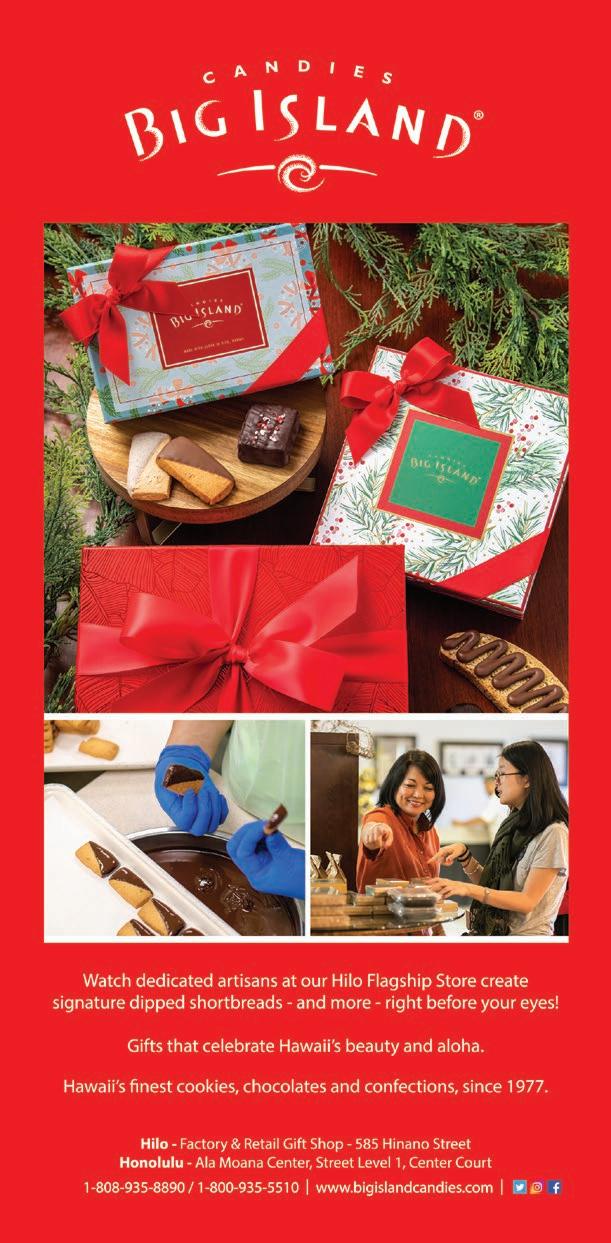
The Earth Whisperer
When the planet speaks, geophysicist Rhett Butler listens
On the morning of April 1, 1946, the tide mysteriously rose past the highest markers in Hilo Bay. Then the water disappeared, draining out of the bay entirely. Boats listed on the rocks and fish flopped on exposed seabed. Then it came: a crushing, thirty-two-foot wave that surged inland and destroyed almost a third of the city—one of the worst natural disasters in Hawai‘i’s recorded history. More than 2,400 miles away, a major earthquake in the Aleutian Islands had triggered the tsunami, one that struck without warning.
“This was the event that ultimately led to the creation of the Pacific Tsunami Warning System,” says Rhett Butler, former director of the Hawai‘i Institute for Geophysics and Planetology. Today there would be warning: Earth-monitoring sensors provide data on global seismic activity to help scientists predict and model tsunami events. Butler’s work directing this Global Seismographic Network (GSN), advocating for increased seafloor monitoring and coordinating with local

52 STORY
PHOTOS BY ELYSE BUTLER
BY LARRY LIEBERMAN



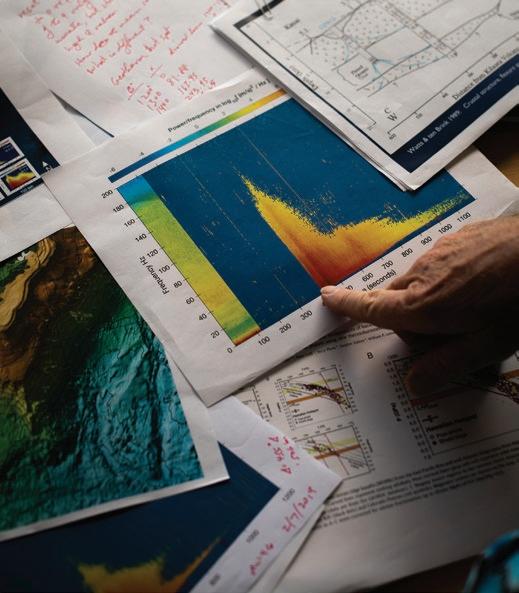
emergency response planners has made the Hawaiian Islands—and the rest of the world—safer.
“There’s my little homemade seismometer,” Butler says, pointing to a precariously balanced stack of pebbles on a shelf in his office at the University of Hawai‘i’s School of Ocean and Earth Science and Technology (SOEST). He’s half-joking but sincere. “If the building ever vibrates, these will fall over.” He says the stones have toppled more than once, but never while Butler was there to see it. Despite decades studying earthquakes, he has yet to experience one himself.
Cheerful and unassuming in his trademark bright aloha shirt, Butler is both wry and passionate when discussing the movement of the earth. He describes the slowest of Earth’s natural vibrations, a sluggish oscillation that takes about an hour between peaks. “I believe Earth is the greatest tai chi master of all,” Butler quips. But when it comes to fault lines and fractures, few are more serious.
In a career spanning more than forty years, Butler has traveled the globe supervising seismographic efforts in some of the world’s most remote locations and deepest oceans. Coordinating GSN programs for agencies including the National Science Foundation, NASA and the Department of Defense, he’s worked in places as disparate as Washington, DC; Hawai‘i; and Antarctica. Butler has partnered with UH since 1982 and has called Hawai‘i home for the past eighteen years. During that time Butler, alongside colleagues at UH and among the global earth science community, has made major advances in our understanding of the planet we all call home.
Butler’s interest in science started when he was a boy fascinated with the way things work. A family trip to Boston included lunch across the street from the Massachusetts Institute of Technology, and Butler decided on the spot that he would go there for college.
After graduating high school in his hometown of Coshocton, Ohio, Butler made the cut and was off to MIT.
In case you were wondering: Yes, Butler is named after the character Rhett Butler from Gone with the Wind, but the real Rhett Butler never really gave a damn about it. “I grew up in a small town, and in elementary and high school no one had ever said anything about my name,” he says. “But on my first day at MIT, everyone commented on it—my name didn’t even show up on the rolls for my classes because the school thought it was a prank and deleted it!” Once the error was corrected, Butler went on to earn his degree in earth and planetary science. From there he shifted to doctoral studies in geophysics at Caltech, which is where he discovered that seismology matters.
From its modest beginnings in 1986 through today, the GSN has grown to include more than 150 land-based seismic monitoring stations that record movements large and small. The sources
54
As a geophysicist and seismologist at the University of Hawai‘i’s School of Ocean and Earth Science and Technology, Rhett Butler (seen on pages 52-53) has spent his career listening to the subtlest of the planet’s vibrations, in part to help predict earthquakes and tsunamis. Above right, Butler points to a spectrogram of seismic energy generated by an earthquake on Hawai‘i Island, observed by the Aloha Cabled Observatory on the seafloor sixty miles north of O‘ahu. Above left, a far lower-tech seismometer balances in Butler’s office. “If the building ever vibrates, these will fall over,” he says.


of seismic activity they detect is diverse: earthquakes, landslides, volcanic eruptions and more. Even meteorite impacts create planetary vibrations. Besides sensing seismic events that could trigger tsunamis, another practical application of the network has been monitoring international nuclear arms testing to help enforce treaties. The sensors act almost like microphones, able to pick up even the slightest vibration. Acoustic waves measured by microphones are scalar, or onedimensional. But seismic waves are measured as vector motion in all the directions of three-dimensional space, and the seismic equipment has to be extremely sensitive to accurately track and record those movements. Now when a tree falls in the forest with nobody to hear it, there’s a decent chance that a GSN sensor will detect it.
Butler has been instrumental in getting those sensors into some of the most remote places on Earth. “I think probably the most interesting place I’ve
been is the South Pole,” Butler says. As a program manager for the Incorporated Research Institutions for Seismology (IRIS) in the 1980s, he was responsible for the polar seismic station that had been in place since 1957. It was the oldest continuously operating data stream out of the South Pole.
Despite whimsically taking photos at the pole in one of his colorful aloha shirts, Butler holds a deep respect for the severity of the environment.
“You go out there in the summer and the sun never sets. It goes around in a halo overhead. We got under some of the ice tunnels where it was minus eighty degrees, and that is cold!”
Butler remembers being interviewed by a visiting team from the Discovery Channel. “The interview lasted until the camera froze, and that was it.” But when the site became busier as a science hub, with astronomers and physicists moving in to study neutrinos from deep space and conduct other experiments, the noise started to corrupt some seismic
readings. “We could sense tractors driving around the pole. We’d pick that up, and every time a plane landed or a snowmobile drove past the sensors. We’d pick up absolutely everything.” Butler’s solution was to move the seismic station eight kilometers away from the main research center. “We drilled boreholes nearly a thousand feet into the ice, put seismometers in, then buried an observatory building under the ice and hooked it all up with fiber-optic line back to the pole,” Butler recalls. The new South Pole seismic station performed as planned. “It turns out, when you get away from the noise that’s in a certain frequency band, the South Pole is actually the quietest place on the planet. I’m really proud of how it all panned out and how we were able to install the equipment that is still operational today.” The US Geological Survey and ultimately the Advisory Committee on Antarctic Names were also proud of Butler’s accomplishments, and in 2004 named a mountain after
56
Butler, seen above in his office at UH, has helped install and operate seismic monitoring technology in extreme places—along undersea cables and even at the South Pole, where he helped place an observatory a thousand feet deep in the ice, one that remains operational today. For his achievements, the US Geological Survey named a mountain in west Antarctica for him.


him: Butler Summit rises to about 3,300 feet in western Antarctica.
Another part of the planet that doesn’t have nearly enough seismometers is the ocean floor. Despite being one of Butler’s top priorities and a focus of his advocacy, it’s an area with many challenges and few solutions. Due to the extreme installation cost and the difficulty of
the environment, there’s just no way to effectively and affordably monitor the vastness of the sea bottom, where many of the largest earthquakes occur. During his time with IRIS, Butler was involved in a project funded by the Japanese government to repurpose a retired AT&T undersea telecommunications cable between Guam and Japan as a submerged seismic observatory. It succeeded in producing data for the
region, but the rest of the world’s oceans were still unmonitored.
“After working on the cable project with our partners in Japan, we decided to try and do one of our own,” Butler says of the project that ultimately brought him to the Islands starting in the late 1980s. “We said, ‘Let’s do something between California and Hawai‘i.’”
At the time, AT&T was retiring one of its five undersea cables that run from
58
Above, Butler explains the hot spot that created the Hawaiian-Emperor seamount chain to his granddaughter, Sunny. As the Pacific plate passes above the hot spot, new islands form, then slowly sink back into the sea over millions of years as the plate moves past the hot spot. The bend in the chain occurred 47 million years ago, he says, when the Pacific plate’s motion changed direction.

Hawai‘i to the Mainland, and Butler was able to help arrange for AT&T to donate the Hawaii-2 cable for use by the scientific community. “We picked up the cable and connected up a junction box to plug in things like seismometers, hydrophones and temperature gauges,” Butler says. “So we were able to create a seafloor observatory at the bottom of the ocean between Hawai‘i and California, almost three miles deep.”


studying antipodal reactions triggered by earthquakes occurring on the exact opposite side of the planet. “It’s really interesting when we have a quake where one of our seismic stations is on the other side of the globe,” Butler explains. “Because observing the movement at the antipode, on the other side of Earth from the epicenter, helps us determine the properties of the materials the waves are passing through. Is it liquid? Molten? Crystalline? What is it made of?” Earth scientists can study the patterns of seismic waves moving through the earth from one side straight through to the other side. “It’s like you’re bouncing rays off of things, like a dolphin, to let you basically see inside of the earth.”
measurements from that event showed tsunami impacts on sea levels across the Pacific Rim and as far away as Antarctica, French Polynesia, Chile, the Galápagos Islands and even the east coasts of Africa and Europe. While earthquakes of that size are extremely rare, even Tōhoku was dwarfed by the Great Chilean earthquake of 1960. At a magnitude of 9.5, that event holds the record for the strongest earthquake in recorded history. Hilo was devastated yet again by the resulting tsunami.
The Hawaii-2 Observatory, or H2O, remained operational for more than five years, providing critical Pacific Ocean seismic data before being retired in 2003. Since then Butler has remained involved in efforts to leverage other aging telecommunications cables or outfit new cable deployments to improve seismic monitoring in the ocean. “But we still have a long way to go,” he cautions. “Most of our seismic data comes from land-based stations, but to really improve our understanding and develop more accurate models, we need to have a more even global distribution of sensors. The only way we’ll get there is by adding more undersea monitoring.” In his lifetime, Butler hopes to make an impact in this specific area so Earth can be more accurately monitored for generations to come. Whether actively monitoring, managing or simply doing the math, Butler and his colleagues at UH are on a constant search for new and innovative ways to improve the measurement and analysis of Earth’s vibrations. While seismometer readings near the epicenters of earthquakes typically provide the majority of information, and more undersea sensors are being developed, a few lesser-known data points have piqued Butler’s interest. For example, one of his passions is information about the structure of Earth’s core that can be extrapolated by
With such insight into how seismic activity can illuminate Earth’s attributes, and because of his experience managing the GSN, it’s no surprise that Butler was tapped to assist NASA for the Mars Insight mission. “I was the seismologist on the NASA review team that monitored the project for years, making sure we properly implemented the seismology on Mars,” Butler says. By analyzing seismic activity on Mars, planetary scientists have been able to learn much more about the red planet’s structure. They’ve found that the core of Mars is bigger, relatively speaking, than Earth’s core, and they’ve gathered data that helps scientists understand similar activity on Earth. “We live on a planet,” Butler explains. “So it’s helpful to understand the structure of another planet.”
Although he’s spent time studying seismic events in extreme locations, from remote islands to ocean trenches to polar ice caps and even other planets, the quakes Butler is most concerned about happen closer to home in expected locations but with unexpected strength.
The 1946 Aleutian quake causing the tsunami that hit Hilo was big, but nowhere near as big as some other earthquakes throughout history. In 2011 a 9.1-magnitude earthquake shook the Tōhoku region of eastern Japan, causing a tsunami that resulted in catastrophic destruction and loss of life. Coastal
These earthquakes struck in areas known to be seismically active. There’s a history of patterns and data that can help emergency planners prepare for future events. But what happens when earthquakes we think we’re prepared for hit harder than expected?
“When I looked at the pictures coming in from Tōhoku and saw the size of the inundation zone, I thought, ‘This is terrible,’” Butler recalls. “Their defenses may have been able to withstand an eight, but they got a nine. Being in Hawai‘i, I wondered, can we be wrong here?” Butler realized that Hawai‘i had modeled its inundation zones based on the largest historical earthquakes that caused local tsunami events, like the 1946 quake. “But that was only 8.6, and we now know that something more powerful is possible,” Butler says. “If another, bigger earthquake happened in the Aleutian Islands, and I mean big— like 9, 9.5, as big as we’ve seen in other places on the planet—it could exceed our assumptions about inundation zones. It would be hard not to.”
After the Tōhoku quake, Butler began working with Hawai‘i’s Civil Defense and Emergency Management Agency to reevaluate and redefine tsunami inundation and evacuation zones to better prepare for more extreme events. “There’s a really good working relationship and respect for each other between the state and county and the Pacific Tsunami Warning Center,” Butler says. The collaboration is making a difference that could help save lives someday. “It’s a diverse group of organizations, but we all have the same goals. We all live here, we care about the people and we want to make sure that Hawai‘i is well prepared.” hh
60
Above, an artist’s conception of the Mars InSight mission, for which NASA tapped Butler to assist in gathering and analyzing data about seismic and tectonic activity on the red planet. “We live on a planet,” Butler says, “so it’s helpful to understand the structure of another planet.”

Breaking Ground
For “b-boy” HIjack, breakdancing is part art, part sport and all aloha

AMENGUAL AND MASTA
STORY BY ERIC STINTON PHOTOS
BY ADAM
MINCH 62
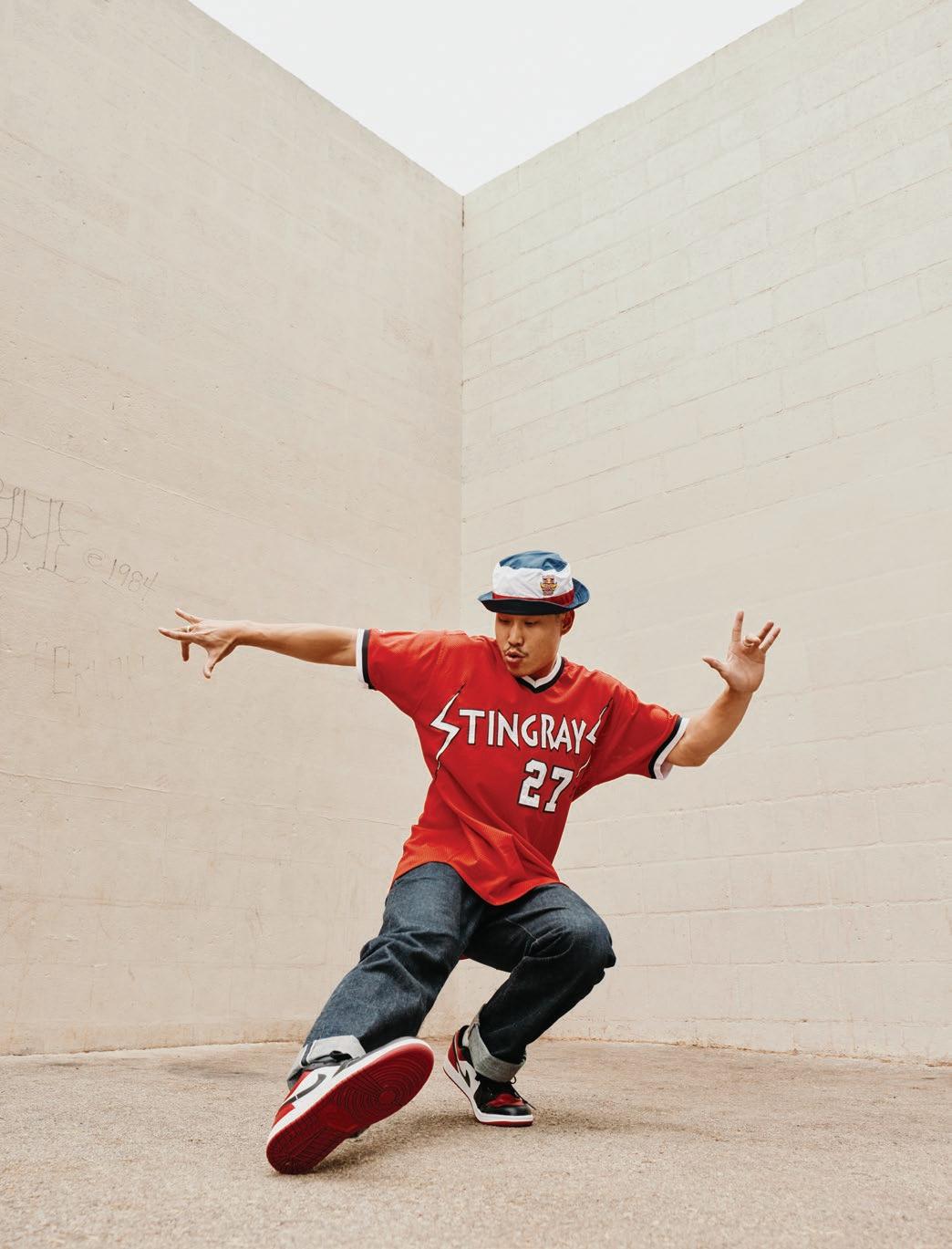
The 2022 Red Bull BC
One USA Cypher is taking place in the heart of Los Angeles, a few blocks from the Walk of Fame. By the time the doors open, the line stretches down the street, a crowd as diverse as Los Angeles: Black, Latino, Asian and white; men and women; young and old; single college kids staying up all night and parents whose children have set bedtimes. Proof that hip-hop culture is universal, if any were still needed.
Inside is a foyer with tables of merch: Red Bull gear as well as vinyls and cassettes of old school hip-hop. Inside the venue you’re blasted by Richter-scale bass and the smell of enough Red Bull to defibrillate your heart. Three thrones preside over a circular dance floor—one for each judge—the DJ booth towering behind them. Even before the competition gets underway, an impromptu cypher—when a crowd forms a circle and dancers take turns busting moves in the center— breaks out. The crowd, drawn to the excitement, gathers to watch.
The hosts, rappers D-Stroy and MyVerse, corral the audience to explain the rules and introduce the judges: 2004 World Champion Omar Davila, b-girl pioneer Asia One and 2010 World Champion Neguin Lopes. Sixteen “b-boys” and “b-girls”—the original hip-hop terms for breakdancers—will compete, some of whom were invited based on past performances, others who earned a spot by winning a regional competition. Twenty-eight-year-old Jack Rabanal from Honolulu, a.k.a. HIjack, was invited. A win here will earn him a spot in the Last Chance Cypher, an event where the national champions from other countries compete to earn a spot at the World Finals, arguably the biggest stage in competitive breakdancing. It would be the biggest stage a Hawai‘i breakdancer has ever been on, but first things first.
The competitors will face off in head-to-head battles consisting of two
one-minute rounds. They’ll be judged on control, aesthetics, rhythm and difficulty. Breakdancing has four traditional categories: top rock (the opening sequences when breakers are still on their feet), footwork, freezes (held poses) and power moves (maneuvers where the whole body is in motion). The judges don’t deliberate; they just point toward whom they think won.
In the first round, HIjack goes up against Supa Josh from Philadelphia. The two b-boys wait for the other to kick things off, then HIjack starts the battle with slick top rock in tempo with the beat, which sounds more Havana than Harlem. From there he drops to the floor, swinging his legs around his body and propelling himself up into the air, ending the round on a smooth freeze, standing mid-stage and pointing at his opponent. “Hawai‘i in the house!” host MyVerse exclaims.
Supa Josh bursts into his first round, going straight to the floor to start spinning and flipping. His moves are fast and clean, but instead of linking them together in a smooth flow, each seems added onto the previous one after the fact. After about thirty seconds he retreats to the edge of the dance floor, signaling an early end to his first round. HIjack capitalizes, using the extra time to focus on top rock and footwork, categories Supa Josh neglected. At the end of the battle, all three judges side with HIjack, who moves up to the quarterfinals.
“Before the battle starts, I try to think about the why,” HIjack says. “Why I do this, why I enjoy this. How it benefits not only myself but my students and friends. How it helps me to build relationships and connections. I look at my roots, little Jack dancing in third grade, trying to do the moonwalk and the worm in the back of the classroom. Now I’m here on the big stage, and it’s just because I love it.”
When Rabanal is sliding his feet to a beat, or balancing on one hand while pretzeling his legs in the


Jack Rabanal, a.k.a. HIjack (seen opening spread, right), is one of Hawai‘i’s most accomplished “b-boys,” or breakdancers. His athleticism and artistry have taken him to national and international competitions, and he hopes to qualify for the 2024 Olympics—when breakdancing makes its debut in the games. On the facing page, HIjack busts out some of his signature footwork in the quarterfinal of the Red Bull BC One USA Cypher national championships in Los Angeles last September. Above bottom, HIjack with Arizona b-boy Conrad (seen also together on the opening spread, left, on the Walk of Fame in Hollywood). Above top, events like the Red Bull BC One USA Cypher bring out the young and the OGs (originals) alike.
64
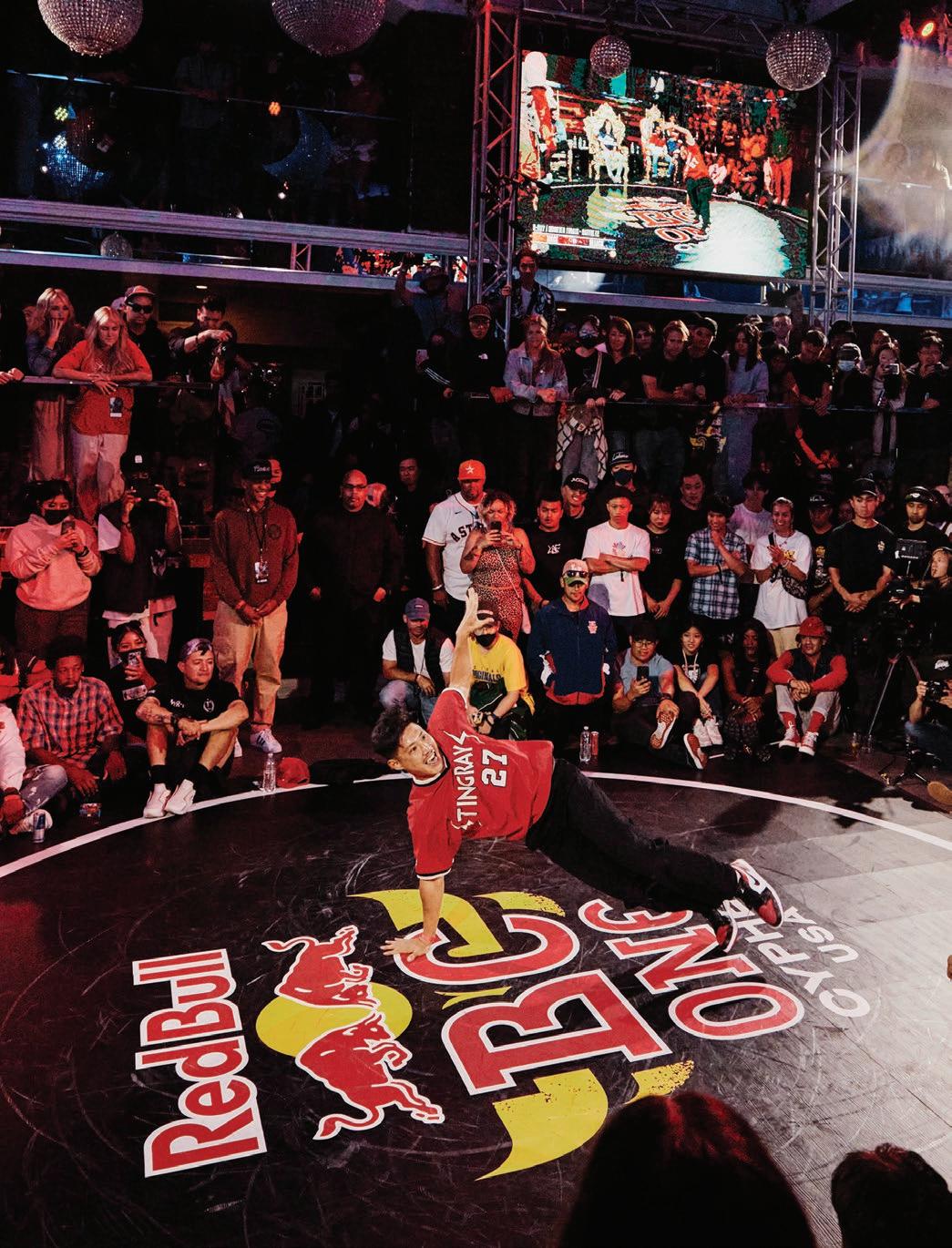
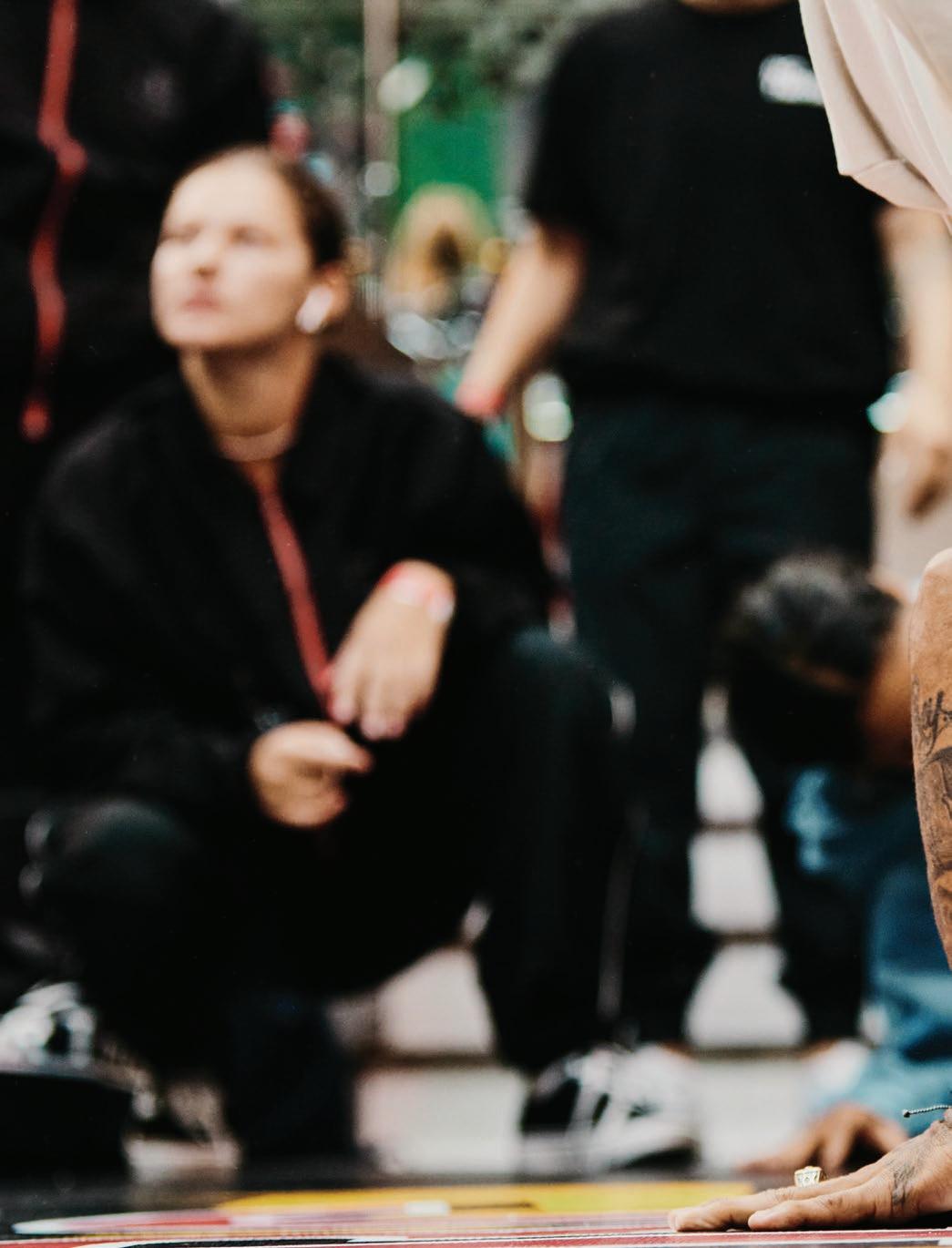

air, or spinning on his head, he could be one of two people. There’s Jack Rabanal the artist, the playful discoverer in search of a flow state that can unlock new possibilities in breakdancing. Then there’s Jack Rabanal the athlete, a dynamic and explosive competitor who drills with Michael Jordan-esque determination.
When he’s performing, though, Rabanal is something else, the artist/ athlete hybrid he calls HIjack, Hawai‘i’s most accomplished b-boy and a veteran of nearly every major international breaking competition. HIjack had a banner year last year: He won a Red Bull event in Boston and was a semifinalist in last year’s Red Bull BC One USA Cypher. HIjack’s performances have earned him a sponsorship deal from the billion-dollar energy drink brand.
HIjack is one of the world’s most exciting breakdancers at one of the most exciting times to be a breakdancer; Red Bull hosts regional, national and world competitions throughout the year, and breakdancing is set to make its Olympic debut at the Paris Games in 2024. But if you ask HIjack about how breakdancing has changed, you get the sense that in some essential ways, not much—at least for him. He loves dancing for its creative energy and ebullience, and he still gushes over its possibilities with the same inexhaustible fascination he had as a kid. It’s been that way since his older brother introduced him to breakdancing nearly twenty years ago.
“My older brother was the fire that powered me,” says Rabanal. “When I was in third grade, he learned some moves from some homeless dudes at the park. They let him borrow a CD called Street Jams Volume 2, a megamix of electrophonic funk.” Rabanal’s brother showed him the moves he’d learned—a style called popping, a slower, smoother cousin of the more frenetic and acrobatic breakdancing. “Then my brother introduced me to this magical thing called YouTube,” Rabanal says, “and I went in.”
Rabanal, then 8 years old, embarked on a self-directed online crash course in breakdancing, mimicking what he saw on the computer. But at that age, who can tell the difference between a budding lifelong passion and a passing childhood obsession? So Rabanal’s parents signed him up for karate lessons to keep him busy. The martial art itself didn’t stick, but its teachings—the discipline, the physical self-mastery— left lasting imprints. “I hated karate,” Rabanal says, “but I took away a certain discipline from that experience. If I wanted to get to the next-color belt, I had to put in work. I translated that into this art form.”
When Rabanal was in eighth grade, his brother, fresh off of getting his driver’s license, took him to a breaking competition in the Honolulu neighborhood of Kalihi. Seeing b-boys perform up close sent his mind spinning, and his body hasn’t been far behind. “It was amazing to see local b-boys who weren’t that much older than me at such a high level,” Rabanal says. “And to see it in person was a whole ’nother beast.” At the competition he also met Skillroy, an Island b-boy pioneer who would become his mentor. “I was so intimidated and shy,” says Rabanal. “Skillroy was the first person I ever saw in a cypher, and he brought me into it. I was too scared to dance, but he brought me out.”
Breakdancing was born in New York City in the 1970s, one of the original elements of hip-hop culture—the others being DJing, MCing, writing (graffiti) and, some argue, beatboxing. Hawai‘i was an eager and early adopter. Legendary crews from Los Angeles and New York made routine stops to perform in Honolulu in the early ’80s, and in 1984 a local TV station aired a weekly breakdancing show, making Hawai‘i one of the only states in the country to regularly broadcast breaking on basic cable. Still, the OG class of local b-boys and b-girls was isolated from hip-hop’s cultural hubs on the Mainland and went mostly unnoticed by the broader culture. HIjack is an incredible talent, but he has also


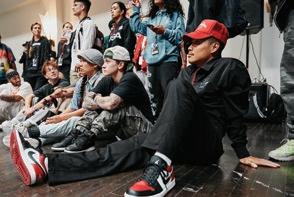
When he’s not competing on the national stage, HIjack is cultivating the breakdancing scene back home by hosting events and teaching kids through his school, Keiki Breaks. “It brings hope to our community,” he says, “hope that if we believe in ourselves, we can do this. We got style and flavor and aloha.” On the previous spread, b-boy Gravity from Brooklyn performs a headspin at the Red Bull BC One USA Cypher. Above top, HIjack and Conrad in Los Angeles. Above middle, b-boy Sleepy Joe from Las Vegas, mid-freeze at the Melting Pot b-boy event in Honolulu. Above bottom, b-boys and b-girls await the start of the USA Cypher in Los Angeles.
68


Minato from Keiki Breaks freezes while balancing on one hand in the Melting Pot.
benefited from simply being born later, at a time when breaking has become a worldwide phenomenon sponsored by major companies and, now, an Olympic event. HIjack says he’s grateful for the intersection of luck, skill and dedication that has made him an elite b-boy, but he’s not content with just that.
“A lot of our OGs were never able to leave Hawai‘i,” says Rabanal. “I feel like I’m here to do this for our community so that whoever is after me can take it even further.” In 2016, Rabanal founded Keiki Breaks, a crew of local b-boys and b-girls between the ages of 5 and 16. Through Keiki Breaks, HIjack passes on what he learns. “Jack isn’t just a breakdancing teacher,” says 15-year-old Kaimana Domen, a b-boy in Keiki Breaks. “He gives us life lessons. The hard and challenging part of breakdancing is what makes it fun. You keep failing, but once you get it, it’s the most rewarding thing ever.” Domen had been breaking for a few years before linking up with Keiki Breaks. Since then he’s traveled with HIjack to compete in major events on the Mainland and Europe. “We’re planting the seeds and seeing the fruit,” says Rabanal. “Even if I go out to the US Finals and lose in the first round, I still take home some of that energy and give it to my students. It brings hope to our community, hope that if we believe in ourselves, we can do this. We got style and flavor and aloha.”
This is the motivation HIjack carries into this year’s US Finals in Los Angeles. Last year Rabanal was among the final four, narrowly losing in the semifinals to the b-boy who would go on to win the whole thing. This time around, HIjack is taking his preparation
to another level: a strict exercise and dietary regimen on top of a rigorous practice schedule. “It’s important to have both the artist and the athlete to raise my game, but right now this is the job of the athlete,” he says. A typical day of training includes waking early to warm up with light exercises before moving to strength training and calisthenics in the afternoon, topped off in the evening with a few hours of imprinting different maneuvers into his fast-twitch muscle fibers. “When I train I’ll practice a move forty or fifty times by itself. Then I put moves together in combos and drill them over and over. It doesn’t feel fun, but when it’s game day, that’s when the artist gets to play.”
While HIjack is focused on athleticism, play is also vital to his preparation. “It can’t all be competitive,” he says. “I create, envision and dream like an artist, but I train like an athlete. It’s two separate identities. There has to be balance between letting loose and letting go, focusing and getting lost in the moment and finding that flow and freedom.” Playing gives him the freedom to fail—creatively. “You have to attempt things you’re not ready for. In that vulnerability you stumble across things. A lot of the signature moves I have are from screw-ups.”
If he can perform at the US Finals with the freedom of an artist and the focus of an athlete, there’s no reason he couldn’t win it all. “A lot of dancers haven’t yet found that separation of identity, or they aren’t conscious of that separation,” HIjack says. “Most b-boys come in with the athlete mindset, so they look like there’s no feeling. They do amazing movements, but it looks like they were doing that two weeks ago in a gym. Someone who’s completely free in the moment, they’re also executing dynamic movements, but there’s this feeling they give off. People remember how you make them feel, and that’s my goal with my dance: have them remember how I made them feel.”
In the quarterfinals of the Red Bull BC One, HIjack goes up against Mace from Arizona, a b-boy built like a gymnast whose aggressive power moves and high-octane footwork overwhelmed his opponent in the first round. The beat kicks in, and HIjack starts rocking as if the DJ dropped it directly into his veins.
Mace extends his arm, inviting HIjack to go first. He obliges, shuffling his feet in delicate rhythm, like he’s trying to slink out the back door unnoticed. He corkscrews his legs, spins and drops to his knees, then bounds up like a hip-hop ballerino. Mace starts talking over the beat. “Look at me!” he taunts, gesturing to his eyes. HIjack smiles, tosses his red hat aside and hits the floor, posting on his hands and swinging his legs underneath him like he’s preparing for liftoff. Then he lifts off, fully outstretched with his feet in the air before landing into a shoulder roll that somehow melts into a headspin.
Mace steps out, dusting off his hands like he has to clean up what just happened. There’s a reason these competitions are called battles, and Mace is letting everyone know he’s here to fight. He jumps straight into his strengths: acrobatic headspins on the floor with his legs extended upward, mimicking some of the power moves HIjack just performed. He pauses for a brief top rock, then goes back to the floor, kicking his legs inches in front of HIjack’s face. HIjack removes his jacket, revealing a red Maui Stingrays jersey, a now-defunct minor-league baseball team. (“I want to have Hawai‘i on me every time I battle on a big stage,” he says.)
HIjack drops to the ground, holding himself up with one hand while the other is tucked behind his back. He propels himself into the air, spinning into a cartwheel before landing back on his one hand, the other tucked the entire time. He gets up and thumps his chest. “I can do that,” he says pointing at Mace. “Can you?” HIjack doesn’t wait for a reply. He drops to the floor again, tucking his legs into himself until they reappear in the air behind or above or around him. When HIjack finds his groove, all prepositions are possible.
Mace immediately gets in HIjack’s face, fake-punching him and shoulder spinning right in front of him. When he flips to his feet, he gestures like he’s putting out a cigarette. Without missing a beat, HIjack picks up the invisible cigarette and tosses it aside. Both b-boys deploy their best acrobatics with supreme swagger, but as soon as the battle ends, they embrace, smiles stretching across both of their faces. Cockiness is part of hip-hop culture, but at the end of the day, the best see in
70
Above, Keiki Breaks b-boy Elijah performs a freeze in the Melting Pot, an annual breakdancing event thrown by 808 Breakers. On the facing page, b-boy
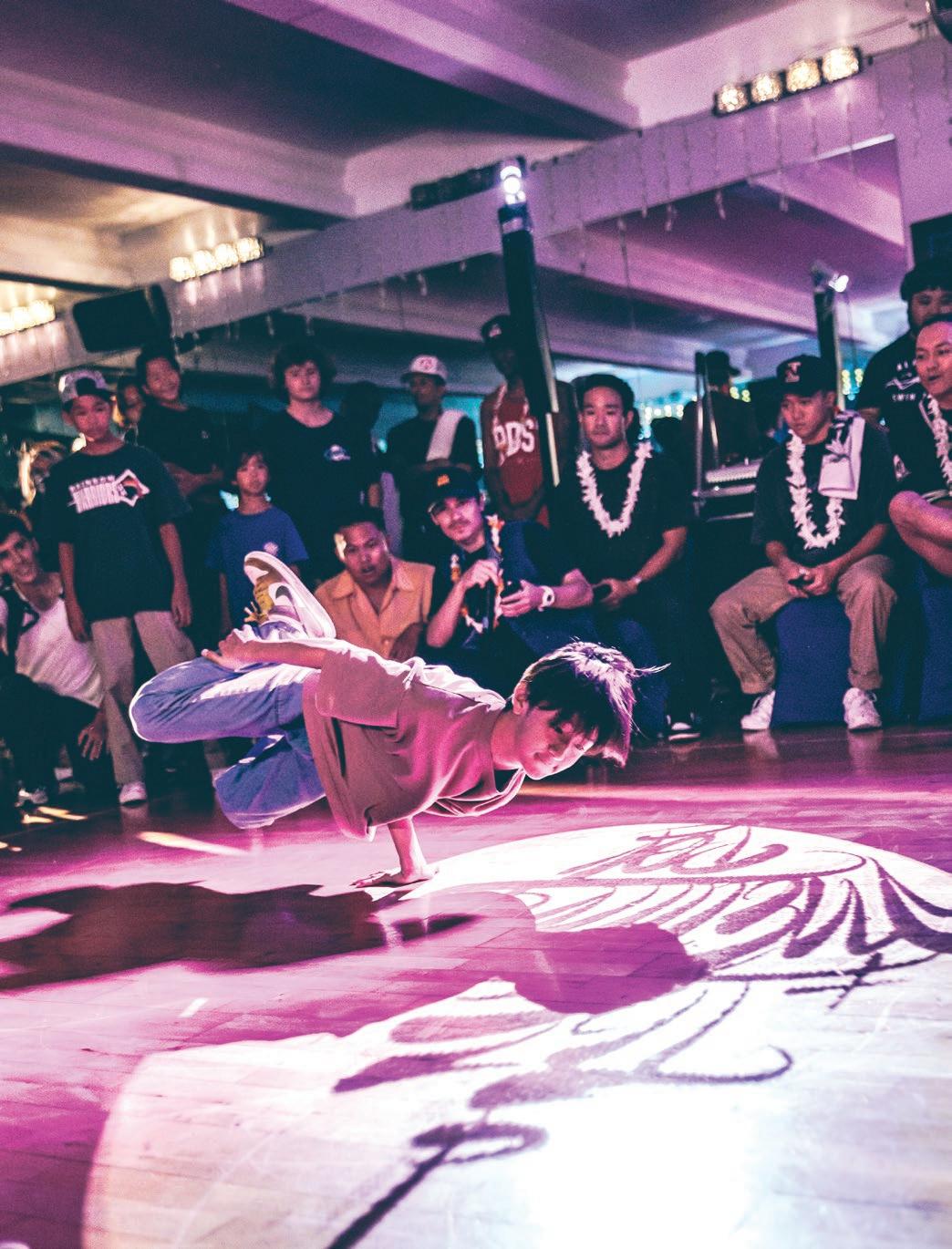

“People remember how you make them feel, and that’s my goal with dance” says HIjack, seen above before the USA Cypher in LA. “Have them remember how I made them feel.” On the facing page, b-boy Lyric from Keiki Breaks executes a headspin in the Melting Pot in Honolulu.
one another the love and determination they share. Up on the thrones, two of the three judges are pointing at HIjack.
“I like starting it off,” HIjack says, “setting the tone and having people react to me. I like to go out guns blazing and hit you with my best shot, like, ‘What are you gonna do about it?’ When a song plays and both dancers don’t go out, it’s disrespectful to the DJ. If I’m confident in my skill, I’m gonna go in.” HIjack was the only one in the final four who went first in each of his battles. Even in the exhibition crew battle that took place before the semifinal rounds started, both teams stalled to go second.
In the semifinal, HIjack is up against Ali from Salt Lake City, Utah. Ali steamrolled his opponent in the first round and won a competitive battle in the second. When the beat kicks in, both wait for the other to start. Ali paces, crossing his arms in front of him while HIjack bobs to the beat. The DJ loops the beat as MyVerse chirps in every few seconds: “Who’s going first? Who wants it the most? Is it Ali? Is it HIjack? Are we doing this?” After nearly a full minute, HIjack goes.
He sets the tone with a little runningman top rock before jumping in the air and landing in a shoulder slide. He moves to footwork, kicking in the air before freezing in a backbend and looking directly at Ali. Ali seizes the moment and waves off HIjack as he steps onto the floor. His top rock is fast and aggressive, setting him up to baseballslide across the floor into a series of
shoulder rolls before freezing while balancing on his head. He pops back to his feet, holding HIjack’s gaze, arms open as if to say “come and get it.” As HIjack steps in, Ali fakes throwing a Muay Thai elbow in his direction. After the first round it’s anyone’s battle.
HIjack immediately grabs his left foot with his right hand and somehow twists through the space between them without letting go. He shoulder rolls right in front of Ali, who responds by waving his hands close to HIjack and stomping his foot right next to his head. This is allowed, so long as you don’t make contact or interfere with an opponent. HIjack spins back to the middle of the floor with some intricate footwork and ends his round grinning at Ali. The crowd reacts with oohs and aahs and “Did you see that?” It seems like HIjack put the battle away, but Ali still has one more round.
Ali jumps close to the judges, whipping a bandanna in front of him like he’s carving calligraphy in the air. He tosses it aside and finishes the round with clean, technical footwork. It’s a solid if not spectacular performance. The biggest response in the room comes from HIjack, who claps approvingly before walking across the stage to embrace Ali.
A breakdancing competition feels a lot like a sporting event. The competitive intensity and reactive energy from the audience is the same as in any sport. Everyone is there to be entertained and surprised, to see top talent compete at their peak. But breaking is in other ways decidedly not a sport, with winners selected only by judges, without points and without an objective system of evaluation. Even the structure of breaking competitions, where some have to compete for a spot and others are simply invited, lacks the meritocratic process we expect from sports. “Art is subjective,” HIjack says. “It’s not for everybody’s taste. We just hope it’s what the judges prefer. The real opponent is myself.”
When the judges decide, two arms are pointing at Ali.
Ali goes on to win, earning him a place at the Last Chance Cypher and a shot to compete for the World Championship in New York City later
this year. For HIjack it’s a repeat of last year, losing in the semifinals to the eventual champion. But even when history rhymes, it’s still history: HIjack was the first Hawai‘i b-boy to make it to the semifinals of a national finals event, and now he’s the first Hawai‘i b-boy to do it twice. His career is far from over, so he still has plenty of time to create a legacy beyond the history he’s already made. Kaimana Domen draws nothing but inspiration from HIjack’s performance. “Whenever I see Jack compete, it makes me so happy,” Domen says. “I see him beating all these people, and I’m like, I could do that. I just need to train more, become better. If you train with the best, you get better. Jack is one of the best.”
Still, a loss always stings. In the weeks after the event, HIjack guesses he reviewed his semifinal rounds “at least four hundred times,” he says. “I’m a great freestyler, listening to the music and playing off of it. What I lack is the organization. I have a lot of moves, but they’re not quite organized.” One of the big takeaways, he says, is to be more patient and strategic. “The person who goes last, the judges remember him more. I’m learning now that it matters, there’s a whole strategy to it. Let the other person go first, let me see what I’m up against.”
It’s hard not to think that maybe just a little bit more here or there would have been enough. It’s frustrating, but it’s also hopeful for self-tinkerers like HIjack. Now it’s about learning from his defeat. He’s not slowing down: He’s flying out to Belgium and Switzerland for other b-boy competitions and then to the World Finals, even though he won’t be competing. Next year the Olympic trials begin, and of course there’s always next year’s national finals, too. Breaking might feel like a sport, and the dancers are definitely athletes, but in the end it’s about art: creating something beautiful for everyone who witnesses it.
“My main intention was to make a statement for Hawai‘i, and I feel like I repped Hawai‘i well,” HIjack says. “I want to take this as far as I can take it, so that whoever is next up after me will take it even farther and let the world know that Hawai‘i got soul. And Hawai‘i can win.” hh
72

Longboard Idyll The regulars at Queens find surfing perfection
WORDS BY BEAU FLEMISTER
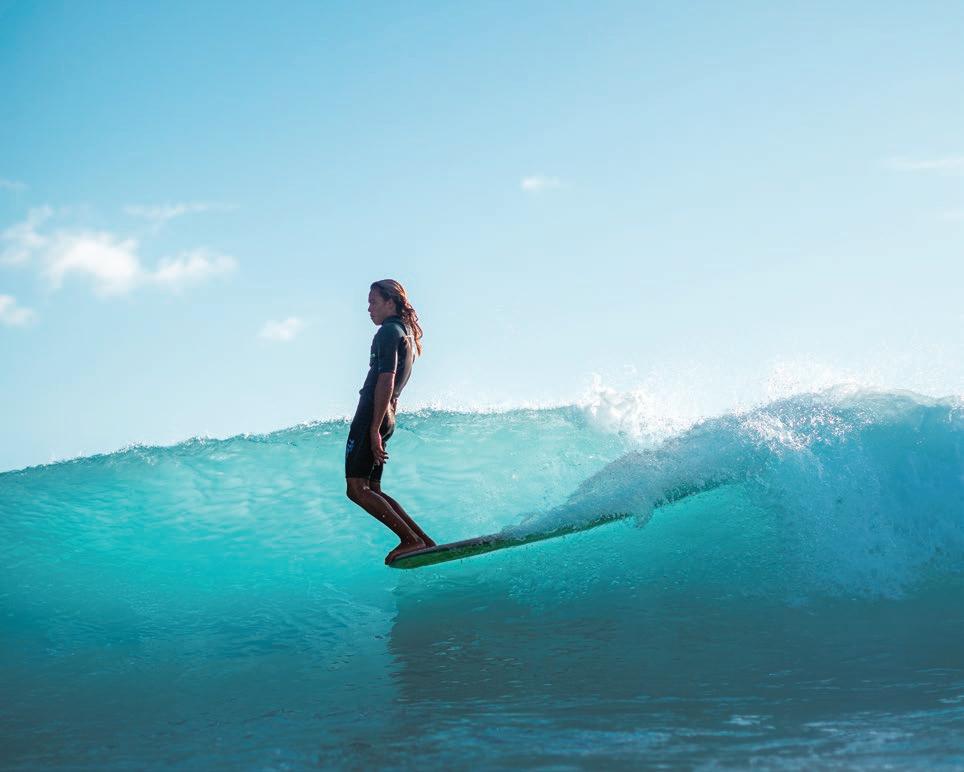 PHOTOS BY TOMMY PIERUCKI
PHOTOS BY TOMMY PIERUCKI

Perhaps it’s because there are rideable waves year-round even though nearby surf breaks snooze through the winter season. Or maybe it’s that singular shade of blue even Pantone can’t replicate. Or the way the hotels lining Kalākaua Avenue buffer the offshore winds, creating a wave of perpetual glass. Or maybe it’s all of these qualities that make Queens such an exceptional break, one that, generation after generation, is the wave of choice for a community of truly elite longboarders. Named for Queen Lili‘uokalani, who had a house on the beach fronting the wave, Queens has been home break to generations of Hawai‘i board riders, from pre-contact ali‘i (royalty) to the father of modernday surfing, Duke Kahanamoku, to beachboy Rabbit Kekai, to contemporary world champions like Bonga Perkins and Kelia Moniz.
“What’s truly unique is how many there are at Queens now,” says Waikīkībred pro longboarder and shaper Kai Sallas. “When I was young, there were a lot of good longboarders around, but not necessarily from Waikīkī. So what stands out to me is how many worldclass longboarders are raised on this very wave—there’s no place in the world with that much talent all coming out of the same spot.”
He’s not wrong. Kelis Kaleopaa won the US Open of Surfing in August, finishing number two in the world by year’s end. Her cousin Kaniela Stewart nearly won the men’s world title (just shy by 0.37 point) last October. Kelia Moniz is a two-time World Surf League World Longboard Champion. All of them— with a dozen other young local surfers nipping at their heels—honed their skill at Queens.
OPENING SPREAD LEFT
“Queens is where I feel the aloha spirit the most,” says John van Hohenstein, a.k.a. “Johnny the Ripper,” seen on page 74, hanging ten. “You’re surrounded by all the love and energy from aunties, uncles and all the past generations of surfing and history, knowing you’re in the heart of where it was all born. To say that I am blessed to be a part of such a tradition would be an understatement. Knowing I’m surfing where some of the greatest longboard legends have surfed and realizing I get to inspire the next generation to carry on the legacy is why longboard surfing will forever be in my heart.”
OPENING SPREAD RIGHT
A classic Queens party wave
FACING PAGE
“This place is so important because it is the birthplace of [modern] surfing,” says Kelis Kaleopaa, seen on the facing page and also on the following spread. “This is where our kings and queens used to surf back in the day, so it’s only proper that we, as people who were born and raised here in Waikīkī, continue that on through our future and the younger generations’ future. The best we can do is learn through the generation above us and teach the generation below us.”
76
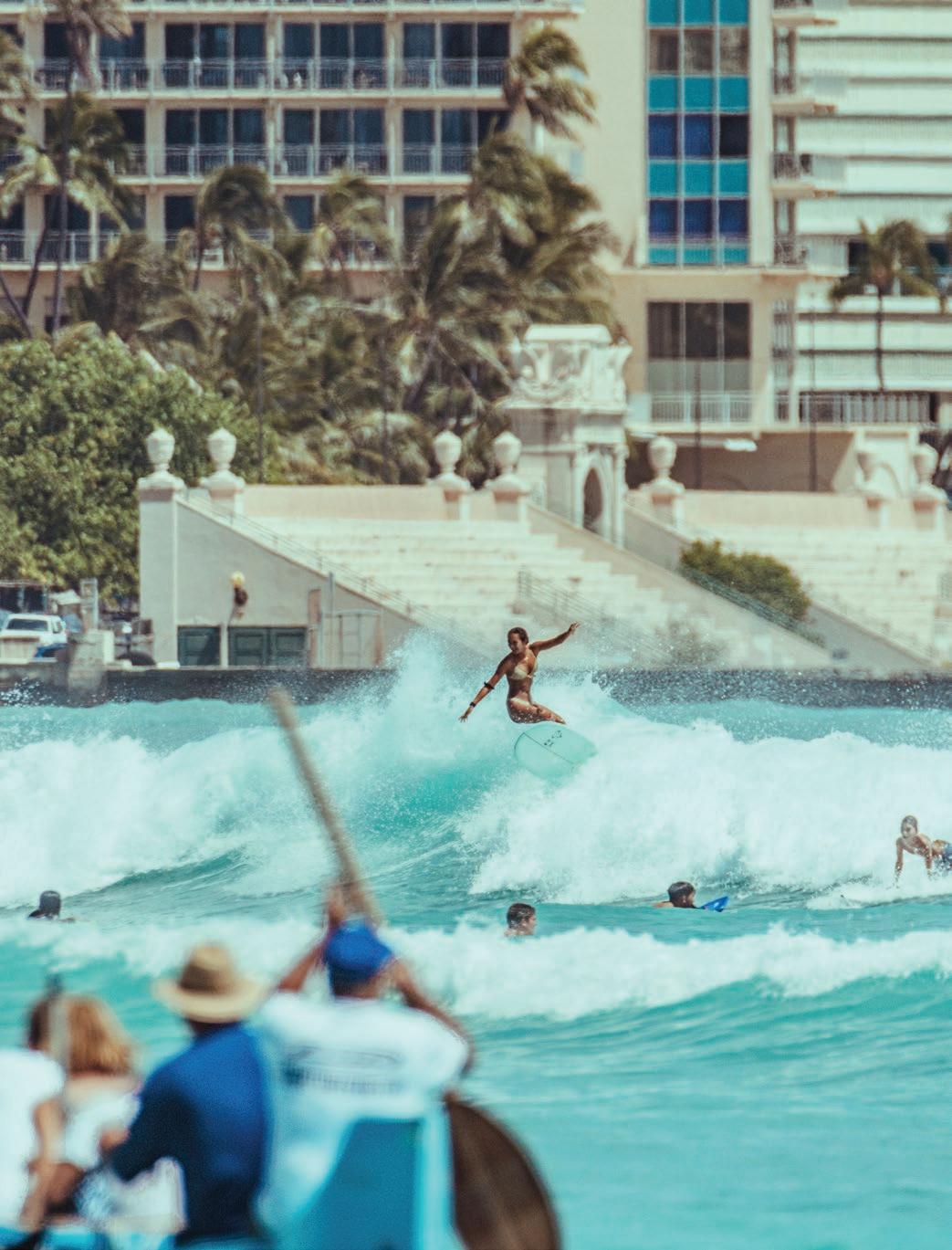


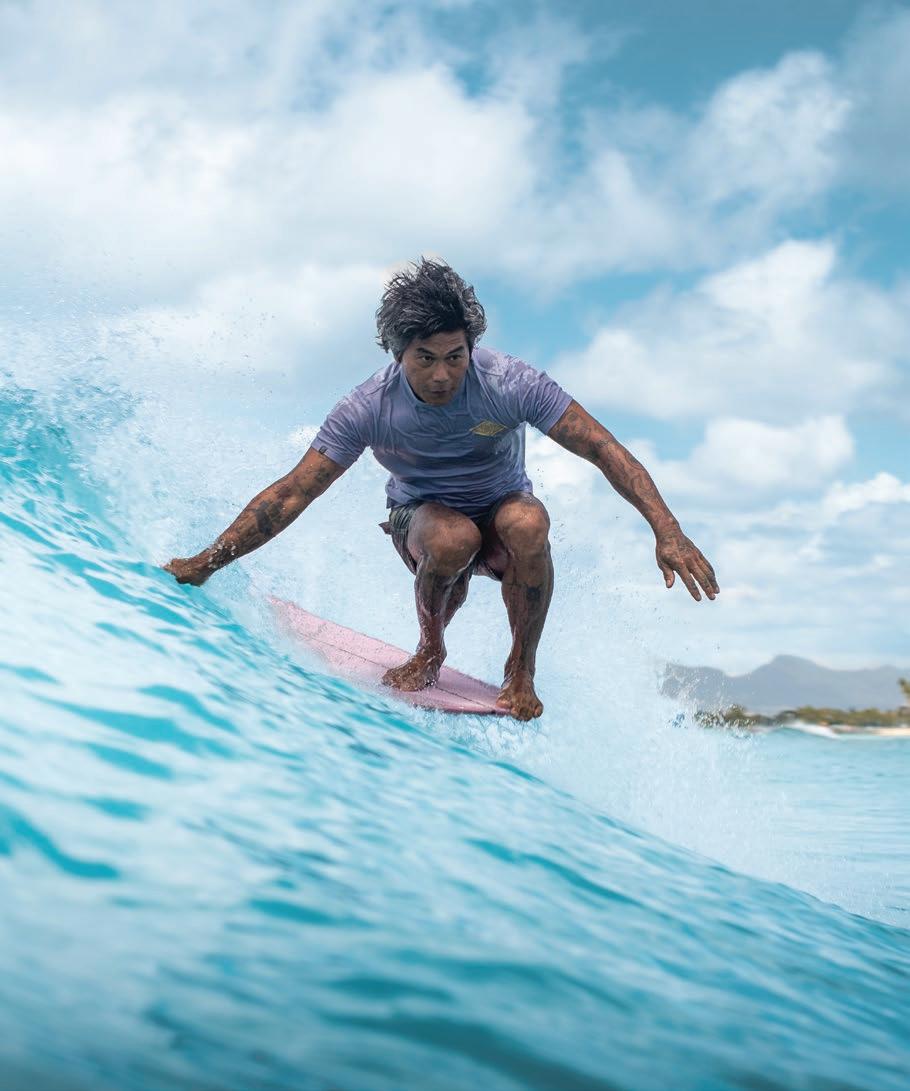
“Queens is such a special surf break. It’s where Hawaiian royalty surfed back in the day, and all the surfers that influenced me heavily have surfed here,” says Arthur “Toots” Achinges. “With the resurgence of the longboard scene, it’s producing a pool of very talented young and upcoming world-class surfers. But Queens is home. It’s where I learned to surf, and it will always be a very special place for me. Despite visiting and surfing some beautiful and unique places while traveling, Queens will always be the place that changed my life.”
80

“I love how good and fun the wave can get for all types of board riding,” says Queens regular Hana Ito. “I appreciate the respect the people have for each other, and we all enjoy this spot together. Learning and understanding the simple unwritten rules makes it easier and safer for everyone to have fun. I think the uniqueness of Queens is that the wave can accommodate all different levels, from novice to professionals. It is nice to see that we all share waves and have fun together. This makes it feel less of a scene and more of a tradition. Aloha lives forever.”

“What I love most about Queens is that it’s such a world-class wave,” says Kaniela Stewart, pictured above handstanding during a tandem ride with Keani Canullo. “Queens is so unique and it has many different personalities. Small waves from the east-southeast turn Queens into a little right-hand point break. Waves over five feet from southsouthwest turn it into a barreling left. What makes the Waikīkī surf scene truly unique, though, is the family and the connection we share —this love for the ocean and the love for the sport of surfing. Also, we all are such good allaround watermen and women no matter what type of craft we are on. To have that is such a blessing.”
82

“Queens is such a perfect longboarding wave—it has very fun, smooth rides that are excellent for noseriding,” says Nique Miller, pictured above cross-stepping down a personable Queens southeast right-hander. “I’m super stoked to carry on the longboard tradition here in Waikīkī. To me it’s an honor to surf here and represent this part of Hawai‘i to the world. I feel like longboarders from Waikīkī are known for their precise footwork and elegant maneuvers, so I really try to display that quality in my surfing.”
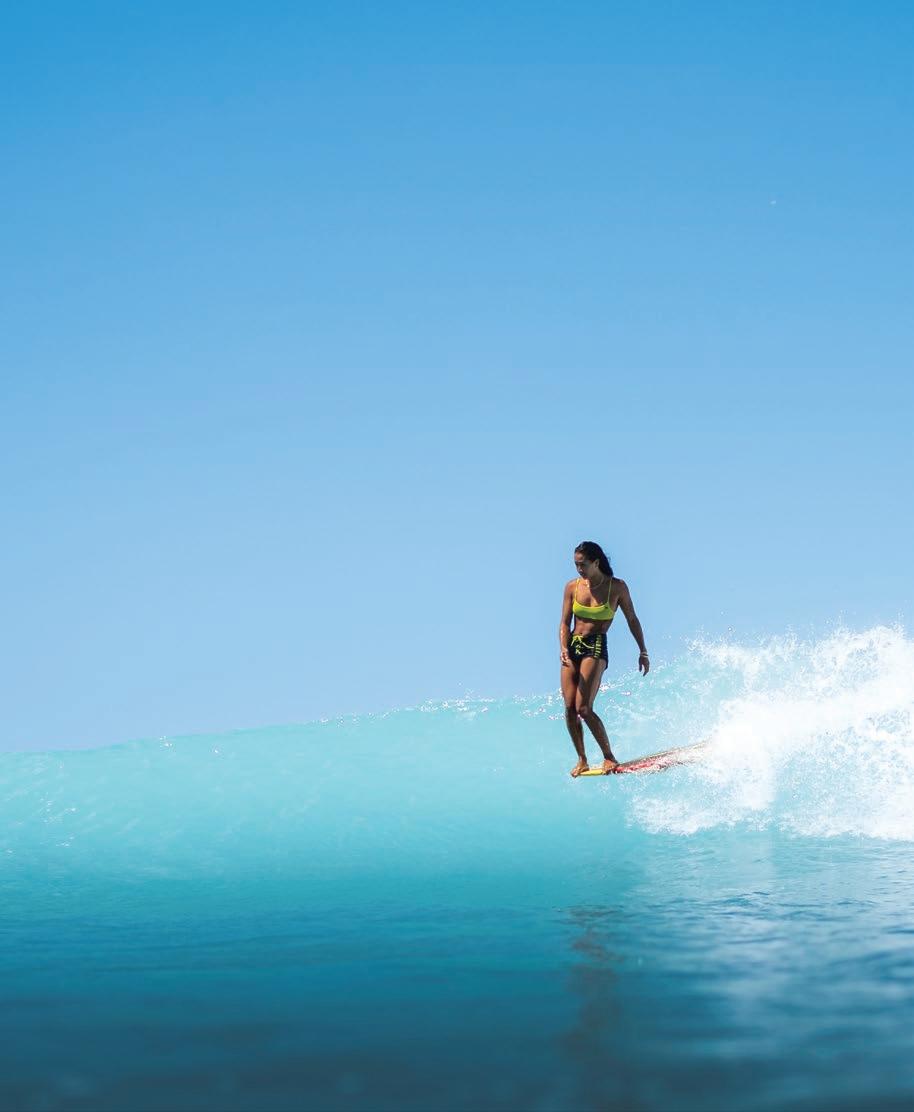
“There’s something about this place that will never get old,” says Kelia Moniz. “I don’t think I’ll ever be able to tell you what it is. The people? The surf? The beauty? The surf heritage? The fact that it’s home to me? Whatever it is, it’s magic. I’ve traveled the world and have yet to find a place that has left a mark like this magical place has left on me. Home forever, and forever grateful to call this wave my home.”
84

Remote Work
Architect Craig Steely is creating modern homes amid the lava flows and ‘ōhi‘a forests of Hawai‘i Island

86
SCHULER PHOTOS BY VINCENT BERCASIO
STORY BY TIMOTHY A.


Architect Craig Steely designs modern homes meant to be integrated with the landscape and weather of Hawai‘i Island’s remote areas. The D-Fin House in Ka‘awaloa (seen above) responds to the panoramic views with a circular form anchored by a protruding, triangular loft resembling “an old D-Fin skeg,” Steely says, referring a type of surfboard fin. “And really, it functions the same way. You’ve got this big, curving shape that wants to move, and you need to start creating direction. Having that big, strong skeg at the top just locks it in.”
If asked where the epicenter of Hawai‘i‘s architecture and design scene is located, the obvious answer would be Honolulu. Where else can a person have lunch in a Julia Morgandesigned café? Or soak up skyline views from mid-century master Vladimir
Ossipoff’s Liljestrand House? Or bask in the Brutalist beauty of Victor Gruen’s Financial Plaza of the Pacific, a concrete sculpture the size of an entire city block? And yet for all of the city’s offerings, some of Hawai‘i’s most original architecture over the past twenty years is not in Honolulu but two hundred miles southeast, in the verdant,
violent wilds of Hawai‘i Island.
Here, amid fields of pāhoehoe lava and old-growth ‘ōhi‘a forest, 58-year-old architect Craig Steely has been building a portfolio of bold, unapologetically modern houses, no two of which are alike. Some seem to float in the forest canopy; others hide in plain sight—simple boxes that belie the dynamic interplay of light and
PHOTO BY DARREN BRADLEY
88
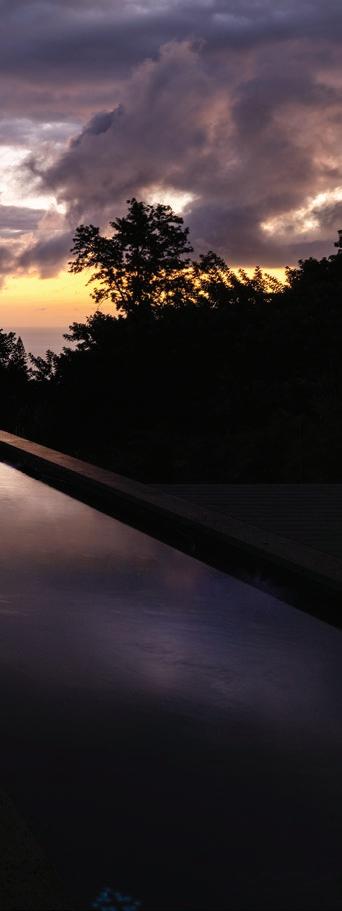
shadow taking place inside. Some look like spaceships fallen from the sky. What unites them is their sensitivity to place; Steely’s work eschews the stereotypical hallmarks of contemporary Hawai‘i architecture—double-pitched roofs, Polynesian patterns, black basalt— responding instead to the land and history of the Islands in ways that are not always



immediately apparent. “I’m interested in projecting in my work deeper connections to Hawai‘i,” Steely tells me. “Some laser-cut sunscreen that looks like an ‘ulu [breadfruit] is just embarrassing.”
“He’s not trying to do something that looks like it belongs in Hawai‘i, as an aesthetic or a form. He’s designing spaces that [work] in Hawai‘i,” says Graham Hart, assistant professor of architecture at the University of Hawai‘i at Mānoa and cofounder of the boutique design firm Kokomo Studio. Hart first saw Steely’s work while a student at UH. He admired the architect’s restraint. Spatially, the houses were simple yet sophisticated. They nodded to midcentury modernism and other styles without feeling derivative or dated. They were one of a kind.
“If you were to put together a list of the best architecture to come out of Hawai‘i in the past decade, the top five would have at least one or two Craig projects on it,” Hart says. At the same time, the place Steely occupies in Hawai‘i’s design scene is, like each of his
houses, unique, Hart says. “A hundred years from now, or whenever we start doing retrospectives on contemporary Hawai‘i architecture, I think he’s gonna be in his own box.”
Steely grew up on a walnut orchard in the foothills of the Sierra Nevada. He remembers his childhood house as an ever-changing amalgamation, perpetually under construction to meet the family’s needs. “It was always being added onto,” Steely says. “The entry room became the dining room. The kitchen expanded into the garage, which became another living room.” Like their friends and neighbors, his parents did much of the work themselves. “Everyone built their own houses. You needed a barn, you just built it.”
Steely was 13 or 14 when he discovered capital-A architecture on a family fishing trip up the California coast from Bodega Bay. From the water one day Steely spotted a group
of odd wooden buildings with sloping roofs, each seeming to flow into the other. It was as if they had been there all along, he thought, shaped by the same elemental forces as the rugged shoreline. “They looked like rocks just sitting out in the grass,” he recalls. It was Sea Ranch, the famous early environmentalist community developed in the early 1960s by a coterie of the era’s leading designers. The development was radical at the time for its ecological sensitivity; buildings worked in concert with the terrain, and most of the 3,500-acre property was left undisturbed. It set—and in some ways remains—the bar for inserting architecture into a sensitive landscape. It was on the same trip that Steely came across a copy of Sunset magazine. He’d already started drawing houses— quick sketches of rooflines and forms in his spiral notebook—but flipping through that issue, he had a life-changing realization: There were people who just designed houses. “It was like, wait a minute, this can’t be real,” he says.
90
Steely, 58, sits beneath the monumental roof of Musubi House (seen also on page 86), so-named for its round-cornered triangular floor plan. Steely often finds inspiration in nature and among Hawai‘i’s otherworldly landscapes—like lava fields and ‘ōhi‘a forests—or in the curl of a hāpu‘u fern fiddlehead (above left).


BY

When the teenage Steely wasn’t sketching—which his mother, a painter, encouraged—he was learning how to soup up cars from his father, whose own father owned a garage in nearby Clements. Similar to his family’s everevolving house, building hot rods taught Steely that there wasn’t much in the world you couldn’t change “to make it more the way you wanted it to be,” he says. “You could do that with anything. You could do that with a tractor. You could do that with a house. You could tailor anything to exactly the way you wanted it to be. Nothing was sacred.”
It’s a lesson Steely has applied to his career. After architecture school and a stint working in Italy—where he met his wife, artist Cathy Liu—he moved to San Francisco in 1990, where Liu was living. He had little trouble finding a job, he says, but quickly soured on the long hours and lack of creative freedom. He was fired more than once. Steely considered leaving architecture altogether and pursuing sculpture, but then he’d take
a side gig—designing a set for a fashion show or some other unconventional project—and remember how much he loved it. “I kept being dragged back,” he says. “At some point I realized that I’d been fired from the best architecture offices in San Francisco, so I wasn’t going to get back into architecture that way. I had to do it my own way.”
That meant starting—and staying— small. He opened a practice and did projects for friends. He saved money by being his own builder. “I would design something, and the contractor would say, ‘That’ll cost $30,000,’ and I would say, ‘I can do it for $20,000.’” Thirty years later Craig Steely Architecture is still mostly a one-man shop (at most Steely employs one or two other designers). He’s selective about clients and, with the exception of a ramen restaurant in San Francisco, exclusively designs houses.
He owes at least part of his success to a combination of punk-rock charisma and childlike enthusiasm. “Picture the stereotypical surfer from
San Francisco—you know, a little bit hippie, a little bit hipster, but with an encyclopedic brain,” Hart says. Indeed, conversations with Steely, who, with shoulder-length hair and a uniform of jeans and vintage t-shirts already looks more like a pro surfer than an architect, tend to be riddled with references to obscure music, books and films and peppered with big ideas. The first time I met him, at the Kaimana Beach Hotel on O‘ahu, he saw my voice recorder and began excitedly telling me about the time he bought one to make field recordings, which spiraled into a discussion of archives, entropy and the nature of time. It’s as if he never shed that teenage part of himself that unselfconsciously thrills at discovering new things. “He’s just so engaged in the moment,” Hart says. “He never runs out of energy. I’ve never seen him tired.”
In 1998, Steely flew to Hawai‘i for the first time. He’d been hired to design a house near Pāhoa on Hawai‘i Island, and on his way out to the building site,
93
Above, an interior view of the D-Fin house. Steely uses bold forms to create dramatic spaces that can feel unusual in Hawai‘i. Despite their modern sensibility and materials, however, the houses are all very much in place, a response to Hawai‘i’s landscapes and climate.
PHOTO
DARREN BRADLEY

he stopped at Pohoiki, the popular beach park and surf spot that was later destroyed during the 2018 volcanic eruption. “I remember pulling up, and there were people fishing and surfing and swimming and camping, and instantly I felt incredibly attracted to this place,” he says. The more time he spent on Hawai‘i Island, the more it reminded him of the Sierra foothills. “It was really rural, and you knew your neighbors because you had to depend on them when things broke down. There was just that sense of connection that people had to the land—and to each other,” he says.
Less than a year after beginning that first house, Steely and Liu bought a small property in Kalapana on which he built a modest residence that’s somewhere between a 1960s glass house and a Hawai‘i-style bungalow, with cantilevered rooms and floorto-ceiling glass but also a corrugated metal roof and jalousie windows. The blessing for the house and the lū‘au for their son Zane’s first birthday took place the same day. Neighbors came to help cook. “We felt so instantly included in the community down there,” Steely says. He and Liu have split their time, more
or less fifty-fifty, between San Francisco and Hawai‘i Island ever since.
Ask Craig Steely about a house he designed and he’ll start by telling you everything else: about the site’s mercurial weather, the subtle variations in topography that create eddies of wind and fog, how these inform where he puts a house. Or how he bonded with a client over their shared love of German composer Klaus Schulze and the playlist they ended up making for the project, all droney synths and pulsing beats, the juxtaposition of sci-fi soundscapes made with analog recording equipment seemingly a metaphor for the house itself.
It’s all a part of Steely’s sponge-like creative process. Most often it begins with the land. He makes repeated visits to building sites, trudging through the rainforest or picking his way over expanses of lava, sensing where the slope changes, where the light shifts, where the views begin to open—all before he draws a single line. To Steely a house should connect a person to the environment, not separate them from it. A house, he says, should be secondary to
the land it sits on. “It’s another client, in a way,” he tells me.
Architecturally, Steely’s houses have little in common with the kinds of high-end luxury residences one sees throughout Hawai‘i, most of which share a handful of stylistic touchpoints. Steely’s houses, in contrast, are specific and idiosyncratic in their influences. They respond not to a vague, nostalgic idea of “Hawaiianness” but to what it means to live right here, right now “Modern Hawai‘i’s culture is amazing,” Steely says, describing it as a panoply of Oceanic and Pacific Rim cultures that “still holds the best of the old.” For him, the idea that Hawai‘i architecture can be reduced to something visual is “completely lame and inappropriate.”
Hart recalls a lecture Steely gave at UH, which began with photos of run-ofthe-mill carports in Mānoa. “He talked about the ‘carport vernacular’ rather than the lānai,” Hart says. “Because a lot of homes don’t have properly designed lānai, but a lot of them have carports that everyone kind of lives in. And I think that understanding, like, ‘I’m not going to do something that’s referential to the Hawaiian archetype; I’m gonna do the thing that people live in, the lifestyle’— that’s what he’s designing for.”
Steely’s latest project, his ninth on Hawai‘i Island, is the 2,200-square-foot Musubi House, so named for its roundcornered triangular floor plan. Guy Brand, the house’s owner, says Steely spent countless days at the property, which sits about four thousand feet above sea level on the Hāmākua Coast, walking every square foot of its hundred acres over several years. “One time, Craig went up on his own, and there was a storm. There was a river running through the place, and he was wading through it,” Brand recalls. “I thought he would have said, ‘Yeah, f**k this place.’ Instead, he calls and goes, ‘Oh, man, this is gonna be great!’ His son, Zane, almost got washed away. But that didn’t stop Craig. … Over the course of two or three years, he got to know us, and he got the vibe of what we liked. Then, one day, a sketch comes over. And it’s like, ‘Here’s your house.’ I was like, holy s**t!”
The sketch showed an equilateral triangle nested inside a much larger triangle, forming three spacious rooms organized around a central courtyard. The sides of the outer triangle would
94
Above, Lavaflow 2, Steely’s own house in Kalapana where he lives half of the year, seems to float above a lava field, part 1960s glass house and part Island-style bungalow.
PHOTO BY JD PETERSON
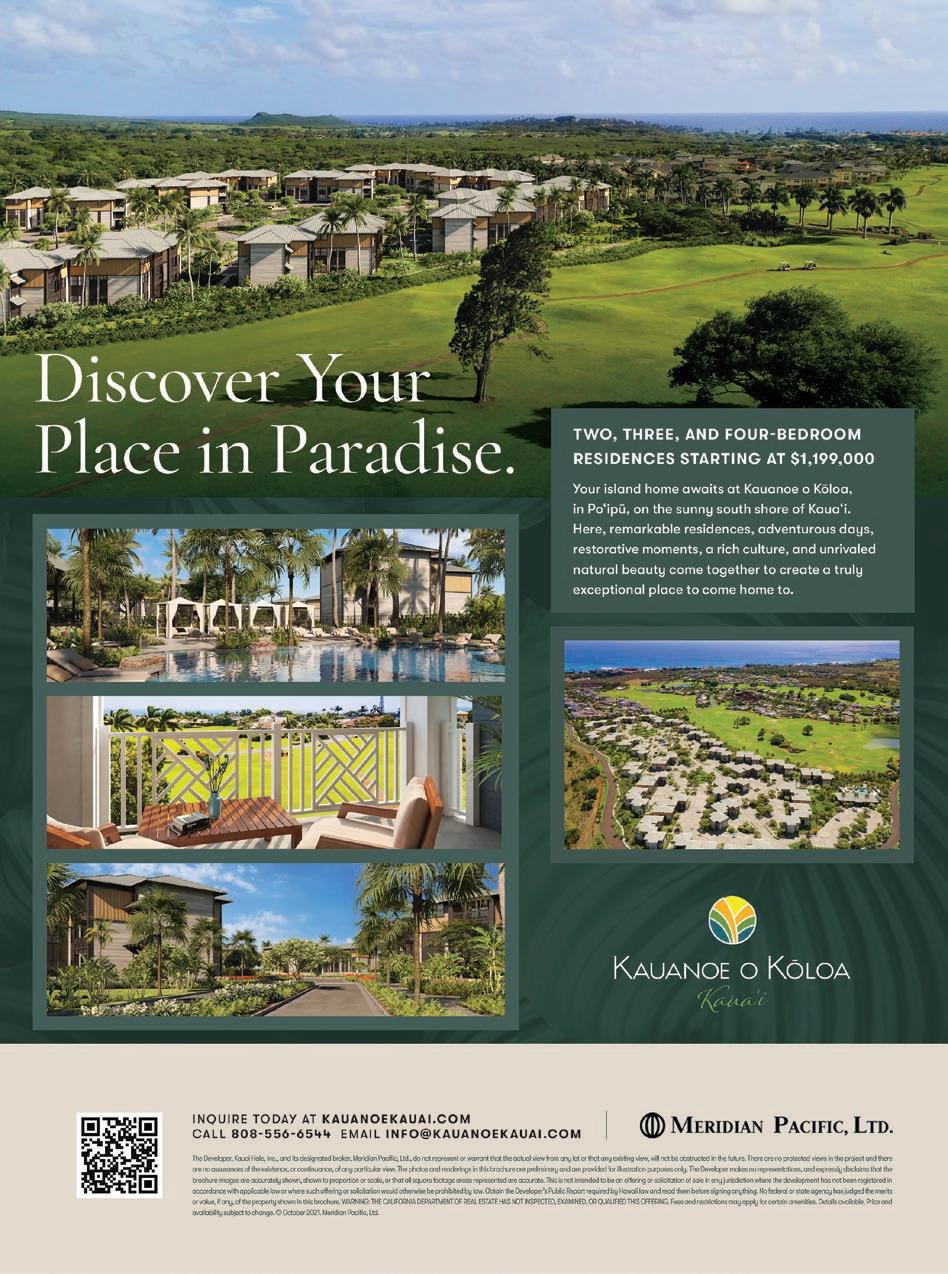

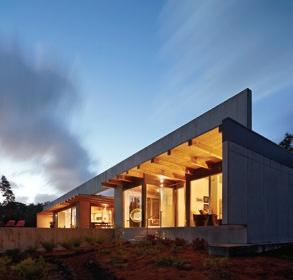
Lavaflow 7 at dusk, an example of what Steely calls “reductive architecture” that amplifies the sense of being in the environment and blurring the distinction between interior and exterior.
be glass, while their vertices would be cast-in-place concrete, and the whole thing would be topped by a monumental, diamond-shaped roof that would extend past the enclosed parts of the house to form multiple covered lānai. To Steely it was the only appropriate response to a place so dynamic. “On sites so powerful, how can you compete with it? You can’t,” he says. “So you make something that’s specific and its own thing.”
The unusual geometries have a purpose. On his visits, Steely had seen how rapidly the weather can change at that elevation. “There are times when the rain is coming horizontal and the fog is [super thick], and then other times it’s so clear and still,” he says. The house, which is completely off-grid, is sited so that its ocean-facing corner deflects the prevailing trade winds, much like the prow of a ship slices through the water. At the same time, Steely wanted to capture and even amplify the everchanging atmospheric conditions. He made the glass walls of the courtyard fully retractable, allowing whatever is happening outside to permeate the house. “I know it sounds crazy,” Steely says, “but the house really is designed to create a weather system within.”
Crazy or not, Brand has embraced this aspect of the house. “Sometimes it’s just raining in the house, and I love it,” he says. He texts me photos to prove it. Then he sends one of a wild boar on the lānai.
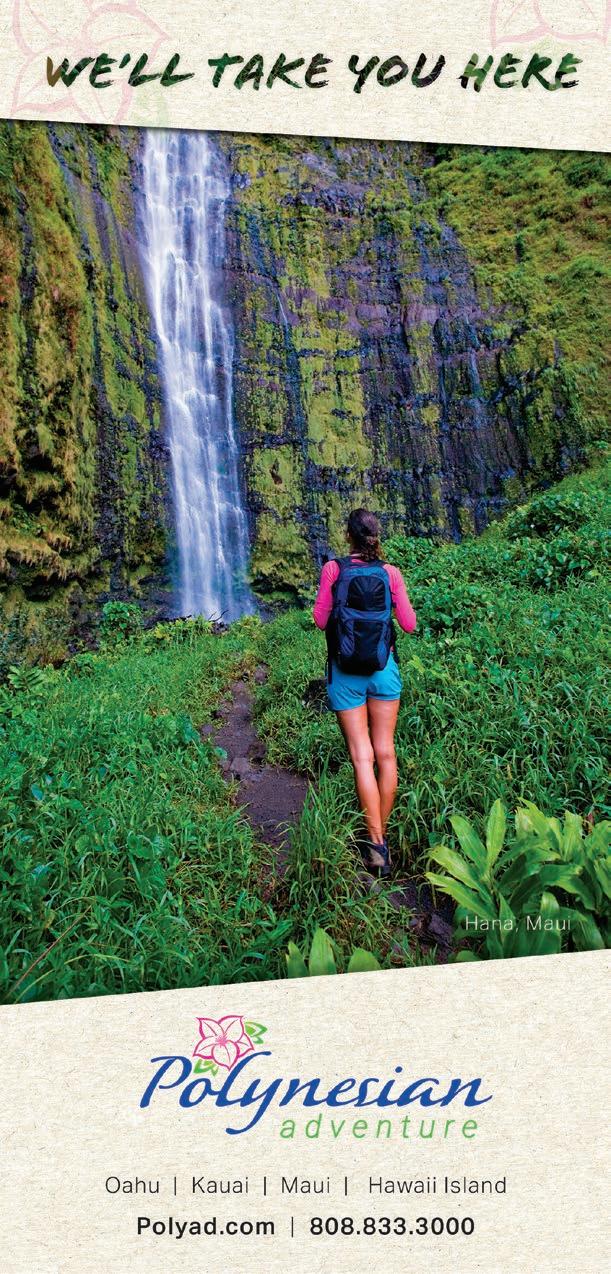

Steely’s colorful interiors often nod to the architecture and design of the 1950s and ’60s, exemplified by the conversation pit in the Musubi House seen above. Designed for a couple without children, the Musubi House has no internal doors or divisions between spaces. “It’s essentially a studio apartment,” Steely says.
As futuristic as the Musubi House feels, it is intimately connected to the Hāmākua landscape, embodying many of the same principles Steely saw in Sea Ranch all those years ago. “It’s like the whole hill is part of the house,” Brand says.
Despite Steely’s successes over the past decade—he’s been featured in magazines like Dwell, named a top
residential firm by the American Institute of Architects and is currently at work on a book of his houses—the designer is nowhere near the pinnacle of his career. For one, he’s still young. Architect years are like dog years, but in reverse. Being 50 years old and an architect is like being 35 in any other profession; at age 60 many architects are just beginning to enter their prime. “Architecture is a long game,” Steely says.
Steely tells me that the worst part of being an architect is that all of your halfbaked ideas are on display. “You leave this trail of ideas that you thought were so great, then you look back at it and you’re like, ‘Oh my god, what was I thinking?’” Steely has evolved over the course of his career, as have his houses. And yet, he says, sometimes it feels like he’s chasing the same elusive ideas. “I see one project, just different iterations on it.”
98
PHOTO BY DARREN BRADLEY

Steely hasn’t tired of the chase. All these years later, he gets the same thrill from designing. He’s still that kid flipping through a Sunset magazine, sketching houses. “Some people are good at singing, some people are good at ballet,” he says. “I feel like architecture is the best way that I can express myself. I’m still finding inspiration from it. I feel like it’s getting better and better.” hh


Visions of Atolls Floyd Takeuchi has spent a lifetime chronicling the people and islands of Micronesia
Floyd Takeuchi was a 25-year-old journalist reporting for the Gannett News Service when he went to Bikini Atoll in 1978. Three years earlier, roughly a dozen families had attempted to resettle their 586-acre home island; they had been relocated during Operation Crossroads—the first of a series of nuclear detonations conducted by the US Navy in the Marshall Islands. The resettlement failed—the island was still too contaminated—and the hundred or so residents were being ferried five hundred miles southwest to Kili, the island where the larger community had lived since not long after they were evacuated in 1946.
The returnees were greeted as heroes on Kili, where a new generation of Bikinians was growing up having never set foot on their home island. It was then that Floyd had an epiphany. Parts of the Marshall Islands were becoming the stuff of stories and dreams: Some places had literally disappeared—three islands in Bikini were completely vaporized by the nuclear detonations—while others, though still there, lay beyond the horizon. “It was the first time I saw up close Marshallese dreaming of their homeland in kind of mystical ways, with the understanding that they would probably never see it again.”
Floyd went on to cover significant stories over the ensuing years, including as a reporter for Guam’s Pacific Daily News and as managing editor for the Daily Post in Fiji. He traveled throughout the Pacific to interview presidents, prime ministers and kings. He covered the negotiations that led to independence for the distinct island nations commonly lumped together as Micronesia: the Marshall Islands, the Federated States of Micronesia, Palau, Guam, the Northern Mariana Islands, Kiribati and Nauru. He served as news director for Hawai‘i Public Radio’s statewide network and as a foreign correspondent covering Asian financial markets for Bloomberg news in Tokyo. In 1997 he returned to Hawai‘i from Japan to become editor-publisher of Hawaii Business Magazine and president and COO of its parent company, which was then known as PacificBasin Communications. Eventually, he shifted away from print journalism in favor of photography and began

STORY BY STU DAWRS PHOTOS BY FLOYD TAKEUCHI 100

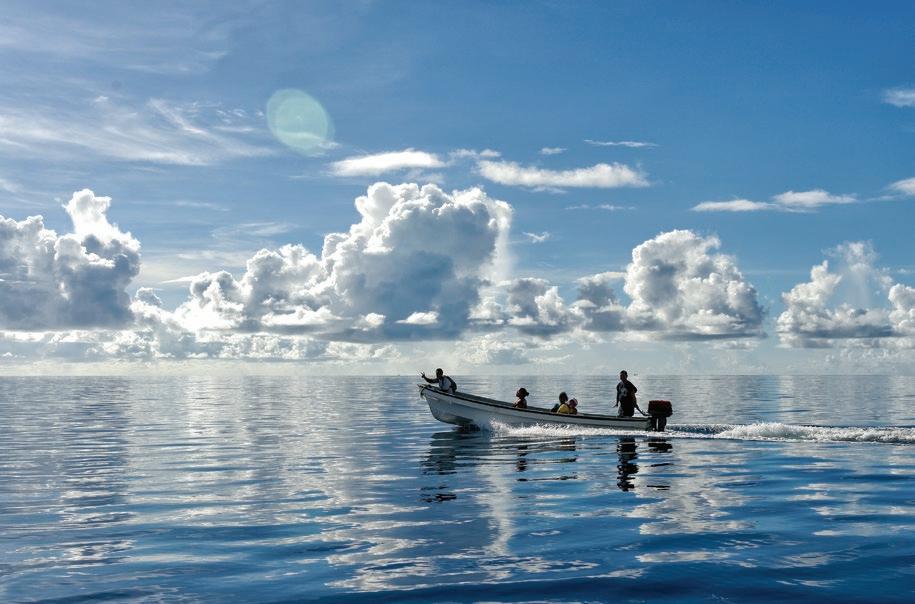
self-publishing books on a variety of subjects: School on the Hill: Micronesia’s Remarkable Xavier High School; Pasefika: The Festival of Pacific Arts; Halau: A Life in Hula among others.
Through all of this, Floyd says the memory of that day on Kili has lingered. “It’s something I’ve been thinking about for so long that it just resides in my brain.” And the island, along with the rest of the Marshallese archipelago, is something that Floyd, now 69, hopes to document before it’s too late.
Floyd Takeuchi was born on the atoll of Majuro in 1953; his brother Gary, two years later. Majuro is now the capital of the Republic of the Marshall Islands, but when Floyd and Gary were growing up, the Marshalls were still part of the Trust Territory of the Pacific Islands, a United Nationsmandated entity set up in the wake of World War II to administer the vast expanse of atolls and islands that runs
from the Marshalls in the east through Guam and the Northern Mariana Islands in the west. The Trust Territory was a temporary arrangement, existing until each island group decided on its political status after centuries of colonization by Spain, Germany, Japan and the United States.
Floyd’s parents, Clarence and Sachiko, were both born and raised on O‘ahu, but Clarence had long dreamed of other islands. “When my dad was in Farrington High School in the 1940s, he discovered Pacific Islands Monthly magazine in the library and became entranced with names like Pago Pago, Pape‘ete and Port Vila—all those exotic names of the time,” says Floyd. Within two weeks of graduating from Farrington in 1945, Clarence was in the US Army, and was eventually assigned to the Counter Intelligence Corps. He and Sachiko were married in 1952. “In the early ’50s the Trust Territory administration headquarters were at Fort DeRussy, so Dad went down
there one day just to poke around and discovered that they were looking for electricians in the Marshall Islands. He put his name in, got hired pretty quickly and initially went down there to run the power plant.”
The whole of Majuro Atoll is a bit under four square miles of land. Today its population hovers around twentyseven thousand, but in the 1950s Floyd estimates it was closer to two thousand.
“Being on Majuro was a life-changing experience for my parents: It defined their lives and gave them purpose,” he recalls. “There were maybe twelve American families … twenty-five or thirty expats in all. There was a Protestant missionary— Eleanor Wilson—and of course the Jesuits: Father Len Hacker, from Upstate New York. And that was it: All the rest were Marshall Islanders, so I grew up bilingual, and somewhere in my brain is a five-year-old’s vocabulary of Marshallese. There were hardly any cars, it was safe to go around—people kept an eye on you. It was a wonderful upbringing.”
102
Above, a taxi glides across the calm waters of Chuuk Lagoon, in the Federated States of Micronesia. For most of his career, 69-year-old journalist and photographer Floyd Takeuchi has documented the people, archipelagoes and atolls of Micronesia. His latest project might be his most ambitious: to photograph the hundreds of islets and atolls of the Marshall Islands before they disappear due to rising sea levels. On the previous page, Takeuchi’s portrait of an uninhabited islet in Chuuk Lagoon.
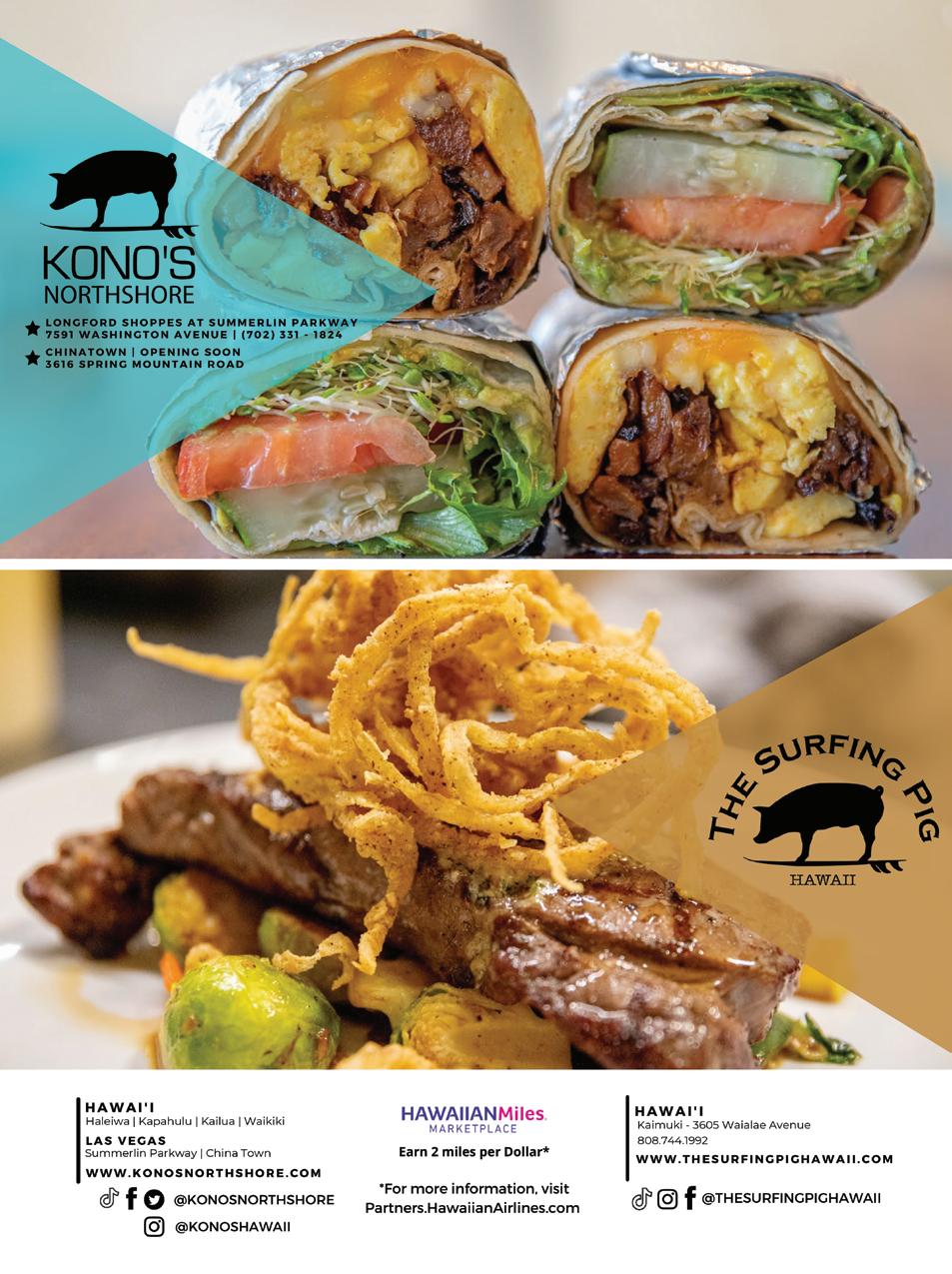

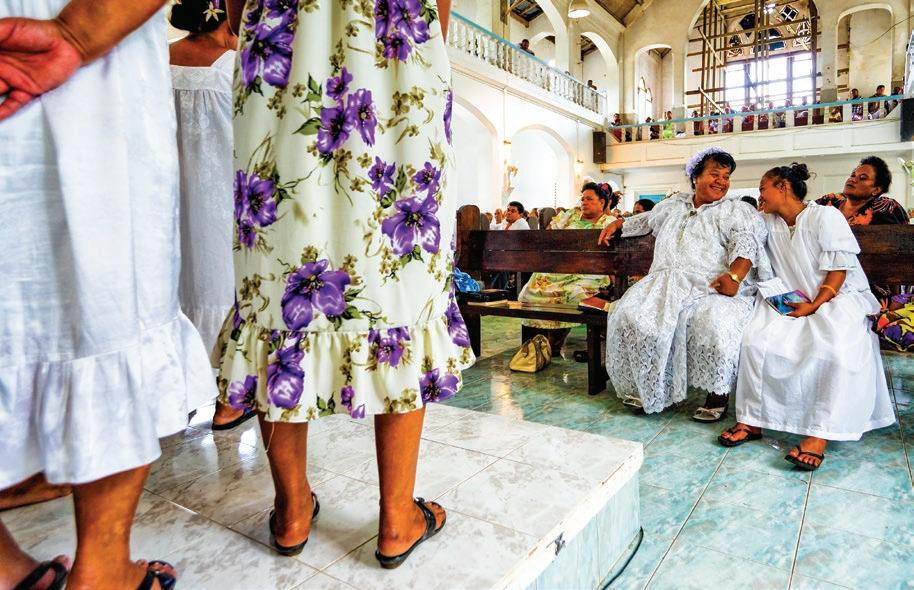
The family relocated to Maryland while Clarence attended Johns Hopkins University, then settled on Saipan, where the Trust Territory headquarters were then located and where Floyd attended middle school before becoming a high school dormer at Mid-Pacific Institute in Honolulu, from which he graduated in 1971. Clarence and Sachiko stayed on Saipan until they both retired in 1982 and moved back to Hawai‘i for the first time in thirty years.
Floyd’s parents gave him his first camera, a Kodak Brownie Fiesta, when he was 10, and he has been taking photos ever since. “I gave serious thought to doing photojournalism when I went to college,” he says, but there was one problem: “I’m colorblind and was concerned that I would not be able to pass the basic photography tests. I have a preference toward black-and-white photography regardless, and I really have no interest in being a commercial
photographer, but when I do shows I’ve got a really good printer who balances color for me.” Instead he took up his “other passion”: writing.
Floyd graduated from Boston University with a BS in journalism in 1975, and two years later earned an MA in Pacific Islands studies from the University of Hawai‘i at Mānoa. It was during his time at UH that he went truly pan-Pacific. “I was probably the luckiest graduate student in the world,” he recalls. “I got an East-West Center fellowship. In those days the center’s Communication Institute was doing what we used to call transnational communication studies: looking at what was being sent by shortwave radio from Washington to China, measuring the usage and things like that. I looked at the Pacific, and there was very little television in those days—the primary way most Pacific Islanders got a visual introduction to Western culture was through movies. There were a lot of movie theaters as well as rural movie
teams that went out with batteryoperated projectors. So I proposed doing a ‘status study of commercial cinema’: what was being shown, where it was being shown, and how it was being received in terms of official policy. I put every Pacific country and territory in the proposal, and by gosh they approved it! So I spent six months traveling everywhere, except for what was then the Ellis Islands—Tuvalu today—and Easter Island. And I watched movies—I saw enough kung fu movies to last a lifetime, but I also spent time with people like film censors. I was in a censorship session in Fiji where they outright banned an American ‘blacksploitation’ film that probably should have been banned everywhere. For a Pacific Island studies major, that was absolute heaven.”
As a journalist, Floyd built a name for himself throughout the Pacific. Giff Johnson, the editor of Majuro’s weekly Marshall Islands Journal, has worked with Floyd for decades, including a stint
105
Takeuchi, who grew up on the Marshall Islands atoll of Majuro, has been taking photographs of life on the various islands of Micronesia ever since his parents gave him his first camera at age 10. Above, a church service in Pohnpei, Federated States of Micronesia.

as managing editor for Pacific Magazine when Floyd was its publisher. “The fact that he was born and raised on Majuro and has lived and worked virtually his entire life in the region has given Floyd a special connection that people here and on other islands respect,” says Giff. “His photos especially tend to build pride among people who see them. His latest project, The Micronesians, is a fine example of how he takes on an idea with his photography—in this case challenging Hawai‘i people’s assumptions about Micronesians. It is
powerful in its beauty and simplicity.”
For The Micronesians, which was part of a three-photographer exhibit of portraits that ran in Honolulu’s Downtown Art Center earlier this year, Floyd created a series of black-andwhite photos featuring nine highly successful women from throughout the region who are contributing to Hawai‘i society in a variety of ways—as lawyers, government officials and East-West Center administrators; scientists and social workers. All were dressed in a type of skirt specific to parts of the
Caroline islands—which is not where most of them were from. Floyd had to persuade several of his subjects to wear something they otherwise wouldn’t, but the homogenizing move had a purpose: “This photographic project is a modest attempt to force locals in Hawai‘i to face their own prejudices,” wrote Floyd in the exhibition catalog. “It uses the so-called Micronesian skirt as a symbol of the latent discrimination that festers in our contemporary society. Hopefully these portraits of women of accomplishment and distinction are a visual wedge to
106
“The fact that he was born and raised on Majuro and has lived and worked his entire life in the region has given Floyd a special connection that people here and on other islands respect,” says Giff Johnson, editor of the Marshall Islands Journal, who worked with Takeuchi. “His photos especially tend to build pride among people who see them.” Above, Takeuchi’s photo of dancers from Guam performing at the 2008 Festival of Pacific Arts in American Sāmoa.

begin breaking up the assumptions that we use to shield our ignorance.”
The message at the heart of The Micronesians also speaks to a defining feature of Floyd’s photography: It is personal. “I was trained in traditional American journalism to be impartial and fair, which still has value,” he says. “But I think I become a better photographer when I am engaged emotionally in the subject, and in the case of the Micronesian community in Hawai‘i, I’m emotionally all-in. I’m not of the community—I don’t think


of myself as Micronesian. I’ll always be an expatriate, but I have close ties through friendships.”
The Marshall Islands became an independent nation not long after Floyd visited Bikini as a young journalist. On May 1, 1979, the republic became self-governing, and in 1986 it entered into a Compact of Free Association with the United States, which formally established the country’s status as a sovereign nation. The compact also gives Marshallese citizens the right to freely enter, live and work in the United States, and today roughly one-third of the population lives overseas, with significant communities in Hawai‘i and such disparate places as Springfield, Arkansas, and Bend, Oregon. For some
the move is temporary; for others the islands may be forever beyond the horizon. Sea levels are rising, and low islands throughout the Pacific are seeing the impacts. The highest point in the Marshall Islands is roughly thirty feet above sea level. Kili, which is still populated by Bikini descendants, has been inundated by waves several times since 2011, with seawater contaminating drinking wells. Last year the Marshall Islands government released a National Adaptation Plan that aims to keep the islands habitable, but surveys among Marshallese expats point to climate change as one reason they might never return.
Time is short to document the Marshalls as they currently exist. So it is that Floyd’s long-ago vision on Kili has become the seed for a project that
could become his most important and lasting body of work: A Dream of Atolls, in which he hopes to collaborate with two other photographers to document islands and atolls—inhabited or not— throughout the Marshalls. This is no small undertaking: Though its total land area is only 66 square miles, the archipelago consists of five distinct islands and twenty-nine atolls, which in turn contain more than 1,100 islands and islets, spread across nearly 775,000 square miles of ocean. It’s not humanly possible to capture every piece of land, but the aim is to capture the place as a whole, as it exists today.
The current goal is to begin in 2023, pending a lot of fundraising and an easing of pandemic-related travel restrictions in the Marshalls. For Floyd there are additional challenges. In 2017,
108
In a land of water, sailing is both a necessity and a sport. Above, Takeuchi’s camera captures a twenty-five-foot Marshallese outrigger sailing canoe cruising at about fifteen knots on the lagoon of Jaluit Atoll in the Republic of the Marshall Islands.









Same Day New Smile™ AS SEEN ON
your complimentary consultation!
Schedule
We offer in-person
options, perfect
out-of-state patients. Holistic metal-free implants, Full mouth restoration, In-house dental lab, All done in one office by one doctor.
Awarded Top Seattle Dentist Shawn Keller, DDS
and virtual
for


while island-hopping in the Marshallese atoll of Jaluit, he sustained what at the time seemed a minor injury. “I grew up out there wearing rubber slippers. Getting in and out of boats on the various islands, sand always gets under the strap and occasionally breaks your skin. So I had a quarter-inch cut on the top of my left foot. … I’ve had millions of those over the years.”
This time was different: Five days after he returned to Hawai‘i, he was in Queen’s Medical Center battling sepsis. He now walks with a cane. Meanwhile, a year prior to that incident, he was diagnosed with Parkinson’s—it’s not something he usually broadcasts for fear it will define how others see him. But he does acknowledge that it affects his ability to see this project through. “I have a window of opportunity that’s going to shut at some point, so I’m conscious
of the fact that I’ve got a relatively limited amount of time to do work that’s meaningful for me,” he says. “At the same time, with the rising tides, an even bigger window of opportunity is closing for the Marshall Islands, so we have a sense of mission.”
In addition to Floyd, the “we” includes two principal collaborators: Neil McPherson, a landscape photographer and retired pastor at Nu‘uanu Congregational Church, will join Floyd in documenting the environment—for some of the uninhabited islands, that means living aboard a dive boat for days at a time. Paul Whitehouse, a British citizen, will make selected portraits using the nineteenth-century wet plate collodion process. “We are primarily trying to document the physical geography, but for those islands that are inhabited, we want to have some photographs that
capture the sense of the community, so we plan to have Paul do an entire island community—possibly Romrom Island on Majuro Atoll, which is about sixty people. He can commute from the hotel by boat every day and do his chemical magic to preserve the plates in the evening.”
Ultimately, Floyd hopes to turn his long-held vision into something of value for the place that not only embraced his own expat family but helped define his worldview. “I always think of the Marshallese living abroad who, over the next couple generations, will likely never see an outer island, and some who may never visit even Majuro—people who grow up without their land and in some cases without their language. In that process, their worldview becomes very different. So my hope is that this project brings some definition to their dreams.” hh
111
For The Micronesians, a photographic exhibit that ran in Honolulu’s Downtown Art Center earlier this year, Takeuchi (seen above right) created portraits of members of Hawai‘i’s Micronesian community, partly as an effort to dispel negative stereotypes surrounding the Islands’ newest immigrant group. Above left, Takeuchi’s portrait of Arsima Muller, an attorney originally from Majuro, Republic of the Marshall Islands.
PHOTO BY OLIVIER KONING


BY

ISLAND BY ISLAND : O‘AHU
114
O‘AHU
PHOTO
ELYSE BUTLER


DECEMBER
H o MA NIGHTS
Every Friday and Saturday
Honolulu Museum of Art remains open until 9 p.m. with opportunities to explore the galleries, stargaze in the courtyards, enjoy live art experiences and music and connect with the museum community. Honolulu Museum of Art, (808) 532-8700
MADE WITH ALOHA GIFT FAIR
Every third Saturday and Sunday
Support dozens of small local businesses selling handcrafted jewelry, baked goods, unique apparel, charms and more. 10 a.m. to 5 p.m. Free. Pearlridge Center, (808) 689-9091
CROSS POLLINATION: FLOWERS ACROSS THE COLLECTION
Through 6/4/2023
Presented in conjunction with the immersive anchor installation Rebecca Louise Law: Awakening, this exhibition unites a diverse arrangement of floral
artworks from HoMA’s permanent collection. Honolulu Museum of Art, (808) 532-8700
VANS TRIPLE CROWN OF SURFING
Through 12/20
Watch top-ranked surfers take on some of the world’s biggest and most famous waves at multiple events. North Shore, (808) 651-8248
HONOLULU CITY LIGHTS
Throughout December
The City and County of Honolulu throws a month-long Christmas lights and decorations display. Opening night on December 3 includes the Public Workers’ Electric Light Parade, tree lighting ceremony and food booths starting at 6 p.m. Free. Honolulu Hale, honolulucitylights.org
DIONNE WARWICK
12/1–12/4
Five-time Grammy Award-winner Dionne

Warwick ranks second only to Aretha Franklin as the most charted female vocalist in history, with classic recordings like “Walk On By,” “Say a Little Prayer” and “I’ll Never Fall in Love Again.” 8 p.m. Blue Note Hawaii, (808) 777-4890
RANDY RAINBOW
12/2
Emmy-nominated singer, writer and comedian Randy Rainbow brings his most viral video song parodies to life onstage along with new original songs written in collaboration with Marc Shaiman and Alan Menken. Hawaii Theatre Center, (808) 528-0506
116 EVENTS: O‘AHU
Vans Triple Crown of Surfing
Randy Rainbow
SERVING MUSUBIS UPON OPENING UNTIL SOLD OUT AND FRESH LOCAL FISH STARTING AT 10:30AM DAILY!
1613 NUUANU AVE #A12
HONOLULU, HAWAII 96817
MONDAY-FRIDAY 6AM-6PM SATURDAY 9AM-6PM SUNDAY 9AM-2PM #ALWAYSFRESH #ALWAYSLOCAL





MENTION THE CODE WORD “TRAVEL” TO GET 5% OFF YOUR ENTIRE ORDER.
VISIT OUR WEBSITE TO ORDER ONLINE: WWW.PARADISEPOKENUUANU.COM SOURCING SEAFOOD DIRECTLY FROM VESSELS · FOCUS ON SUSTAINABILITY WE ARE SERVING ONLY THE FRESHEST SEAFOOD AVAILABLE! With two convenient locations in Honolulu, Ahi and Vegetable is the ultimate source for highquality seafood. Whether you need to purchase sushi or poke platters for an event... turn to Ahi and Vegetable for the freshest fish in Hawaii. 1450 Ala Moana Blvd Ala Moana CenterLanai Food Court 808.377.4097 1210 Dillingham Blvd 808.845.3500 MONDAY-SUNDAY 9AM-8PM MENTION THE CODE WORD “TRAVEL” TO GET 5% OFF YOUR ENTIRE ORDER. VISIT OUR WEBSITE TO ORDER ONLINE: www.ahiandveg.com |@ahiandvegetable FROLIC’S 2022 POKE FEST WINNER Mahalo, Hawaii! FOR VOTING US ONE OF THE BEST POKE IN HAWAII.

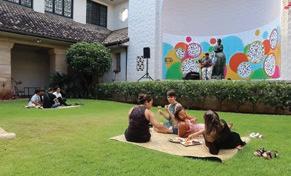

PEARL HARBOR MEMORIAL PARADE
12/7
Decorated Cobra and Huey helicopters, marching bands and floats parade in Waikīkī on the anniversary of the attack on Pearl Harbor. The event honors Pearl Harbor survivors, veterans, active-duty military and their families. Opening ceremony begins at 4:30 p.m. and the parade at 6 p.m. Kalākaua Avenue, (800) 626-8690
HAMILTON
12/7–1/29
Featuring a score that blends hip-hop, jazz, R&B and Broadway, Hamilton has turned the story of American founding father Alexander Hamilton into a musical sensation. Blaisdell Concert Hall, (808) 768-5252
BISHOP MUSEUM AFTER HOURS
12/9
Museum exhibits are open for viewing from 5:30 to 9 p.m., along with cultural demonstrations and food and drinks for sale from local vendors. Bishop Museum, (808) 847-3511
HSO HAPA SYMPHONY–KIMIÉ MINER
12/10
Hawai‘i Symphony Orchestra kicks off the holiday season with Kimié Miner performing music from her newest album, Christmas in Hawai‘i, along with other songs of the season. Hawaii Theatre Center, (808) 528-0506
KALĀKAUA MERRIE MILE
12/10
This easy, one-mile run is held the day before the Honolulu Marathon, ending with a party on Queen’s Beach with live music and post-race fun. The race begins at 7 a.m. Kalākaua Avenue, (808) 734-7200
118 EVENTS: O‘AHU
Honolulu Marathon
HoMA Nights
Hamilton
KIMIÉ MINER & FRIENDS: CHRISTMAS IN HAWAI‘I TOUR
12/10 & 21
Award-winning recording artist and producer Kimié Miner performs songs from her album, Christmas in Hawai‘i, along with special guest performers and community partners. Each concert will feature a Mele Marketplace, offering attendees a chance to support local businesses for the holidays. Various locations, KimieMiner.com
HONOLULU MARATHON
12/11
The Honolulu Marathon is the fourthlargest marathon in the United States, attracting more than thirty thousand runners annually. The scenic 26.2-mile course includes views of Waikīkī, Diamond Head, Koko Head and Koko Crater. 5 a.m. Downtown, (808) 734-7200
HARMONY ZHU
12/11
Piano prodigy Harmony Zhu—the youngest ever winner of the Juilliard Concerto Competition— performs the virtuosic Piano Concerto of Clara Schumann. Hawai‘i Theatre Center, (808) 528-0506
ALI‘I SUNDAY: KAMEHAMEHA ‘ELIMA (V)
12/11
A worship service in honor of Kamehameha ‘Elima (V) in a church that has profound ties to Hawai‘i’s royal past. The procession begins at 9 a.m. Kawaiaha‘o Church, (808) 469-3000
HOLIDAY BRUNCH WITH FRANK DELIMA
12/11
Frank DeLima is one of Hawai‘i’s most popular and beloved comedians. This award-winning comic has been entertaining local residents and tourists alike with his zany parodies and outrageous humor for forty-five years. Doors open at 11 a.m. Blue Note Hawaii, (808) 777-4890




ALI‘I SUNDAY: PRINCESS BERNICE PAUAHI BISHOP
12/18
A worship service in honor of Kamehameha ‘Elima (V) in a church that has profound ties to Hawai‘i’s royal past. The procession begins at 9 a.m. Kawaiaha‘o Church, (808) 469-3000
FAMILY SUNDAYS
12/18
Free admission for kama‘āina (residents) on the third Sunday of every month. HoMA offers creative activities for keiki of all ages, community-focused programming and entertainment. 10 a.m.–6 p.m. Honolulu Museum of Art, (808) 532-8700
‘OHINA SHOWCASE
12/20
A lineup of short films shot in Hawai‘i by local filmmakers, including Greenlight Award-winners from the ‘Ohina Labs film program. 7 p.m. Hawaii Theatre Center, (808) 528-0506
A CHARLIE BROWN CHRISTMAS
12/25 & 12/26
Native New Yorker and trumpeter Mike Lewis performs selections from the soundtrack to A Charlie Brown Christmas , written by composer and pianist Vince Guaraldi. Two shows at 6:30 and 9 p.m. Blue Note Hawaii, (808) 777-4890
2023 Sony Open

JANUARY
2023 SONY OPEN
1/9–1/15
The Sony Open in Hawai‘i is the first full-field event of the 2023 PGA Tour, attracting 144 of the world’s finest golf professionals. Waialae Country Club, (808) 523-7888
BISHOP MUSEUM AFTER HOURS
1/13
Museum exhibits are opened for viewing from 5:30 to 9 p.m., along with cultural demonstrations and food and drinks for sale from local vendors. Bishop Museum, (808) 847-3511
FAMILY SUNDAYS
1/15
Free admission for kama‘āina (residents) on the third Sunday of every month. HoMA offers creative activities for keiki of all ages, community-focused programming and entertainment. 10 a.m.–6 p.m. Honolulu Museum of Art, (808) 532-8700
POLYNESIAN FOOTBALL HALL OF FAME ENSHRINEMENT WEEKEND
1/20 & 1/21
A weekend honoring the past and future inductees of the Polynesian Football Hall of Fame. Events include the Polynesian Bowl, a celebration dinner and enshrinement ceremony. Various locations, (702) 715-5355

 Pearl Harbor Parade
Pearl Harbor Parade

BATTLESHIP MISSOURI MEMORIAL
Arizona Memorial Place, Honolulu ussmissouri.org (808) 455-1600

Complete your Pearl Harbor Experience. The USS Missouri is no ordinary ship, this is America’s most historic battleship. Home to 2700 sailors, nine 66-foot-long guns, 1220 projectiles and a deck big enough to host a surrender ceremony presided by General Douglas MacArthur. Shuttle service from the Pearl Harbor National Memorial visitors center included with admission.

BREAK'N ANGER
1008 Kawaiahao Street, Honolulu breaknanger.com (808) 888-2630

Shatter your anger away at Break'N Anger—Literally Hawai‘i's first ever Rage Room, Break'N Anger will provide you with a unique experience that’s one of a kind. Express yourself creatively in our Splatter Studio or hammer everything in sight In our Smash Lab. Break'N Anger is the only place you and your friends can make a mess while creating memories.

ISLAND BY ISLAND : O‘AHU


dolefruithawaii.com (800) 697-9100 Toll-Free (808) 847-3234 O’ahu

Bring Home a Bite of Paradise! The exotic pineapple has been associated with Hawai’i & the DOLE® brand for over 100 years. The fertile, volcanic soils of O ‘ahu are kissed with Hawaiian sunshine, warm tropical rain, and gentle tradewinds, creating the sweeter, jucier DOLE Royal Hawaiian ® Pineapple.
FARMLOVERS FARMERS MARKETS
Kaka‘ako, Pearlridge Center, Kailua Town, Hale‘iwa
farmloversmarkets.com (808) 388-9696

Immerse yourself in local food culture at any one of our Farmers Markets. Taste the true Hawai'i. Experience our local farmers, culinary masters, and artisans. Fresh locally grown produce. Tropical Fruits and Vegetables. Come Hungry! Leave Happy. Our chefs cook healthy, island style grindz. Need a Gift? Our local artisans have you covered. Kaka ’ako (Sat), Pearlridge (Sat), Kailua Town (Sun), Hale’iwa (Thur).

DOLE
EAT / SHOP / PLAY PROMOTIONAL
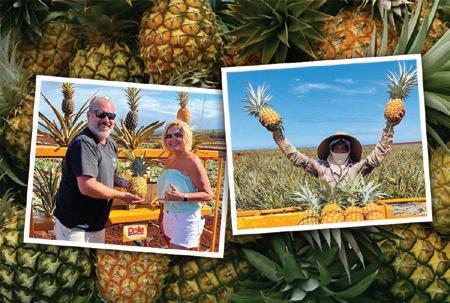
NORTH SHORE DOLE PINEAPPLE FARM TOUR
Use Promo Code "Hawaiian" for 20% off gotourshawaii.com (808) 926-3090

A locally guided tour to Oahu’s North Shore where guests will have access to the iconic Dole Pineapple fields. From planting and harvesting to processing and packing, guests will see it, feel it and taste this one-of-akind experience on Oahu. Additional stops: Greenworld Coffee Farm, Waialua Sugar Mill, Haleiwa Town, local food truck, macadamia nut stop, a North Shore beach and the King Kamehameha statue!

NORTH SHORE SOAP FACTORY
67-106 Kealohanui Street, Waialua Sugar Mill northshoresoapfactory.com (808) 637-8400
Watch what our Master Soap Maker is working on when you visit North Shore Soap Factory! Come for the soap, stay for the stamping…customize your bar at our Stamping Station. Book a Behind-the-Scenes Tour* to see how we handcraft Hawaiian Bath & Body® soaps and skincare. Local art, gifts and more. Find us in the Big Coneshaped building!

ISLAND BY ISLAND : O‘AHU
North Shore Soap Factory

PANDORA
Ala Moana Center, Honolulu (808) 946-8001
Celebrate your favorite place. A trip of a lifetime, Hawai‘i is a true paradise. Celebrate the times you’ll never forget with our beautifully engraved Hawaii charm. Pandora jewelry gives a voice to your loves through pieces that remind you of everything you are and everything you love. Discover our full collection of bracelets, charms, earrings, necklaces and more.
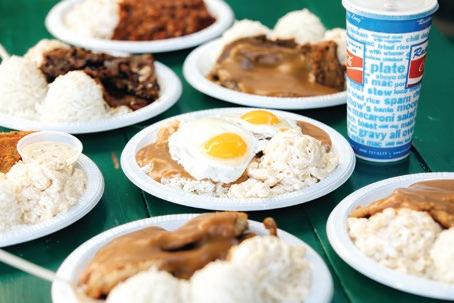
RAINBOW DRIVE-IN
Kapahulu, Kalihi, Pearlridge, ’Ewa, rainbowdrivein.com (808) 737-0177
Family owned since 1961, Rainbow Drive-In is known for their generous portions of simple, hearty Hawai‘i comfort food. Stop by one of four locations for the best Loco Moco or a delicious plate lunch. After enjoying a famous Slush Float for dessert, leave with one of our famous logo with one of our exclusive logo-emblazoned merch items from the Rainbow Tiki shop.

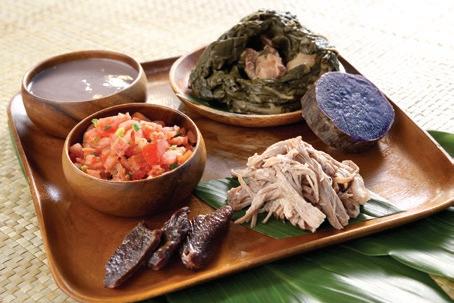
59-864 Kamehameha Hwy., Hale’iwa waimeavalley.net (808) 638-7766

Waimea Valley is a wahi pana (storied place) deeply rooted in Hawaiian culture. Today Waimea is home to six cultural sites and 5,000 unique plants from all over the world. Allow the wonders of Waimea to speak to you as you walk through this place of healing. Experience the tranquility and the sites that harken back to a bygone era in Hawai‘i’s history.
YOUNG'S FISH MARKET
Kapolei Commons, 4480 Kapolei Parkway, City Square, 1286 Kalani St, Honolulu youngsfishmarket.com (808) 841-4885
Home of the famous laulau! Young’s Fish Market has been Hawai‘i’s go-to for delicious local foods since 1951. Laulau, kalua pork, poke and more... We have everything to satisfy your Hawaiian food cravings. Want to send a taste of Hawai‘i to loved ones on the mainland? Send a Laulau Care Package delivered right to their door! Visit our website for information!
FISH MARKET & RESTAURANT
WAIMEA VALLEY
125 EAT / SHOP / PLAY
PROMOTIONAL
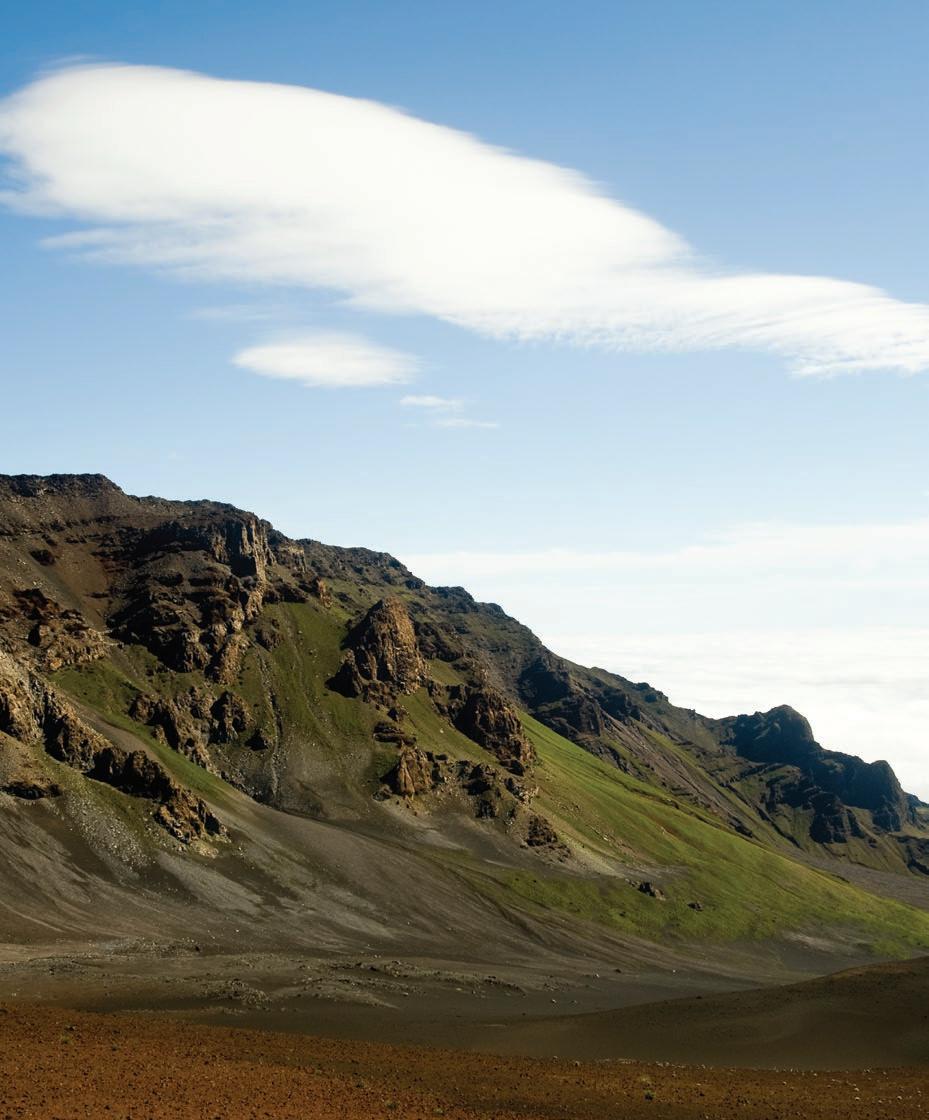
126 ISLAND BY ISLAND : MAUI
MAUI
PHOTO
BY ELYSE BUTLER


DECEMBER
WILDLIFE WEDNESDAYS
Wednesdays
Join naturalists from the Hawai‘i Wildlife Discovery Center at the beach and learn about humpback whales, turtles, monk seals and more Maui wildlife. 10 a.m. to noon. Whalers Village, (808) 661-4567
HĀNA FARMERS MARKET
Fridays
Locally grown produce and products from the farmers of East Maui. Online pre-orders and drive-through ordering available. Free. Kūpuna-only (65+) shopping starts at 2:30 p.m., general admission from 3 to 5 p.m. Hāna Town Center, (808) 378-0084
UPCOUNTRY
FARMERS MARKET
Saturdays
Locally grown produce, fish, prepared food and products. Free. 7 to 11 a.m. Kula Malu Town Center, (808) 572-8122
MAUI SUNDAY MARKET
Sundays
A weekly evening marketplace with local food and product vendors and live entertainment, organized by the Maui Food Technology Center. Free. 4 to 8 p.m. Kahului Shopping Center, (888) 948-6382
HOLIDAY LIGHTS AT THE BANYAN TREE
Throughout December
Each December Lāhainā’s 143-year-old banyan tree is illuminated with thousands of colored lights. Keiki activities, live music and crafting workshops are also available on various dates in December. 5:45 p.m. to Midnight. Free. Banyan Tree Park, Lāhainā, (808) 661-4779
HALEAKALĀ WALDORF HOLIDAY FAIRE
12/3

HŌLUALOA MUSIC AND LIGHT FESTIVAL
12/3
Every year on the first Saturday of December, the small town of Hōlualoa celebrates the holidays with the annual lighting of the town Christmas tree, live music, gallery gatherings, art openings, complimentary treats and beverages from shops and an appearance by Santa. 6 p.m. to 9 p.m. Hōlualoa, (808) 989-0558
This long-standing Upcountry tradition has festive crafts from more than seventyfive Maui artisans, a silent auction, food vendors, live entertainment and hands-on crafts like wreath and ornament making and beeswax candle dipping. 9 a.m. to 4 p.m. Haleakalā Waldorf School, (808) 878-2511
128 EVENTS: MAUI/ MOLOKA‘I/ LĀNA‘I
Holiday Lights at the Banyan Tree
Maui Sunday Market
NUTCRACKER SWEETS
12/15-18
This collaboration with Momentum Dance Maui is a fresh take on the classic ballet with the Tchaikovsky score. Iao Theater, (808) 242-6969
QKC KEIKI CLUB
12/17
Learn about the diversity of sea life in Hawai‘i with one of Maui Ocean Center’s marine naturalists at the QKC keiki play area. Enter to win giveaways and enjoy family-friendly festivities. 10 to 11 a.m. Queen Ka‘ahumanu Center, (808) 877-3369
CHRISTMAS 5K RUN
12/18
Valley Isle Road Runners hosts the Christmas 5K run, 1 Mile Walk and Santa’s Half Mile Keiki Dash. Donations for the Maui Food Bank will be collected. 7:30 to 10 a.m. Kaunoa Senior Center Pā‘ia, (808) 222-2484
JANUARY
2023 HUI NO‘EAU ANNUAL JURIED EXHIBITION
1/13–2/17
Hui No‘eau Visual Arts Center presents its Annual Juried Exhibition, exhibiting ceramics, printmaking, sculpture, photography, painting, drawing, jewelry, digital media, fiber, wood and mixed media. Hui No‘eau Visual Arts Center, (808) 572-6560
QKC KEIKI CLUB
1/21
Learn about the diversity of sea life in Hawai‘i with one of Maui Ocean Center’s Marine Naturalists at the QKC keiki play area. Enter to win giveaways and enjoy family-friendly festivities. 10 to 11 a.m. Queen Ka‘ahumanu Center, (808) 877-3369
FELIX CAVALIERE’S RASCALS
1/23
Best known as the singer and keyboardist for the Rascals, Felix Cavaliere has had a career spanning five decades and continues to entertain audiences all over the globe. Maui Arts & Cultural Center Castle Theater, (808) 242-7469


The CURRENT of HAWAI‘I FLUXHAWAII.COM


THROUGH THE PRODUCTION OF AWARD-WINNING DISTILLED BEVERAGES TO THE TOURS WE GIVE ON OUR 80-ACRE ORGANIC FARM, WE ALWAYS EXTEND A HEARTFELT ALOHA.
We play in the dirt and cultivate more than 30 species of Polynesian sugar cane under the tropical sun. The sunlight also helps provide power for our facility, which is situated on the beautiful slopes of Haleakala in Kula, Maui. We look forward to welcoming you at our home away from home offering breathtaking views, guided tours, product sampling, and a retail store featuring our spirits and merchandise. Open seven days a week.
THE HAWAIIAN ISLANDS ARE THE MOST ISOLATED PLACE ON EARTH.
An ecological wonder, Hawai‘i hosts four of the planet’s five climate groups and is home to thousands of endemic species of life. This is the setting for our workshop. At Ocean, we are an extended family of passionate innovators who enjoy what we do for a living as well as how we spend our recreational time. Every day, we wake with a spirited desire to share our experience of paradise with the rest of the world.



ALCHEMY MAUI
157 Kupuohi St., Ste. J-1 Lahaina alchemymauibistro.com (808) 793-2115

Alchemy | Maui, Maui’s lunch hot spot, combines the natural flavors and nutrients of two fermentation favorites, kombucha and sourdough, to create a menu of delicious good-for-you staples. Our flavor combinations are wild, exciting, and more creative than any restaurant on Maui. One visit will keep you coming back for more!

HUI NO‘EAU VISUAL ARTS CENTER
2841 Baldwin Avenue, Makawao, Maui huinoeau.com (808) 572-6560

Located in Upcountry Maui at the historic Kaluanui Estate, Hui No‘eau Visual Arts Center is a nonprofit, community arts center offering art classes, workshops, exhibitions, and events. Visitors are invited to explore the 100-year-old Kaluanui home, enjoy artwork by local artists in the gallery and gift shop, or take a self-guided tour of the scenic 25-acre grounds.
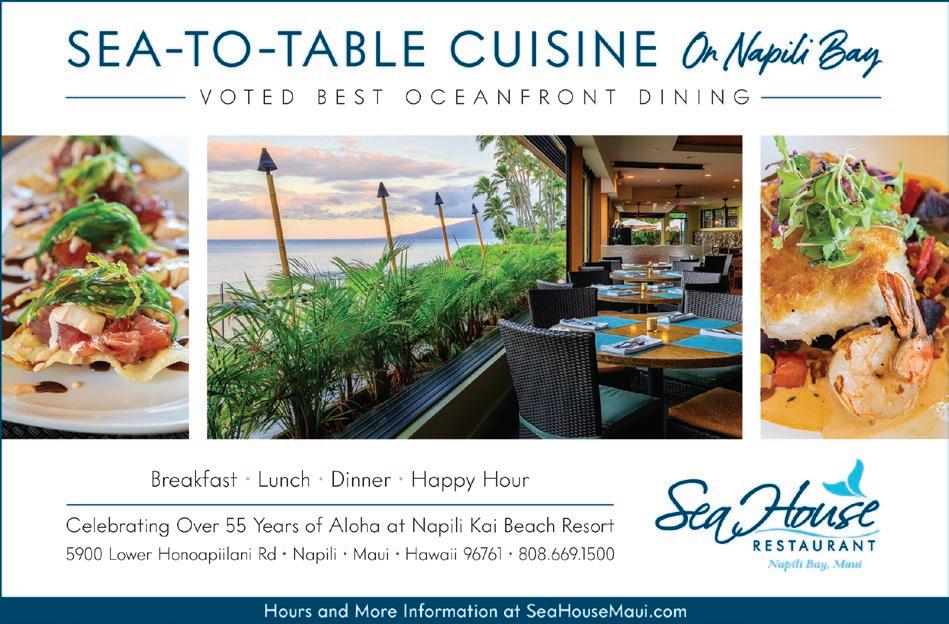
ISLAND BY ISLAND : MAUI

MAUI HANDS ART GALLERIES
Lahaina, Pa‘ia, Makawao, and Wailea mauihands.com @mauihands

Maui Hands is the creative efforts of 300 Hawai‘i-based artists working in every conceivable medium to bring the best of the islands to you. Each location is uniquely curated with a selection of fine and casual jewelry; original artwork and prints; ceramic, glass, and wood creations; linens and home goods; and an extensive collection of exquisite Ni‘ihau shell lei.
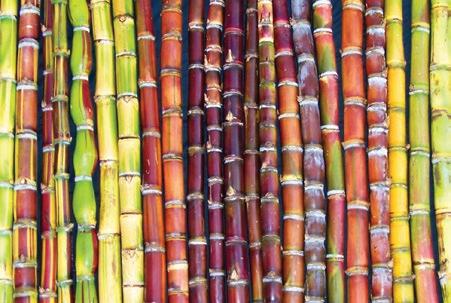
MAUI NUI BOTANICAL GARDENS
150 Kanaloa Ave., Kahului @mauinuibg mnbg.org (808) 249-2798

Hawai‘i’s native and canoe plants are the source of unique traditional foods, medicines, household items, and more. This five-acre, nonprofit garden celebrates the utility of the plants that form the basis of Hawaiian culture. Walk-in visitors are welcome Tuesday through Saturday; self-guided audio and written plant tours included with admission. Register for resident led docent tours and ethnobotany workshops online.

EAT / SHOP / PLAY PROMOTIONAL

134 ISLAND BY ISLAND : HAWAI ‘ I ISLAND
HAWAI‘I ISLAND
PHOTO BY JASON LAFFERTY

DECEMBER
NIAULANI NATURE WALK
Mondays
A one-hour nature walk through an oldgrowth Hawai‘i rainforest on an easy loop trail. Walkers are introduced to the native plants and birds of Kīlauea volcano. Free. 9:30 a.m. Volcano Arts Center’s Niaulani Campus, (808) 967-8222
PORTUGUESE BREAD BAKING
Thursdays
Observe the traditional art of baking Portuguese bread in a large wood-fired stone oven, or forno. The Programs Team will share the importance of such ovens in our community and the history of the Portuguese, and bread sales begin at 1 p.m. 10 a.m. Kona Historical Society, (808) 323-3222
A WALK INTO THE PAST
Fridays
Take a walk back in time to 1912 and meet the founder of the Hawaiian Volcano Observatory, Thomas A. Jaggar at the edge of Kīlauea volcano. Dressed in period costume, Ka‘ū actor and director Dick Hershberger brings the renowned
geologist to life. Free. 10 a.m. to noon. Hawai‘i Volcanoes National Park, (808) 985-6000
HALEKI‘I FARMERS MARKET & CRAFT FAIR
Every first Saturday
Local crafts and art vendors, keiki entrepreneurs, fresh food, ‘ohanacentered outreach, sustainable-living resources and live music. Free. 9 a.m. to 2 p.m. Kona Grill House, (808) 960-7728
YOUTH ARTS SATURDAYS
Every second Saturday Keiki of all ages are welcome to join guest artists and other local organizations in making a variety of creative projects. Free. 10 a.m. to 2 p.m. East Hawai‘i Cultural Center, (808) 961-5711
HAWAI‘I NEI 2022
Through 12/15
A juried art exhibition celebrating the native flora and fauna of Hawai‘i Island. The opening reception will announce winners from youth and adult divisions, with live music and refreshments. Free. Wailoa Center, (808) 933-0416

JAZZ IN THE FOREST
12/3
Volcano Art Center’s bimonthly jazz concert highlights local musicians at the Dietrich Varez Hall surrounded by native Hawaiian rainforest. December’s concert is themed Holiday Spirits. Volcano Art Center’s Niaulani Campus, (808) 967-8222
WAIMEA CHRISTMAS
TWILIGHT
PARADE
12/3
In its sixty-first year, this annual evening parade features Santa and a brigade of lighted trucks. 5:30 p.m. Main Street, Waimea, (808) 936-0670
EVENTS: HAWAI ‘ I ISLAND 135
Niaulani Nature Walk
Kamuela Philharmonic


KONA COMMUNITY CHRISTMAS PARADE
12/10
Business and community groups, musical and choral groups and many others take part in this colorful parade, which starts at 5 p.m. Ali‘i Drive, (808) 938-0806
KŌKUA KAILUA VILLAGE STROLL
12/11
Ali‘i Drive transforms into a festive, pedestrian-only marketplace filled with music and art. At 4 p.m. there is a free Hawaiian music concert at Hulihe‘e Palace. 1 to 6 p.m. Kailua-Kona, (808) 936-9202
ALOHA FRIDAY NIGHT MARKET
12/23
An evening marketplace with food trucks and over thirty local vendors. Each market helps support one of Hawai‘i Island’s nonprofit organizations. Free. 4 to 8 p.m. Kona Commons Shopping Center, (808) 854-1439
JANUARY
KŌKUA KAILUA VILLAGE STROLL
1/15
Ali‘i Drive transforms into a festive, pedestrian-only marketplace filled with music and art. At 4 p.m. there is a free Hawaiian music concert at Hulihe‘e Palace. 1 to 6 p.m. Kailua-Kona, (808) 936-9202
MITSUBISHI ELECTRIC CHAMPIONSHIP
1/16–1/21
A PGA Tour Champions competition among the sport’s top players. Hualālai Golf Course, (808) 325-8000
KAMUELA PHILHARMONIC PRESENTS THE TALENT THAT SURROUNDS US 1/22
Performances by the winners of this year’s Madeline Schatz-Harris Youth Concerto Competition. The Philharmonic will also highlight a Hilo-based composer, Irminsul, in the world premiere of his The Three Virtues of Zarathustra. 2 p.m. Kahilu Theatre, (808) 885-6868

Ā HUALOA FAMILY FARM
45-3279 Mamane Street, Honoka’a ahualoafarms.com (808) 775-1821

Stop by “The Nuthouse” and see what’s crackin'! Ā hualoa Family Farms grows, processes, and produces delicious 100% Hawaiian macadamia nuts and 100% Hamakua coffee in Historic Honoka’a town, the gateway to Waipio Valley. Come in for free samples, relax on the lanai, enjoy a cup of coffee and take home your favorite macadamia nut flavor. See you at The Nuthouse!

‘IMILOA ASTRONOMY CENTER
University of Hawai‘i at Hilo 600 ‘Imiloa Place, Hilo imiloahawaii.org (808) 932-8901

Visit ‘Imiloa in Hilo, Hawai‘i, and explore the science of Hawai‘i! Immerse yourself in our Planetarium and interactive Exhibit Hall and take a walk through our native Hawaiian garden landscape. We are an ideal venue for group tours, educational field trips and event hosting. Don't forget to ask about membership discounts too!
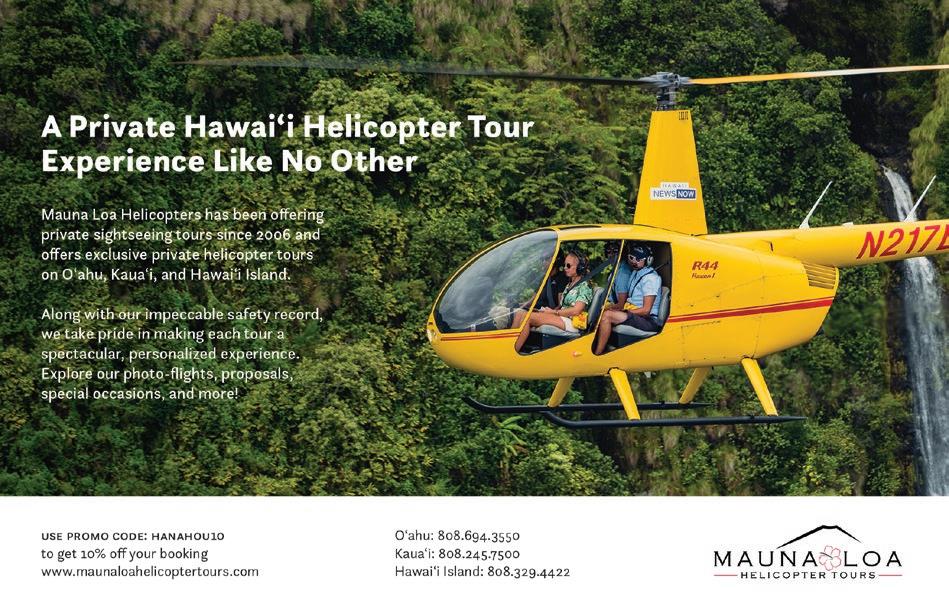
EAT / SHOP / PLAY PROMOTIONAL

138 ISLAND BY ISLAND : KAUA ‘ I
BY MIKE
KAUA‘I
PHOTO
COOTS

DECEMBER
KAUA‘I CULINARY MARKET
Wednesdays
A weekly farmers market featuring fruits, vegetables, flowers and a cooking demonstration. A partnership with the Kaua‘i County Farm Bureau. 3:30 to 6 p.m. The Shops at Kukui‘ula, (808) 742-9545
MAKAI MUSIC & ART FESTIVAL
Wednesdays
A weekly gathering with performances by local musicians and an assortment of handmade jewelry, crafts, art and more from local vendors. Free. 1 p.m. to 5 p.m. Princeville–Makai Lawn, (818) 318-7338
ALOHA MARKET
Thursdays
Everything from fresh fruits and vegetables to noodles, spices, sweets, treats and items like jewelry, clothing, art and household and family accessories. Hula performance at 12:30 every week. Free. 10 a.m. to 2 p.m. NTBG South Shore Visitor Center, (808) 742-2623
ALOHA FRIDAY ART NIGHTS
Fridays
Each Friday night Kress Street fills with live art demonstrations. From music to murals, artists share their craft with the community. Līhu‘e–Kress Street, (808) 652-1442
HANALEI FARMERS MARKET
Saturdays
Locally grown fruits and vegetables from Kaua‘i North Shore farmers along with fresh-squeezed juices, locally made honey, fresh-baked goods and arts and crafts. 9 a.m. for senior citizens, 9:30 a.m. to noon for general admission. Hale Halawai ‘Ohana O Hanalei, (808) 826-1011
ALAKOKO PLANT SWAP
Sundays
This weekly market offers plant lovers the chance to buy, sell or trade a wide variety of greenery. Free. 10 a.m. to 1 p.m. Alakoko Shop, (808) 652-1442
FESTIVAL OF LIGHTS 2022
Through 1/1
The Historic County Building in Līhu‘e will be illuminated with thousands of lights from 6 to 11 p.m. every night from Thanksgiving to New Year’s Day. Santa and Mrs. Claus will be present on the porch from 6 to 8 p.m. on Fridays and Christmas Eve. Līhu‘e Historic County Building, (808) 639-8564
LIGHTS ON RICE PARADE
12/2
This annual tradition marks the arrival of the holiday season. Līhu‘e community members light up their vehicles—and themselves—for a parade up Rice Street from Vidinha Stadium to the historic County Building. 6 p.m. Free. Līhu‘e, (808) 639-3571
PAU HANA TRIVIA NIGHT
12/2
A family-friendly trivia night in Porter Pavilion with food trucks, beer and wine hosted by Katie C., Kaua‘i’s “trivia girl.” Free. 6 to 8 p.m. Anaina Hou Community Park, (808) 828-2118
FULL WREATH-MAKING WORKSHOP
12/3
Participants bring their own clippers, scissors, gloves and trimmings to learn this holiday craft in the rustic setting of the Civilian Conservation Corps Camp at Kōke‘e State Park. 10 a.m. and 1 p.m. Call ahead for reservations. CCC Camp, (808) 335-9975
ISLAND BREEZE CONCERT
12/3 & 4
Three top-level artists meld their genres. Shakuhachi grand master Riley Lee of Australia joins taiko drum master Kenny Endo and award-winning slack key guitar virtuoso Jeff Peterson for a concert. 12/3: Anaina Hou Community Park Porter Pavilion; 12/4: Kaua‘i Beach Resort, (808) 635-3039
DOWNTOWN LĪHU‘E NIGHT MARKET
12/10
Locally made crafts, gifts, food trucks, baked goods, live entertainment, and more. Featuring more than fifty vendors each month. Free. 4 to 8 p.m. Līhu‘e–Kress Street, (808) 652-1442
PRINCEVILLE NIGHT MARKET
12/11
This monthly festival features live music, pottery, paintings, apparel, jewelry and more than forty local artisans. Free. 4 to 8 p.m. Princeville Shopping Center, (808) 635-2572
PRINCEVILLE ARTIST AND FLEA MARKET
12/11
This monthly marketplace focused on vintage apparel, accessories and home goods also features local vendors offering crafts, jewelry, health products, food, a keiki zone and live music. Free. 3 to 7 p.m. Princeville Community Center, (808) 826-6687
OLD KŌLOA TOWN MARKET
12/17
Kaua‘i artisans, photographers, food trucks, food vendors, musicians and entertainers gather for this monthly makers market. Free. 4 to 8 p.m. Old Kōloa Town, (808) 245-4649
KIMIÉ MINER & FRIENDS: CHRISTMAS IN HAWAI‘I TOUR
12/23
Award-winning recording artist and producer Kimié Miner performs songs from her album, Christmas in Hawai‘i, along with special guest performers and community partners. Each concert will feature a Mele Marketplace, offering attendees a chance to support local businesses for the holidays. Various locations, KimieMiner.com
NEW YEAR’S EVE AT PO‘IPŪ BEACH
12/31
Join the Po‘ipū community for live music, food trucks, a keiki-friendly movie screening at sunset and fireworks. Free entry. 5 to 8:45 p.m. Po‘ipū Beach Park, (808) 265-2096
139 EVENTS : KAUA ‘ I
Festival of Lights

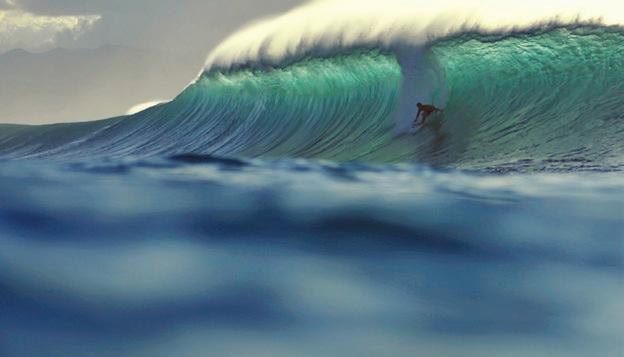
ENTER TO WIN
JANUARY
THE GIN GAME
1/6-22
Winner of the 1978 Pulitzer Prize for drama. Weller Martin is playing solitaire on the porch of a seedy nursing home when he meets Fonsia Dorsey, a prim, self-righteous woman with a love of gin rummy. Presented by the Kauai Community Players. Puhi Theatrical Warehouse, (808) 245-7700
PAU HANA TRIVIA NIGHT
VACATION 1

VACATION 2


Round-trip main cabin travel for two on Hawaiian Airlines to Honolulu and a three-night stay at the Kaimana Beach Hotel, with dinner for two at Hau Tree and a $250 shopping spree at the Royal Hawaiian Center.
Wake up to the ocean at the newly renovated Kaimana Beach Hotel. Stay steps from Diamond Head at the only boutique property situated right on the sand of O‘ahu’s legendary Waikīkī Beach. Kick back with brunch, lunch and casual dinners at the hip Hau Tree restaurant, and explore a curated selection of locally-made goods at Sunset Provisions. Visit kaimana.com to learn more.
Round-trip main cabin travel for two on Hawaiian Airlines to Kona on Hawai‘i Island and a three-night stay at the Outrigger Kona Resort and Spa.
Perched atop the lava-rock cliffs of Hawai‘i Island’s Kona Coast, the 22-acre oceanfront Outrigger Kona Resort & Spa is an idyllic home base for both adventure and rejuvenation. Signature experiences include a complimentary cultural tour, watching the majestic manta rays that visit the waters fronting the resort and attending the premier Feast & Fire Luau. Visit outriggerkona.com for more information.
Participate in Hana Hou! ’s Readership Survey and get entered to win one of two Hawai‘i vacations. Complete the survey via the QR code by February 5. Winner will be selected on February 10. No purchase necessary. Void where prohibited. Restrictions apply and are available by scanning the QR code or visiting https://bit.ly/3MtrB9u. If you are unable to access the survey via our QR code from your inflight copy or wish to enter to win without purchasing a Hana Hou! magazine or flying Hawaiian Airlines, please send your name and address to: Hana Hou! by
1/6
A family-friendly trivia night in Porter Pavilion with food trucks, beer and wine, hosted by Katie C., Kaua‘i’s “trivia girl.” Free. 6 to 8 p.m. Anaina Hou Community Park, (808) 828-2118
PRINCEVILLE ARTIST AND FLEA MARKET
1/8
This monthly marketplace focused on vintage apparel, accessories and home goods also features local vendors offering crafts, jewelry, health products, food, a keiki zone and live music. Free. 3 to 7 p.m. Princeville Community Center, (808) 826-6687
PRINCEVILLE NIGHT MARKET
1/8
This monthly festival features live music, pottery, paintings, apparel, jewelry and more than forty local artisans. Free. 4 to 8 p.m. Princeville Shopping Center, (808) 635-2572
DOWNTOWN
LĪHU‘E NIGHT MARKET
1/14
Locally made crafts, gifts, food trucks, baked goods, live entertainment, and more. Featuring more than fifty vendors each month. Free. 4 to 8 p.m. Līhu‘e–Kress Street, (808) 652-1442
OLD KŌLOA TOWN MARKET
1/21
Kaua‘i artisans, photographers, food trucks, food vendors, musicians and entertainers gather for this monthly makers market. Free. 4 to 8 p.m. Old Kōloa Town, (808) 245-4649
NMG Network 36A N Hotel Street | Honolulu, HI 96817

ELE KAUA‘I
@elekauai
Kaua ‘ i, Oahu, Maui, Hawai ‘ i Island elekauai.com (808) 346-6020

Transport yourself to the gorgeous islands of Hawaii, all without leaving the comfort of your home! Ele Kaua‘i is passionate about creating highquality candles, air mists, body scents and bath salts that will fill your space with the aroma of the Hawaiian islands. Made by hand with aloha on the North Shore of Kaua‘i, visit their website for more information.

SALTY WAHINE GOURMET
HAWAIIAN SEA SALTS
1-3529 Kaumualii Highway, Unit 2B Hanap ē p ē saltywahine.com (808) 378-4089

Salty Wahine Gourmet Hawaiian Sea Salts is a family-owned Kaua ‘ i Made Company that specializes in Kosher Hawaiian Sea salts, seasonings, and tropical sugars using fruit infusions like mango, coconut, guava, passionfruit, dragonfruit, and pineapple. All products are made by hand with Aloha in our Salty Wahine commercial kitchen/factory in Hanap ē p ē , Kaua ‘ i. Salty Wahine’s goal is “making eating healthy and fun”.
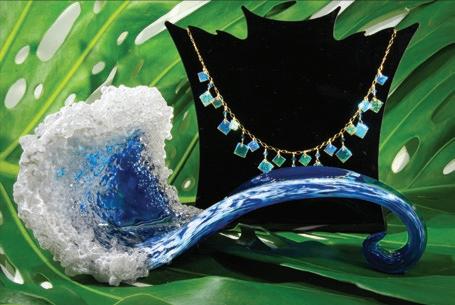
KELA'S GLASS GALLERY
4-1400 Kuhio Highway, Kapa ‘a, Kaua ‘ i www.glass-art.com (808) 822-4527

At Kela’s Glass Gallery, it’s all about the glass art. See for yourself the stunning Color Changing Jewelry by the owner Mimi. This impressive gallery features the works of over 150 fine glass artists. Apparently the specialization works. Kela’s Glass Gallery won the prestigious Top Retailer Award from NICHE Magazine voted on by over 10,000 American artists.

SHAKA GUIDE
shakaguide.com 1-888-250-2261
Turn your phone into a personal tour guide! With 21 self-guided audio tours across Hawai‘i you won’t miss a thing. We’ll guide you to the must-see stops and local gems – all with stories that make the islands come alive. And, when you travel with Shaka Guide, a portion of your purchase is donated to a local nonprofit.

141 EAT / SHOP / PLAY
PROMOTIONAL

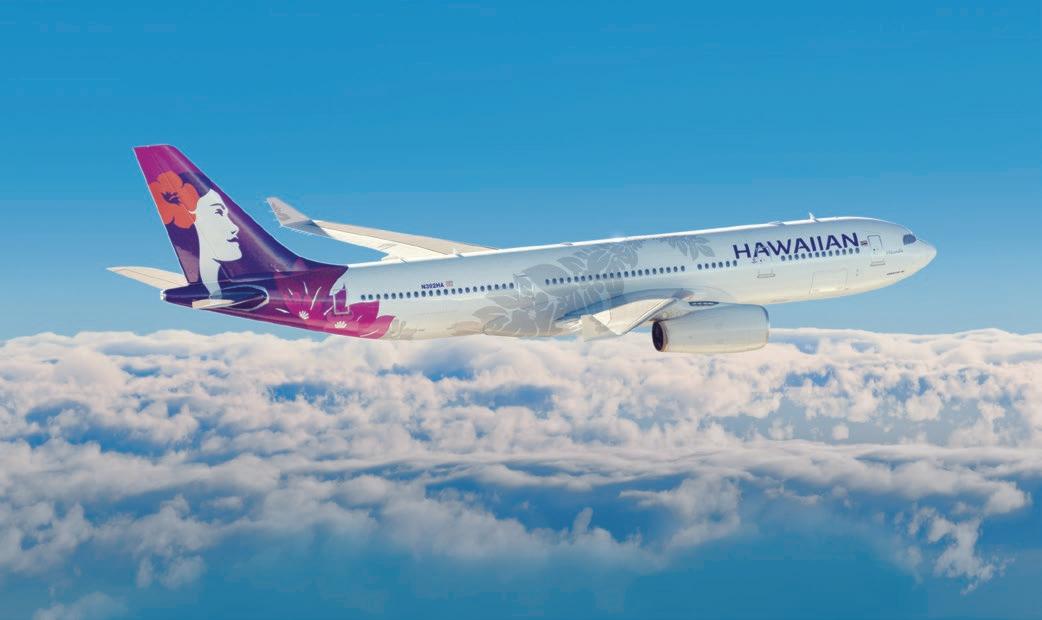
Aloha
Welcome aboard
luana i ka lele ‘ana. E lawelawe mākou iā ‘oe me ka ha‘aha‘a.
In Hawaiian culture, mea ho‘okipa means "I am your host." This phrase expresses the spirit of hospitality you'll find on our flights, whether you're traveling to the Neighbor Islands, between Hawai‘i and North America or within the Asia-Pacific region. If there is anything that we can do to make your flight more enjoyable, please don't hesitate to let us know.
128 / In-Flight Meals
129 / Streaming Entertainment on A321neo Aircraft
130 / In-Flight Snacks, Souvenirs and Beverages
132 / Terminal Maps
134 / HawaiianMiles Partners
136 / Route Map
138 / The ‘Ohana Pages
E
ALOHA FROM HAWAIIAN AIRLINES 143
In-Flight Tastes of Hawai‘i
Delicious Complimentary Meals
It’s true. We’re one of the only airlines left in the country to serve you a complimentary meal at mealtime in the Main Cabin. You’ll find Hawai‘i-inspired meals on select flights to and from Hawai‘i, always served with our unique brand of Hawaiian hospitality.


Above top: Wade Ueoka and Michelle Karr-Ueoka
Bottom: Chuck Furuya
Left to right: Chef Eric Oto of Hoku's at the Kahala Resort and Spa, Chef Robynne Maii of Fete Hawaii, Chef Dell Valdez of Vein at Kaka‘ako, Executive Chefs Wade Ueoka and Michelle Karr-Ueoka of MW Restaurant, Chef Chris Kajioka of Miro Kaimuki and Chef Jason Yamaguchi of Mugen Waikiki.
Hawaiian Airlines Featured Chef Series showcases star chefs
Hawaiian Airlines’ in-flight service shares the sights, sounds and tastes of Hawai‘i, and when it comes to our First Class meal service, that means exciting, varied Pacific Rim cuisine with our Featured Chef Series. This esteemed collaboration showcases some of Hawai‘i’s most dynamic chefs creating menus for meals served in our forward cabin.
The Featured Chef Series is overseen by Hawaiian Airlines Executive Chefs Wade Ueoka and Michelle Karr-Ueoka.
Sit back and enjoy Hawai‘i’s vibrant food culture and our distinct onboard experience.
A taste of tradition
Executive Chefs Wade Ueoka and Michelle Karr-Ueoka opened MW Restaurant in Honolulu in 2013. Their cuisine combines inspirations from travels around the world with Hawai‘i’s culinary traditions and local bounty. To sample MW’s latest creations visit their new location at 888 Kapi‘olani Boulevard in Honolulu.
MWRestaurant.com
Wine pairings by our Master Sommelier
Chuck Furuya has a passion for the world’s oldest fermented beverage and holds the distinction of becoming only the tenth person in the United States to pass the rigorous Master Sommelier examination, in 1988. You can find Chuck at Chuck Furuya Uncorked on YouTube.

HO‘OKIPA
144
In-Flight Entertainment on A321neo Aircraft
Streaming Entertainment to Personal Devices
Guests on our new A321neo aircraft are able to stream complimentary inflight entertainment on their personal electronic devices. We offer a wide selection of movies, TV shows and music as well as Hawaiian Airlines’ own exclusive programming.
Viewing on Smartphone or Tablets
*Supported on iOS 11.2 or higher, and on Android 7.0 or higher.
1. For the best in-flight entertainment viewing experience, please download the Hawaiian Airlines app.
2. Once onboard:
• Switch to Airplane Mode
Connect to one of the following WiFi networks:
• “HawaiianAirWifi”
• “MoviesOnHawaiianAir”
3. After connecting to wifi network, open Hawaiian Airlines app:
• Select More
• Select In-Flight Entertainment
Note: For iOS users, Select “Ok” when prompted to connect your device to Hawaiian Airlines local network. Supported on iOS 11.2 or higher, and on Android 7.0 or higher.
Viewing on a Laptop
1. Connect to wifi signal
• “HawaiianAirWifi”
• “MoviesOnHawaiianAir”
2. Open one of the supported browsers— Google Chrome (ver. 75+), Apple Safari (11.2+), or Firefox (ver. 69+)—and type in URL: HawaiianAirlinesWiFi.com
3. Choose from the menu of entertainment selections and enjoy!
4. Please note: Internet Explorer and Edge browsers are not supported browsers at this time. Supported computer operating systems include MacOS X 10.12-10.14 or Windows 7, 8, and 10 (in desktop mode only)
Having trouble accessing the entertainment? Try these general troubleshooting steps:
1. Is your WiFi signal on? Double-check device settings to ensure airplane mode is on but WiFi is available.
2. Ensure you are connected to the corresponding WiFi network, either HawaiianAirWiFi or MoviesOnHawaiianAir. You may need to disconnect and reconnect to wifi network to re-establish secure connection.
3. On a mobile device, make sure you are using the latest version of the Hawaiian Airlines app.
4. It may be helpful to close and relaunch the Hawaiian Airlines app after connecting to WiFi network.
Mele
Collections to suit your musical tastes
Hawaiian Airlines offers DJ-hosted, curated audio programming devoted to musical styles from across the globe, ranging from award-winning Hawaiian music to jazz and K-Pop.*
FEATURED CHANNELS INCLUDE:
Hawaiian Legacy Favorites
Aunty Genoa Keawe is featured on this exploration of vintage Hawaiian music, with an emphasis on the era just before and after statehood.
Classic Jawaiian Rhythms
The melding of Hawaiian melodies and Jamaican rhythms creates a uniquely Island groove.
Island Favorites
A collection of the best in Hawaiian music, with commentary exclusively in ‘ōlelo Hawai‘i (Hawaiian language) and music by Maunalua, Malani Bilyeu and more.
‘Ukulele Wizards
A celebration of Hawai‘i’s iconic instrument, Kalei Gamiao, Andrew Molina, Gordon Freitas and others.
These and more special audio programs can be found in the Radio category available in our onboard in-flight entertainment systems.
*Available only on A330 and A321neo aircraft.


145 HO‘OKIPA
Andrew Molina (left) and Maunalua (right).
In-Flight
Snacks and Souvenirs

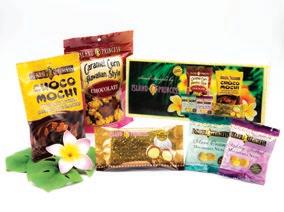
in Hawai‘i Snack Sampler

Pau Hana Snack Cart
Blanket and pillow set, popular local snacks, souvenirs and sundries are available from the Pau Hana Snack Cart. Cabin crew will advise when the cart is heading down the aisle on domestic flights or is open in the galley on Australia and New Zealand flights.
Selections and quantities are limited and may vary. To print receipts of in-flight purchases, visit HawaiianAirlines.com/receipts.
Popular Local Snacks
Mananalu Water in Aluminum Bottle, 16 oz.**
Hawaiian Chip Company Taro and Sweet Potato Chips
Island Princess Caramel Macadamia Nut Popcorn
Kona Chips Furikake Chips
Samurai Furikake Popcorn
Snack Packs*
Made in Hawai‘i Snack Sampler K
Choco Caramel Popcorn, Choco Mochi, Lightly Salted and Maui Onion Macadamia Nuts, Mele Mac
Classic Snack Box GF Crackers, Cookie, Chickpeas, Turkey Stick, Hummus, Gummies
Keiki (Child) Snack Box GF Cheese Puffs, Granola Minis, Turkey Stick, Applesauce, Gummies, Cookie
‘Ono Snack Box GF Salami, Cheese Spread, Dried Fruit, Olives, Crackers, Cookie
Cheese Tray with Crackers and Dried Fruit
Classic Snacks
M & M's Peanut
Maruchan Cup Ramen Chicken
Pringles K
Sundries
Ear Buds with Hawaiian Airlines Zipper Case**
Hawaiian Airlines Blanket and Pillow Set** $3.50
146 HO‘OKIPA
$7.50 $10.00 $8.00 $8.00 $8.00 $7.00 $3.50 $4.00 $4.00 $4.00 $10.00 * Snack box components are subject to availability. Please see snack box for list of included items. ** Available on select North America flights only. GF Gluten-Free K Kosher
$8.00 $6.00 $8.50
Made
‘Ono Snack Box
In-Flight Beverages
Juices
Passion-Orange-Guava* (POG)
Pineapple I Apple I Orange
Mott’s Tomato I
Mr. & Mrs. T Bloody Mary Mix
Hot beverages
Lion Coffee* I Tea
Soft drinks
Coke / Diet Coke I Sprite / Sprite Zero
Canada Dry Ginger Ale
Milk (Lowfat or Whole)
Club Soda / Tonic Water / Sparkling Water
Cocktails
Pineapple Daiquiri** (Kō Hana)
Aviation** (On The Rocks)
Old Fashioned** (On The Rocks)
Signature Mai Tai** (On The Rocks)
Spirits Rum (Koloa Rum)
Vodka (Ocean)
Scotch (Dewars)
Bourbon (Jack Daniel’s)
Gin (Tanqueray)
Hard Seltzer Dragon Fruit** (Maui Brewing Co.)
Koloa Pineapple Passion*** (Koloa Rum)


Bikini Blonde Lager** (Maui Brewing Co.)
provided by
* Complimentary on Neighbor Island flights.
** Available for purchase on Neighbor Island flights.
***Complimentary glass on flights to/from Hawai‘i and West Coast North American cities. $6 per glass thereafter.
All beer, wine, champagne and spirits available for purchase on North American flights. Complimentary in First/Business Class.
Alcoholic Beverages
Only alcoholic beverages provided by Hawaiian Airlines and served by Flight Attendants may be consumed on board the aircraft. No alcoholic beverages will be served to persons who appear intoxicated or to those under 21 years of age.
Hawaiian Airlines' complimentary items may change or vary from time to time, and availability can be affected by aircraft schedule changes.
Beverage menu is subject to change. Some items may not be available on all flights and/or classes of service. Beverage availability is limited. Beers, wines, spirits, snacks and sundries are available for purchase with major credit/debit cards only.
147 HO‘OKIPA
$8.00 $8.00 $8.00 $8.00 $8.00 $8.50 $8.00 $8.50 $8.50 $8.50 $6.00 Wines
Sparkling
Split Red
Split** Red
White
Split** White
Bottle $9.50 $8.00 $16.00 $8.00 $16.00
$8.50 $8.50
& Champagne
Wine
Wine
Wine Half Bottle
Wine
Wine Half
Beers Heineken**
Complimentary beverages



E10 E11 E12 E9 E8 E7 E6 E5 E4 To Gates E1-E3 and Terminal C JetBlue codeshare flights are located in Terminal C B OS I Bo st on Loga n In t erna t io n al Airp o r t Hawaiian Airlines flights use Terminal E 23 D22 D21 D20 D8 D10 D11 D12 14 D56 D57 D58 D D42 D43 D39 D
148
Tram To Terminal 1
L AX I
Proceed through the
transfer security inspection area.
Take the escalator down to the JAL Domestic Transfers bus stop. Exit the bus at Domestic Terminal 1.
• If you HAVE NOT checked in to your final destination at your departure airport, go to the International Transfers Counter just before Immigration.
• All travelers must go to the Security Inspection Area (entrance next to the Transfers Counter) before heading to Departures on Level 3.
• Guests on JetBlue codeshare flights will need to transfer from Terminal B to Terminal 5.
• Please follow the dotted-lined pathway as shown in the map above (minimum 30 minute walk).
Tok yo N ari t a In t e rn ati o nal Ai r p or t TERMINAL 4 Gates 40-49 TERMINAL 5 Gates 50-59 Tunnel Level Tunnel Level 210 (A/B) 208 207 205 203 206 204 202 221 225
NRT I
Hawaiian
209 (A/B) 201 (A/B) Gates 201-225 Third Floor TERMINAL 4
UPPER LEVEL TERMINAL B Gates 130-225
Baggage
to TERMINAL
Basement Level
Airlines flights use Gates 201-225.
Connector
Check-In Third Floor
Claim First Floor
6
Los A n gele s In t e rn ati o nal Ai r p or t 114 148 147 146 145 144 143 142 141 113 112 110 111 109 108 Gates 105 -107 HND
Tok yo Ha n ed a In t erna t io n al Airpo r t INTERNATIONAL TO DOMESTIC
2.
3.
INTERNATIONAL
INTERNATIONAL
I
1. Collect baggage, if necessary, and proceed to Customs clearance.
Check-in at the JAL Domestic Connection Counter on Level 2 .
domestic
4.
TO
For
transfers,
visit HawaiianAirlines.com INTERNATIONAL TERMINAL 3 75 76 77 82 92 94 96 84 86 88 87 85 83 81 91 93 95 97 99 98 74 73 72 71 61 62 63 64 65 66 67 68 TERMINAL 3 TERMINAL 2 TERMINAL MAPS 149 Fourth Floor TERMINAL MAPS
more information regarding
please



HAWAIIAN AIRLINES ROUTE MAP 152

153
The ‘Ohana

Dynamic Duo
Two Hawaiian Airlines employees recently made history by becoming the first mother-daughter pilot team in our ninety-three-year history. On September 1, Captain Kamelia Zarka and her daughter, First Officer Maria Zarka, shared the flight deck of a Boeing 717 for a series of Neighbor Island flights. The duo also personally welcomed guests onboard, took selfies with colleagues and encouraged young girls to follow their dreams.
“Flying for Hawaiian Airlines with my daughter, side-by-side in the cockpit, was
a dream come true for me,” says Kamelia. “I always knew Maria would be a fantastic pilot—she’s always been brilliant and professional—but sitting next to her as she flew the plane with such skill and ease still blew me away.”
Born and raised in the Kingdom of Tonga, Kamelia did not grow up around aviation. She left the archipelago after she finished high school to study public health and social work at Sotra Videregaende Sko in Norway. After returning home to work with the Tonga Red Cross Society, she met Christopher Zarka, a Peace Corps volunteer. The couple eventually married and moved to O‘ahu.
Kamelia joined Hawaiian Airlines as a flight attendant in 1992 and became a pilot in 1999, in the process becoming the first Tongan woman to captain a commercial airline. Maria, who flew with Republic Airlines in New Jersey for two years, was hired by Hawaiian in April 2022.
“She’s an amazing pilot and learning from her is learning from one of the best—now I call her ‘Captain Mom,’” says Maria. “I feel fortunate to have a mother who cares so much and has worked so hard to pave the way. I’m looking forward to continuing her legacy while also making my own mark as a Hawaiian Airlines pilot.”
HAPPENINGS AT HAWAIIAN AIRLINES
154
Pages
Throughout her career at Hawaiian Airlines Kamelia Zarka (left) has broken new ground. Earlier this year she and daughter Maria (right) became the airline's first mother-daughter pilot team.



Keeping It Clean
It’s been three years since the New Zealand Sea Cleaners last set foot in Hawai‘i. Last September, the nonprofit teamed up with Hawaiian Airlines and Hawai‘i Tourism Oceania (HTO) to end its pandemic-forced hiatus. Hayden Smith, who founded the Sea Cleaners in 2002 to protect New Zealand coastlines, gathered ten youth ambassadors—two from Hawai‘i and four each from Australia and New Zealand—to embark on the environmental stewardship experience of a lifetime.
The Sea Cleaners and its youth ambassadors arrived on O‘ahu on September 13 via Hawaiian’s nonstop Auckland and Sydney flights. Over the next four days, the group hosted
educational presentations at schools, cleaned beaches with Sustainable Coastlines Hawai‘i, volunteered with Nā Kama Kai—a nonprofit that focuses on teaching ocean safety, conservation and stewardship to Hawai‘i youth—and engaged in various “voluntourism” experiences through the Hawai‘i Tourism Authority’s statewide Mālama Hawai‘i program.
On September 17, to mark International Coastal Cleanup Day, the ambassadors joined fourteen Hawaiian Airlines Team Kōkua volunteers and representatives from HTO, the O‘ahu Visitors Bureau and the Australian Consulate-General for a clean-up at the James Campbell National Wildlife Refuge. Tucked away on O‘ahu’s northeastern shore, the refuge is a sanctuary for monk
seals, green sea turtles, native plants and a variety of endangered land- and seabirds. But it is also a magnet for commercial fishing nets and other trash that ride ocean currents from throughout the Pacific. In total, the group removed nearly 800 gallons of debris.
“Where the Hawaiian Islands are situated, their shores get inundated with plastic debris from all directions, so it’s bee n an eye-opening experience for many of the ambassadors,” said Smith. “Our intent during this trip was to be good tourists, leave the place better than when we found it and educate these youth from around Oceania so they can share their stories in their own communitie s and help slow the waste stream entering the Pacific in the first place.”
HAPPENINGS AT HAWAIIAN AIRLINES
157
Last September, Hawaiian Airlines’ Team Kōkua joined an international gathering of volunteers to care for O‘ahu’s northeastern shore.

Next Generation, Part 1
Last September 24, as part of the eighth annual International Girls in Aviation Day, sixty Hawaiian Airlines employees volunteered to give forty girls age 12 to 17 a glimpse into possible careers in aviation. The event, organized locally by the Women in Aviation International (WAI) Aloha Chapter, brought students from across O‘ahu to our headquarters, where they embarked on a series of interactive, behind-the-scenes activities.
Throughout the day, each student received one-on-one mentorship from employees who shared their expertise, from maintenance and engineering to flight attendants and pilots. They also demoed exercises in our Boeing 7879 Dreamliner simulator and inflight training facilities, tested tools used daily to maintain our fleet, learned about various corporate roles and heard personal stories of career paths taken by Hawaiian employees.
“I love being able to share my experience, and I think it’s important to the girls to see other women with careers in aviation,” said Elouisa Oki,
manager of engineering at Hawaiian Airlines. “At the end of the day, we want them to know and believe that they can do anything if they set their heart to it. That’s the bottom line.”
Next Generation, Part 2
It is estimated that 610,000 aviation maintenance technicians will be needed over the next two decades to support growth in the global aviation industry. Hawaiian Airlines and Honolulu Community College (HonCC) recently formed an innovative partnership to graduate more local students to meet the soaring demand for these highpaying jobs. Last fall, Hawaiian’s Bill Kinsley and Jason Anderson traded our aircraft hangar for the HonCC campus, teaching classes in the college’s Aeronautics Maintenance Technology (AERO) program. Graduates will have the knowledge and practical skills necessary to obtain a Federal Aviation Administration Airframe and Power Plant Maintenance certification. The new partnership builds on Hawaiian’s Aircraft Mechanic Apprenticeship Program, which launched in 2016 in collaboration with HonCC and the International Association of
Machinists and Aerospace Workers union. Students in the apprenticeship program take HonCC courses during the day while holding a part-time shift at Hawaiian’s aircraft maintenance hangar, where they are paid to perform hands-on repairs and preventative maintenance.
“We are enthusiastic to have our employees share their expertise with Hawai‘i students,” said Jim Landers, senior vice president of technical operations at Hawaiian Airlines. “As we gear up for another growth phase, we also hope HonCC’s graduates will consider joining our ‘ohana so they can enjoy a rewarding career at home, with Hawai‘i’s carrier.”
More information about HonCC’s AERO program can be found online at honolulu. hawaii.edu/post/program/aero/

Double Time
Last year, to provide our guests greater flexibility to earn, save and redeem HawaiianMiles, we eliminated mileage expiration. Now, as a mahalo to our loyal members, throughout December we are rewarding guests who travel between the Islands with double the HawaiianMiles on every flight.
“Each member of our HawaiianMiles program is an extension of our ‘ohana, and we are grateful for their support whether they are a longtime member or a guest who just took their very first Hawaiian flight,” says Avi Mannis, chief marketing and communications officer at Hawaiian Airlines. “We hope that earning double miles that never expire will allow our members to connect even more with family and friends across the state.”
158 HAPPENINGS AT HAWAIIAN AIRLINES
 STORY BY LARRY LIEBERMAN
PHOTO BY ERIKA RICH
STORY BY LARRY LIEBERMAN
PHOTO BY ERIKA RICH
Where the Streets Have Long Names
Sitting on a front porch in the summer breeze, you might feel grateful to live on Keanahalululu Lane.

The street is close to the water and just down the road from an eighteen-hole golf course. Sure, it might be hard to pronounce, and you’d quickly give up on trying to share the address without spelling it out—but the neighborhood is quiet and the neighbors are friendly. Perhaps the most surprising thing about Keanahalululu Lane isn’t that it’s borrowed from Keanahalululu Gulch, which is apparently a surveyor’s misspelling of Keanahalulu, a cave on Hawai‘i Island. It’s that it’s not in Hawai‘i at all.
Keanahalululu Lane and its neighboring streets—like Waipahoehoe Drive, Kaukonahua Lane and Waikiakaaua Drive—are in Bastrop, a Texas town on the Colorado River. Adding to the geographical confusion, they’re part of a planned community built in the 1970s called “Tahitian Village.” In the fast-growing town of Bastrop, this legacy subdivision sports more than two hundred streets with Hawaiian names. With some as long as seven syllables, the developers definitely went big, even for Texas.
“It all started when my dad went to Hawai‘i for a golfing vacation,” says Michael Marlowe, son of the late Robert
Marlowe, who was an engineer and land surveyor for a real estate development group whose members included former Motion Picture Association of America president Jack Valenti. One of Marlowe’s tasks was planning and naming the roads on a swath of former ranchland thirty miles southeast of Austin. “Dad came home with Hawaiian maps and guidebooks and dictionaries. He was really into it, and loved the Islands.”
Marlowe wanted to create a golf resort community along the Colorado River with a relaxed atmosphere similar to what he’d experienced in Hawai‘i. “I remember all of us sitting at the dining room table as he walked through the developer’s map, figuring where the streets would go and what he could call them.” A half-century later, residents of Tahitian Village (as it was later named, likely by “someone in marketing,” says Michael Marlowe) number in the thousands.
With the exception of a few quintessential American classics like Riverside Drive and Lover’s Lane, the winding roads of Tahitian Village read like a Hawai‘i street map. Some residents, like those living on Diamond Head Drive or Puna Lane, got off easy.
Others, like those living on Mokuauia or Kaohikaipu, not so much. But they take it in stride and don’t expect folks—including themselves—to spell or pronounce the names correctly. To complicate matters, the street signs in Tahitian Village don’t include the ‘okina, the mark for the glottal stop that gives people unfamiliar with ‘ōlelo Hawai‘i (Hawaiian language) a little help navigating long words.
The difficulty of the Hawaiian names hasn’t put a damper on growth in Tahitian Village, where the relaxed lifestyle is in demand. “Houses have been springing up fast on empty lots that some people from out of town just bought up sight unseen,” says Jessica Zamora, who’s lived on Koele Court for around three years. She knows plenty of new residents who struggle with pronunciation as well as some who’ve lived in the neighborhood for decades and still don’t even try. “Koele’s not too hard compared to some of the longer names,” Zamora admits. “But I still lose mail. I have to remind FedEx so they don’t deliver to Koali across town by mistake instead of Koele. If my regular driver’s on vacation, I don’t get my packages.”
Challenging names and confusion among similar-sounding streets like Upola and Upolu or Kukui and Kuikui have caused headaches for emergency responders and GPS systems for years (just go for a drive and listen to Google Maps’ voice assistant tie itself in knots). A handful of street names have had to be changed to mitigate navigation problems, but most of the people in Tahitian Village appreciate the uniqueness of their community and like the street names just the way they are.
“I love it here,” Zamora says. “It’s beautiful and peaceful. But when I have to give directions or tell someone my address, I just usually say, ‘Go to the Colorado River Refuge sign next to the river and take a right.’” hh
160
PAU HANA









 BREAKING GROUND / Meet Jack Rabanal, a.k.a. HIjack, the “b-boy” who reps Hawai‘i at breakdancing competitions in the Islands and abroad. PHOTO BY ADAM AMENGUAL
BREAKING GROUND / Meet Jack Rabanal, a.k.a. HIjack, the “b-boy” who reps Hawai‘i at breakdancing competitions in the Islands and abroad. PHOTO BY ADAM AMENGUAL

















 STORY BY KATHY MUNENO PHOTOS BY ELYSE BUTLER
STORY BY KATHY MUNENO PHOTOS BY ELYSE BUTLER



 STORY BY KATIE YOUNG YAMANAKA
STORY BY KATIE YOUNG YAMANAKA





 STORY BY MARI TAKETA
STORY BY MARI TAKETA





























































 PHOTOS BY TOMMY PIERUCKI
PHOTOS BY TOMMY PIERUCKI




































































 Pearl Harbor Parade
Pearl Harbor Parade




















































































 STORY BY LARRY LIEBERMAN
PHOTO BY ERIKA RICH
STORY BY LARRY LIEBERMAN
PHOTO BY ERIKA RICH


